

Best time to visit Peru: A Month by Month Breakdown
Peru is located close to the equator, and given its tropical climate, the country experiences very distinct weather patterns throughout the year. Rather than having a traditional four seasons, Peru’s main seasons are simply wet and dry.
November to April is when Peru experiences the most rainfall, and this also tends to be the low season. The Inca Trail and other popular sites can close completely, while traveling in the Amazon and remote, rural areas can be dangerous. In the wet season, it’s hot and humid, and at times the weather can be unbearable.
May to October is when the country enjoys its dry season, and this is always the best time to visit Peru. The weather is hot and sunny, and you can hike, hit the beaches and enjoy the best sights and attractions in glorious sunshine, but just remember that it’s also going to be busy.
To inspire your trip to South America, here’s the best time to visit Peru!
Don’t leave home without: Lonely Planet Peru (Travel Guide)
Best Time to Visit Peru: A Month by Month Breakdown
Table of Contents
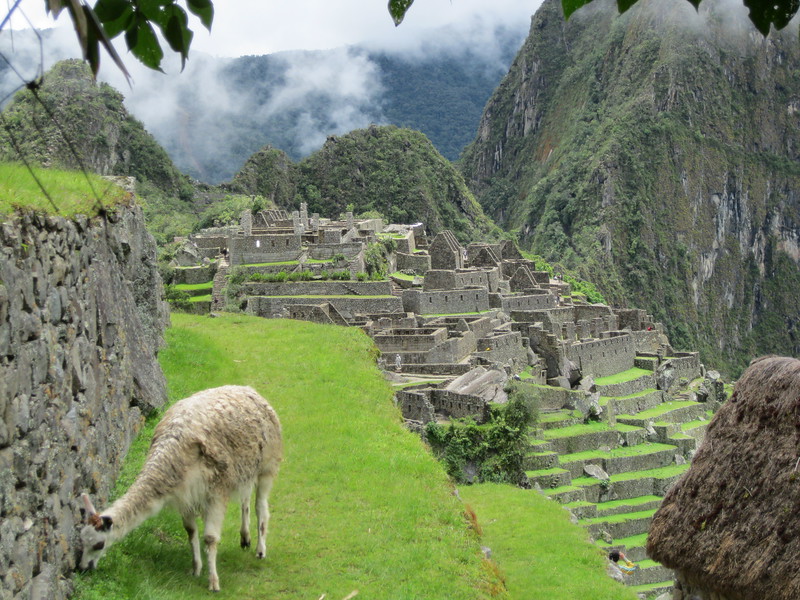
Visiting Peru in January
The start of the year is the middle of the rainy season, and it’s not necessarily the best time to visit Peru. This is the height of summer, and the country is lashed with rain throughout January.
It’s hot, it’s sticky and it’s humid across much of the country, and particularly in the Amazon and around Cusco, but head to the coast and things are very different.
This is a good time to visit the capital, Lima, where you can enjoy hot weather but, as this is one of the driest places in South America , even though it’s the rainy season you won’t see much rainfall at all. You can enjoy the beaches and even go swimming in the Pacific Ocean.
Across the country, it’s a quiet time to be in Peru, as this is certainly not high season, and if you do brave the rain then you can see plenty of Inca ruins without the crowds that follow in the dry season.
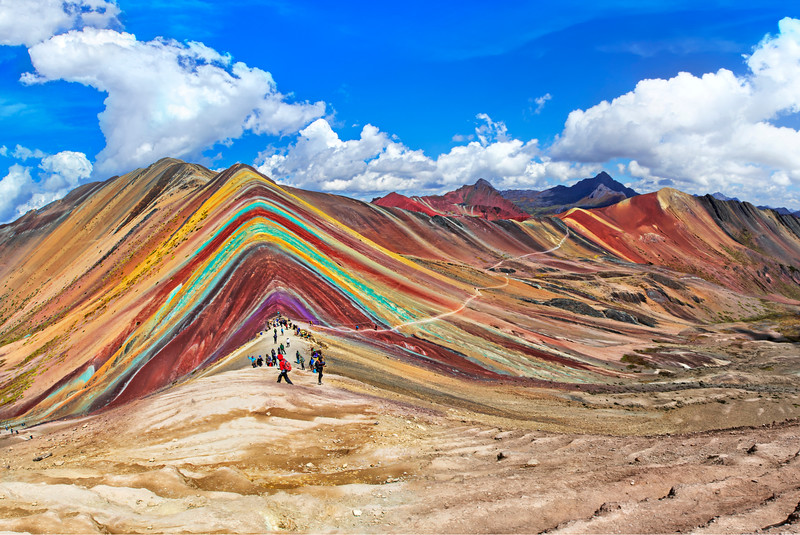
Visiting Peru in February
The rainy season counties into February, and unfortunately, this is again not a good time to be in Peru if you want to see all the traditional tourist sites.
The Amazon is still hot, humid and sticky and there’s a huge amount of rainfall throughout the month. If you aren’t used to such conditions, then it can become unbearable fairly quickly.
In the highlands, the rainfall also continues and this is one of the wettest months of the year. Given that most first time visitors to Peru want to visit Machu Picchu and hike the Inca Trail to this iconic mountainside ruin, February is not a popular time to visit, because the Inca Trail is often closed for renovation and maintenance during February.
If you do want to visit Peru in February though, then you’ll have the country to yourself but you might want to stick to the drier coastal and desert regions rather than heading inland.

Visiting Peru in March
You still haven’t escaped the rainy season yet, and in March there are still high levels of rainfall across the country. March is the end of summer, and from here on the temperatures start to drop, although, given Peru’s equatorial location, temperature differences can be minimal.
In the highlands, temperature changes are more marked, and the rain begins to lessen and the humidity drops. In Lima, you can enjoy the last of the wonderful summer sun and almost no rainfall, as you can in the desert regions too.

Visiting Peru in April
In April, you can still expect rain, but this is the last month of the rainy season. You’ll experience a few showers, but the humidity is markedly less and the weather is not quite as hot.
In fact, it can be the best time to visit Peru if you want to experience the country without the crowds and still enjoy good weather. April usually sees the celebration of Holy Week, a great cultural experience to be part of, although a time when all buses and planes are bound to be busier than usual, as locals travel to visit family.
The highlands are beautiful in April, and although Machu Picchu and the hiking trails are very much open for business, there are few other people around.

Visiting Peru in May
May is the start of the peak tourist season in Peru and after a long rainy season across much of the country, the visitors begin to arrive in large numbers.
This is the end of the wet season and the start of the dry season and it could be the best time to visit Peru. The highlands around Cusco are beautiful in May, as the scenery is lush and green from the rains but the sun is shining.
You’ll be able to hike through the Sacred Valley and along the Inca Trail, as the now mild temperatures offer optimal hiking conditions.
In Lima, things are, as always, dry and you’ll find that the coast is now cooling down considerably. It’s warmer than the highlands but you might not want to go swimming in the Pacific Ocean this time of the year.
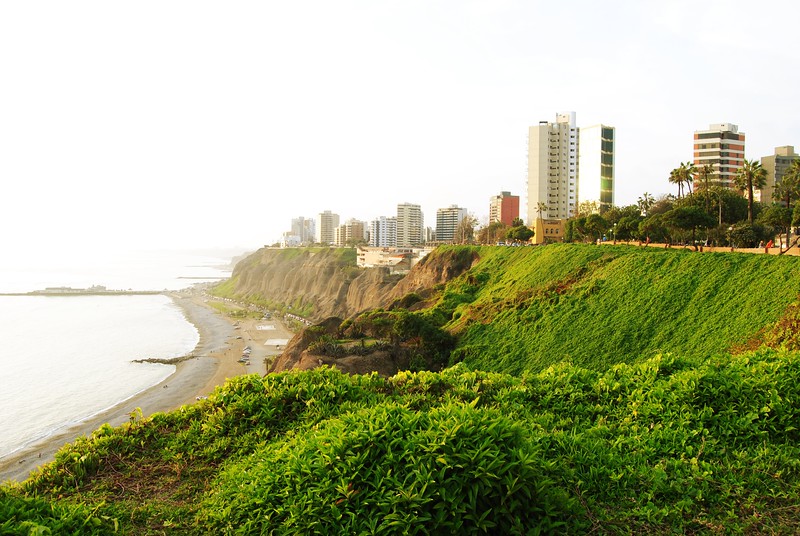
Visiting Peru in June
June is when things begin to get busy in Peru as the rains are over and the tourists are arriving. Temperatures are still hot, especially along the coast and in the Amazon, and this is your last chance to see the most popular attractions before the crowds arrive next month

Visiting Peru in July
When it’s July, the peak season is in full swing and while this can be the best time to visit Peru in terms of the weather, it can also be incredibly crowded.
There’s no rain in Peru in July, but as this is winter, you will find that at night it can get cold, especially in the mountains at altitude and in the desert at night.
Conditions for hiking trails are perfect, but you will want to make sure that you book in tours to places like Machu Picchu in advance as there are only ever a limited number of permits issued and spaces fill up quickly.
If you want to escape the crowds consider traveling the lesser-known trails in the highlands rather than visiting Machu Picchu.

Visiting Peru in August
August can be very busy, and if you want peace and quiet then this is not the best time to visit Peru. The weather is dry and skies are clear, and although temperatures can get low at night, they still hit the pleasant heights of the mid-twenties in most destinations during the day.
If you’re visiting the touristy spots, then just like in July, make sure you are booked well in advance. Much of the world has school holidays and summer breaks in August and that brings in large numbers of tourists to Peru.

Visiting Peru in September
After the rush of July and August, things wind down a little in September but the most iconic spots are still definitely going to be busy.
It’s still dry and it’s still warm in September, and actually, after this, the transition to summer begins again.
This is a fantastic time to be in the Amazon, as the weather is beautifully cool in comparison to the approaching summer and at the end of the dry season, you’re more likely to spot wildlife. With less vegetation around, animals congregate in more visible areas and have fewer places to hide in the jungle.

Visiting Peru in October
October is the last month of the dry season or the first month of the rainy season. The weather can be unpredictable.
It’s the best time to visit Peru before the full force of the rains hit the highlands and the Amazon, so head to the mountains or to the jungle to make the most of the October weather.
Towards the end of October when rain is more likely, head to the coast and to Lima, where things are heating up again before summer begins.

Visiting Peru in November
November is the real start of the rainy season in Peru, and the start of summer too. It’s hot along the coast, it’s humid in the Amazon and it’s getting warmer and rainier in the mountains.
If you don’t mind a few downpours interrupting your trip, this is a great shoulder season month, and it can be the best time to visit Peru if you want a quieter trip.
It’s your last chance to visit the Amazon and to see the wildlife before the rains get heavier, and spotting animals in the dense bush becomes more challenging.

Visiting Peru in December
December can be a busy time for travel in Peru , given that this is the Christmas period, and although the weather might not be optimal it can still be popular.
Head to the coast of Peru to catch the summer weather and to enjoy a hot Christmas on the beach, or head up to the mountains where you can still tackle the hiking trails and see the iconic Inca ruins in all their glory.
It’s a great time to visit Peru, as there’s always a festival or celebration happening in December, no matter where exactly you might find yourself in the country!
Our Top Recommended Peru Tours:
- Explore Northern Peru & Machu Picchu with National Geographic Journeys – 16 days
- Explore Northern Peru with National Geographic Journeys – 9 days
- Explore Machu Picchu & The Amazon River with National Geographic Journeys – 11 days
- Amazon Riverboat Adventure with G Adventures – 7 days
- The Lares Trek with One Day Inca Trail with G Adventures – 8 days
More on Peru:
- 11 Cool Things to Do in Peru + Planning Tips
- From Cusco to Machu Picchu: Everything You Need to Know
- How to Visit the Amazon in Peru
- Wasai Tambopata Lodge in Peru: Lodge Review
- Unforgettable Amazon with the Tambopata Research Center
- Posada Amazonas: Where Culture Meets the Amazon
Did you like this story? Share it!
Travel planning resources, about david stock.
I have always been an outdoorsman so becoming an adventure traveler was just the next natural step. I love nature, I love to get off the beaten path and I like to explore. I enjoy scuba diving and cars. And yes, Lina and I have a naked dog.
Leave a Comment Cancel reply

Dos Manos Peru Travel
Dos Manos Peru Travel Blog
Exploring peru, when is the best time to visit peru a month-by-month guide.

The best time to visit Peru depends completely on which part of the country you plan on exploring. Peru can be divided into three main areas when it comes to the country’s average climate: the coast, the Amazon Jungle and the Andes Mountains – the latter of which being the location of Machu Picchu. When is the best time to Visit Peru? A month-by-month Guide.
As a result, it’s hard to give an exact idea of the average weather in Peru as it varies significantly across the country; this country covers around 1.285 million square kilometres, making it just a bit smaller than the state of Alaska.
But there are distinct variations in weather and temperatures between the different parts of Peru, meaning there are certain months when it’s better to visit a particular region.
Weather in Peru month by month
We’ve broken the average weather and temperatures in Peru down into the different months of the year to give you a real sense of when is the best time of year to go to Peru – all depending on the type of activity you’re hoping to do.
Note that the rainy season in Peru lasts from December through March, with most rainfall in the Andes Mountains and the jungle, while winter, when temperatures drop, particularly at night, is from June through August.
Peru weather in December through March
December through March in Peru is considered the rainy season. You can expect high rainfall in the Andes Mountains, peaking at 144mm in and around Cusco. This isn’t a great season to visit Machu Picchu, particularly as rainfall can make many of the more challenging hikes to the Inca site, including the Salkantay, Lares and the extension of the Choquequirao trek , dangerous, with many operators choosing not to run tours from the start of January.
Peru in February is also not a great month if you plan to visit Machu Picchu via the Inca Trail , as the path actually closes for the entire month (although Machu Picchu remains open).
Further north in the Amazon Jungle , rainfall is even greater, with levels of up to 278mm in Iquitos. This means boat travel around the jungle is easier because the rivers are fuller, but there’s an increased risk of mosquitos.

However, in December, January or February, the coast is a winner. Lima in December and January has some of its most pleasant weather: temperatures peak at around 25˚C (77˚F), matched with humidity levels of around 81% (the lowest in the year), making this a good month to visit the Peruvian capital.
Other coastal towns including Huanchaco, Mancora and Punta del Sal, experience peak tourist season during these months – and you can expect price hikes on accommodation and beaches full to bursting with bronzing tourists.
Peru weather in April through May
Marking the start of the Peruvian shoulder season, April is when the showers stop and the dry season creeps back in, making it an excellent time for trekking in the Andes Mountains – including to Machu Picchu or Rainbow Mountain .
Temperatures along the coast and in Lima in April and May see a slight drop to an average of 23˚C (73˚F) in the capital, although humidity increases – so be sure to drink plenty of water if planning to visit the city.
Elsewhere in the mountains, it’s perhaps the best time to visit Peru because you can expect less footfall on famous hikes, such as the famous Inca Trail , than in the coming months and temperatures are still warm, hovering around 19˚C (66˚F).
The weather in the Amazon Jungle in April and May bucks the trend of the rest of Peru with heavy rainfall (the highest in the entire year), although a slight drop in humidity makes this a good time for trekking and other active jungle adventures in and around Iquitos. The chances of spying endemic wildlife swimming in the swollen river waters is also high.
Peru weather in June through August
The peak months for travel in Peru, June through August see the driest weather in Peru – which, coinciding with summer holidays in the northern hemisphere see crowds of tourists at sites such as Machu Picchu. Be aware that nights can get cold, particularly at altitude in Cusco and Huaraz , so you’ll want to pack some warm clothing for this season.
If you want to escape the crowds, it’s still a good time to visit coastal Peru, with Lima in June and July experiencing warm, slightly humid weather, with temperatures hovering around 19˚C and matched with plenty of sunshine.
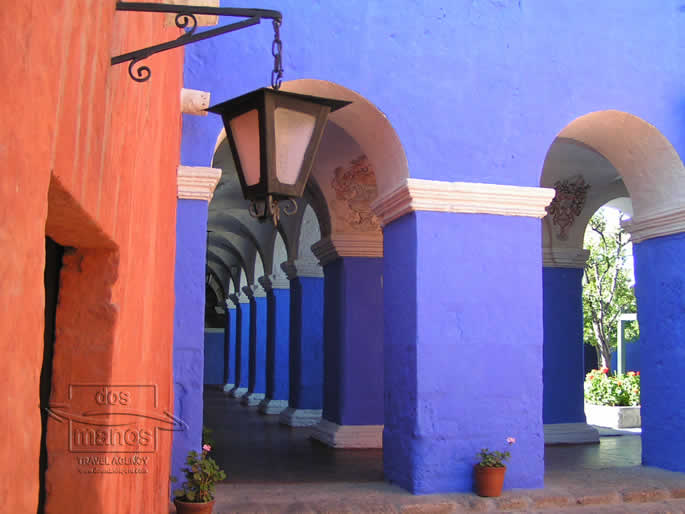
Further north up the coast, temperatures in vibrant beach town Mancora are still at a balmy 26˚C (79˚F), combined with warm waters and far fewer other beachgoers than in the peak months of summer, making this period an excellent window for a visit.
June, July and August in the Amazon Jungle see some of the lowest periods of rainfall, although this generally doesn’t affect your chances of heading deep into the rainforest by boat and often means you can actually explore further into the undergrowth because of the land that is uncovered when the waters recede. It’s also low season for mosquitos – a handy thing if you’re prone to being bitten.
Peru weather in September through November
The other shoulder season lands in the months of September, October and November, when temperatures across the country start to increase and tourist numbers decrease – making this one of the best times to visit Peru.
Rainfall is a possibility in Cusco in October and November, although these months remain excellent for trekking to Machu Picchu, particularly as the warmer weather means nights at altitude aren’t quite so cold. However, cloud coverage can potentially spoil some of your photos – although the risks are still minimal.
Along the coast, temperatures pick up to a pleasant springtime 22˚C (71˚F) in Lima in November, with decreasing humidity making it a good time for exploring the capital city, as well as other coastal locations.
In the jungle, rainfall is still low, allowing for trekking through the rainforest, as well as boat trips along Amazon tributaries .
Planning a trip to Peru? Check our overview of complete Peru Tours including sample itineraries .
Do you want to read this article in Dutch?
Wanneer is de beste tijd voor een reis naar Peru?
Do you want to read this article in Spanish?
¿Cuándo es la mejor época para visitar Perú? Una guía mes por mes
Leave a Comment Cancel Reply
Your email address will not be published. Required fields are marked *
Save my name, email, and website in this browser for the next time I comment.
When is the best time to visit Peru?

Nov 6, 2023 • 5 min read
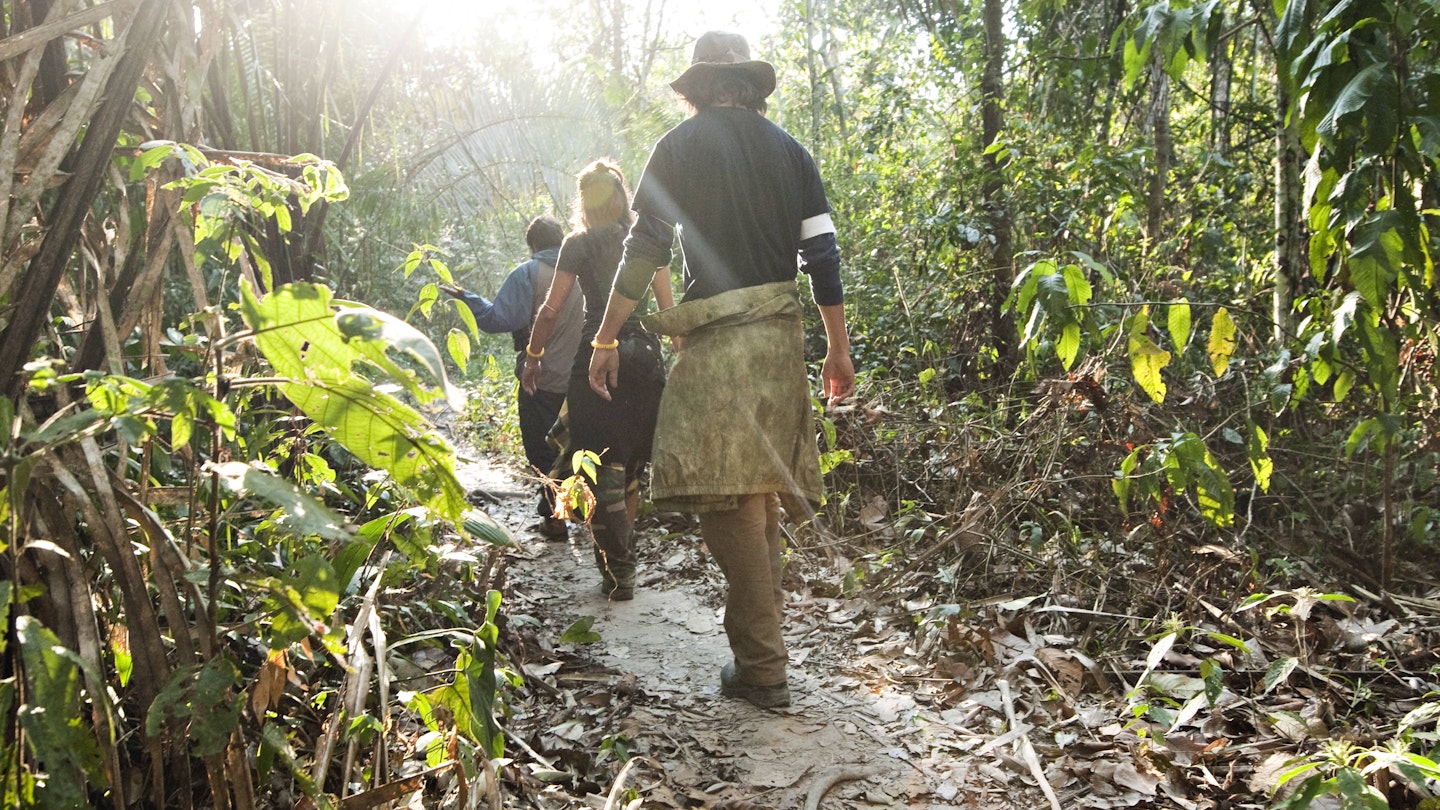
Whether you're a foodie stopping in Lima or an adventurer heading for the Inca Trail, your perfect Peru vacation starts here © R. Tyler Gross / Getty Images
A sizzling strip of coastal desert. Endless snow-capped Andean summits. A humid expanse of rainforest mazed by mighty rivers. These three types of terrain form a triumvirate of completely different climates, ensuring there is no bad time of year to visit Peru .
This is a tradition-entrenched, festival-focused land, with at least one vibrant celebration a week to add color to your trip. Whether you're a city lover stopping in the famous foodie capital of Lima or an adventurer heading for the Inca Trail, you'll find what you need to plan your perfect Peru vacation here.
June to August is the best time for Andean and Amazonian adventures
Most Western travelers prefer Peruvian winter. This isn't only because it coincides with their main holiday period, but because the crystal-clear weather casts the Andes , where the country’s most popular tourist sights beckon, in sharp sunlight.
Fascinating festivals also occur, and the tantalizing trekking ground is dry underfoot. Adventure season is in full swing.
The ancient Incan capital of Cuzco grabs the most attention, along with the nearby Sacred Valley , where picturesque, Inca-ruin-dotted gorges invitingly thread through to the greatest site of them all: Machu Picchu .
The big treks – especially the Inca Trail , but others in Sacred Valley and those in snow-bedaubed Cordilleras Huayhuash and Blanca – are also irresistibly beautiful in the brilliant sunshine, but it's peak hiking season and they do get very busy.
June brings an array of fabulous fiestas, which enliven thoroughfares in Cuzco and other regional towns on a near-daily basis, the most notable being Inti Raymi, an Inca celebration of the winter solstice.
Further south down the Andes, Lake Titicaca glitters like a blue jewel, with tempting tradition-rich islands. The Selvámonos festival kicks off in Oxapampa at the end of the month and its live music and cultural celebrations are a wonderful way to spend a week in the valley.
It's dry season in the Amazon Basin too – July is as dry as it gets in the Amazon, even though it's never truly dry there! The sunnier weather in the cloud forest lures birdlife out into the open, including the bright orange-red Andean cock-of-the-rock, Peru’s national bird, which mates at this time.
Down in the low jungle, wildlife is easier to spy than on the riverbanks, and forays down rivers like the Tambopata, near Puerto Maldonado , yield especially diverse sightings.
Lower water levels mean excellent whitewater rafting conditions: the Apurimac, near Cuzco, and the Tambopata are ideal for rapids-riding. Locals take to the streets in Paucartambo in mid-July to celebrate La Virgen del Carmen with music, dancing and colorful costumes – it's like a mini Mardi Gras.

September to November is best for quiet hikes and surfing without crowds
It's shoulder season everywhere, particularly in the Andes, where clear sunny days linger through September. For trekkers who prefer to have the mountains to themselves, this is the best time to go – utter solitude beckons on many hiking routes .
The Inca Trail is always well-trodden, but alternatives such as the Salkantay Trek, where you traverse a 4630m (15,190ft) pass loftier than any point on the Inca Trail, allow you to lose the crowds.
September also marks the end of the jungle’s dry season, so it's a good time to try rainforest trekking or wildlife-watching on a boat trip from Iquitos or Puerto Maldonado before the spring rains descend and make travel trickier.
As the action in the interior decreases, it's pre-peak season on the coast. Toward late spring, the thick garúa (coastal fog) that's been enveloping Lima since July begins to lift, but it's still worth visiting Peru’s dynamic gastronomic capital earlier.
Temperatures are rising along the country’s sandy beaches, but the masses have not yet checked in. By November, waves at Peru’s best surfing spots – including the home of the planet’s longest left wave at Puerto Chicama – are approaching their cresting best.
Día de los Muertos is celebrated all over the country at the start of the month. Though this occasion is about loved ones who have passed away, the atmosphere is anything but somber – it's a celebration of love and life.
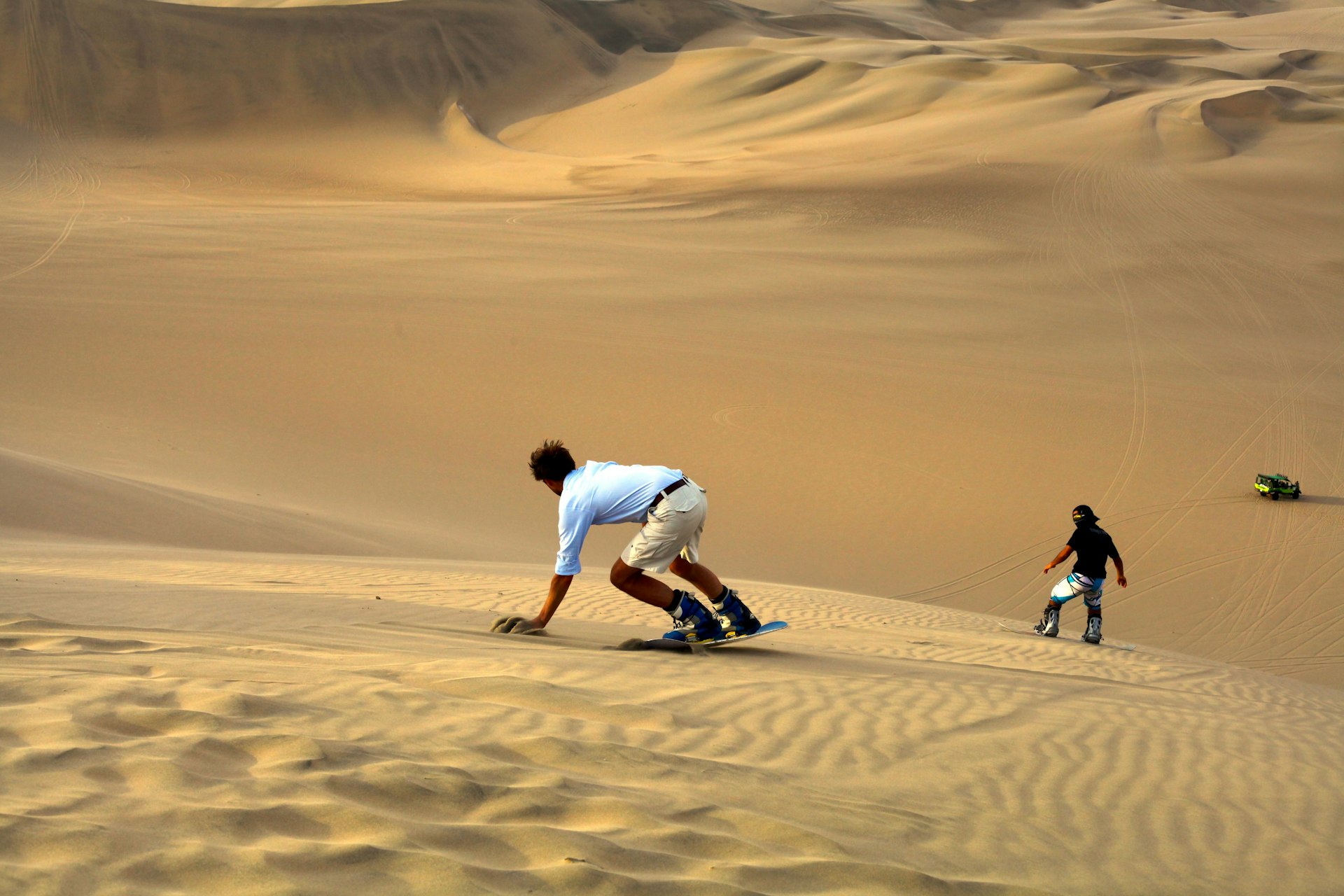
December to February is the best time for beach lovers
This is the season to see Peru’s magnificent beaches at their best. Sunbathing on the searingly warm northern beaches is delightful – temperatures routinely hover in the 30°C to 40°C (86°F to 104°F) realm, and crowds flock to see-and-be-seen resorts like trendy Máncora .
Cusco hosts the biggest celebrations for the Feast of the Immaculate Conception on December 8 – a national holiday in Peru.
It's peak surfing season too. But for a different coastal experience, take a boat trip to the rarely glimpsed mangrove forests near Tumbes, or to the rocky sealife sanctuary of Islas Ballestas near Paracas, where sea lion pups are born in January.
From Paracas, it's a straight shot inland to Peru’s most colossal dunes at Huacachina – sandboarding down is the coastal region’s greatest adrenalin rush. Lima is largely garúa -free, so capitalize and try activities like paragliding over the city.
Inland, the wet season is at its height, and the Inca Trail is closed through February. Carnaval kicks off at the end of February and Latin America's biggest party is celebrated in style across the entire country.
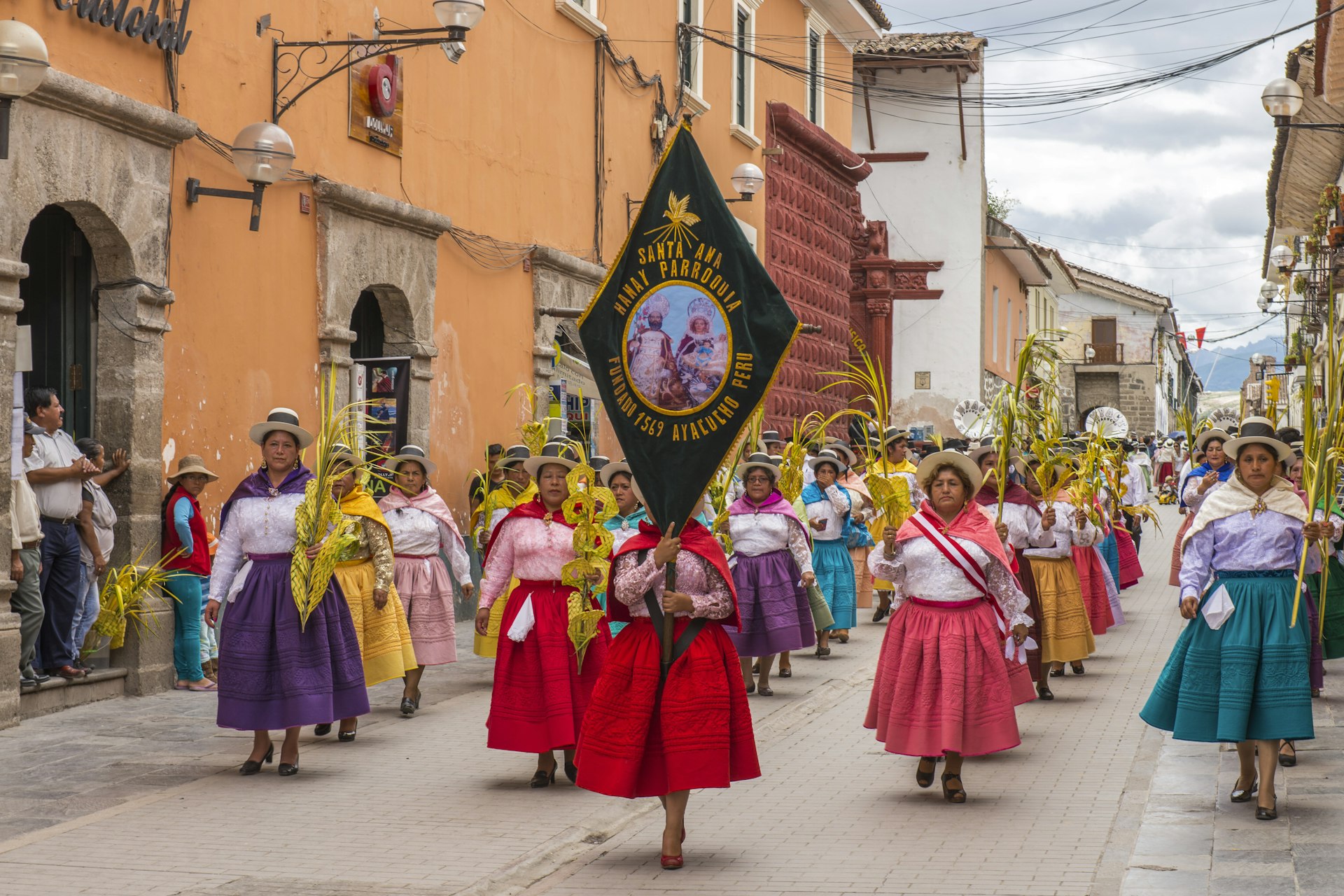
March to May is best for budget travelers and festival fanatics
With the exception of the riotous pre-Easter revelry of Semana Santa (Holy Week), this is a wallet-friendly time to visit Peru. Summer’s manic crush of visitors is over, the coast retains pleasant weather through March and deals can be struck as popular spots try to eke out their custom.
Carnaval season in Peru continues from February into March with an explosion of color and celebrations everywhere.
It's not yet high season in the Andes or the Amazon, despite increasingly sun-kissed weather and bursts of bewitching greenery tinting the slopes, so accommodation and tours will be well below high-season tariffs.
The coastal strip entices as grapes ripen to the picking point, erupting in Ica’s wine-harvesting celebration, Fiesta de la Vendimia, in the second week of March.
Up in the mountains, against a canvas of steadily improving dry, bright weather, May can rival high season in terms of eye-popping festivals.
Marvel at the spectacle of El Señor de Muruhua y, one of South America’s biggest pilgrimages held near Tarma, or the intriguing religious celebration of Fiesta de las Cruces, in cities like Cuzco, Ayacucho, and Lima.
This article was first published March 2021 and updated November 2023
Explore related stories
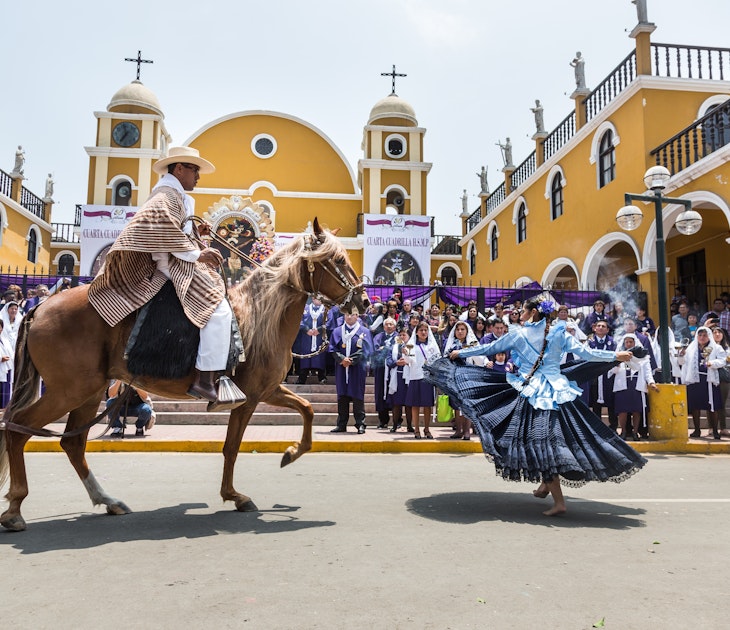
Festivals & Events
Nov 15, 2023 • 4 min read
Whether you're visiting Lima in its own right or using it as a stopover en route to Cuzco and the Andes, this is when to go.

Jan 2, 2023 • 12 min read

Mar 2, 2024 • 8 min read

Jan 23, 2024 • 4 min read
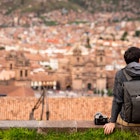
Jan 10, 2024 • 6 min read
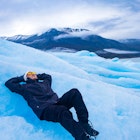
Jan 8, 2024 • 11 min read

Jan 2, 2024 • 7 min read

Jan 2, 2024 • 11 min read

Dec 27, 2023 • 8 min read

Dec 14, 2023 • 3 min read
Change location
- UK / International
- Call toll-free until 8pm EDT 617-223-4521 617-223-4920 or
- REQUEST A QUOTE
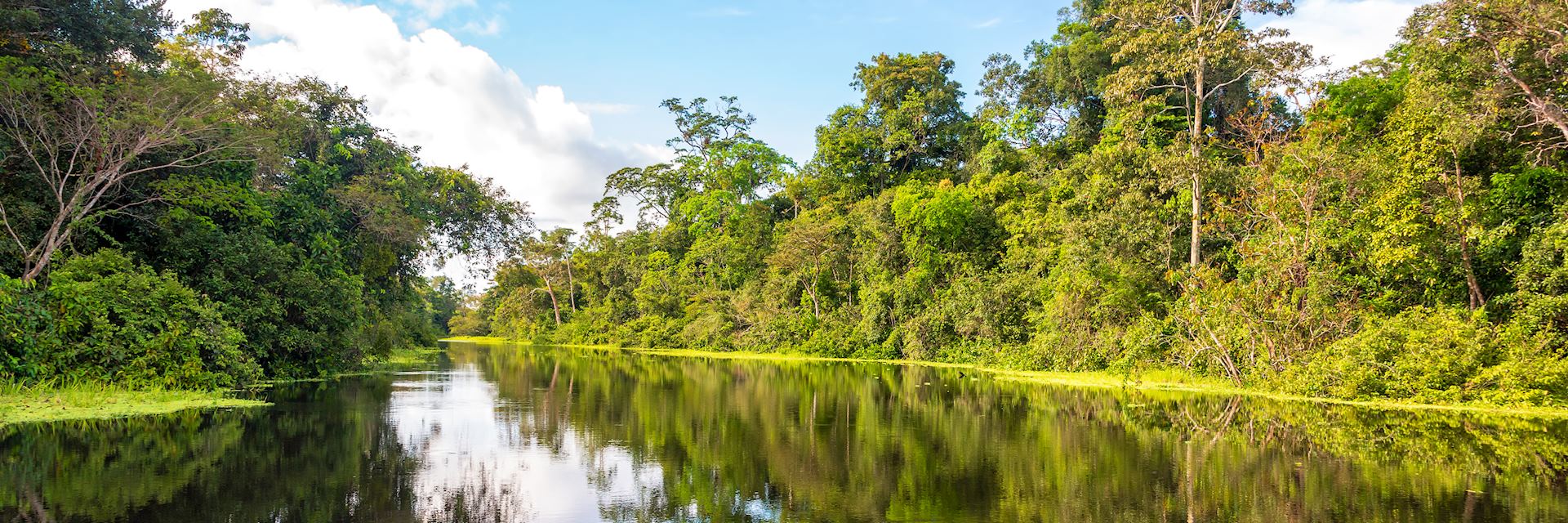
When is the best time to visit Peru?
- The Southern Amazon
- Month-by-month
The best time to visit Peru is during the dry season between May and October, especially if you plan to go on a trek. It is a wonderful time, with sunny days and bright blue skies, but early booking is crucial because it’s the peak season.
Visitors will notice more rain between November and April, with the wettest months being January and February. Travel at this time does offer the advantage of fewer visitors, greener scenery, and some lower rates for flights and hotels.
The climate in Peru does vary slightly from region to region. It’s cooler in the coastal areas, where temperatures range from 68°F to 80°F, and Machu Picchu, which has a year-round average of 66°F to 68°F. The Amazon experiences warmer weather (84°F to 91°F) and sees more rain between November and March. This should not deter you from visiting — the flora and fauna will still be abundant and there are always breaks in showers.
- Make an inquiry
- Request a brochure
Month-by-month guide for traveling in Peru
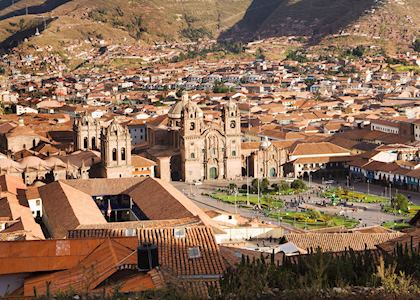
Visiting Peru in January - April
The wettest time to visit the Andes and the Amazon, with the Inca Trail closing for the month of February. Travel is still possible however, and Machu Picchu remains open — it will just be more challenging for those wishing to trek. As February ends, the Inca Trail re-opens and more visitors begin to arrive; particularly as Easter approaches. This is also a popular period to visit for those wishing to combine Peru with a visit to the Galapagos Islands .
Events & Festivals
- Feast of the Virgen de la Candelaria: This is celebrated over a two-week period with folkloric music, dance and spectacular costumes in the town of Puno on the shores of Lake Titicaca.
- Holy Week (March/April): Holy Week brings somber religious processions to Peru’s towns and cities; particularly notable in Cuzco. Cuzco.
- The feast of the Three Kings (6th January): This feast is celebrated across Latin America, but Ollantaytambo in the Sacred Valley is a wonderful place to be. During the ‘Bajada de los Reyes’ the town is overtaken with jubilant processions, music, and dance. Find out more about the Sacred Valley.
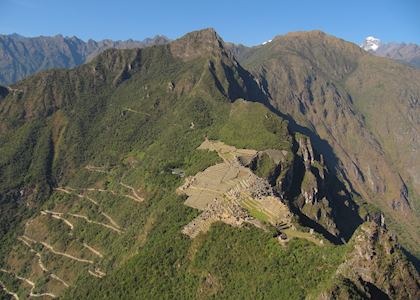
Visiting Peru in May - September
As the rains in the Andes cease, visitors can enjoy warm, sunny days and chilly, crisp evenings at altitude. This time of year lends itself to enjoying all the attractions Peru has to offer, from admiring Machu Picchu in the sunshine, to enjoying a boat trip on Lake Titicaca under vivid blue skies and trekking against backdrops of snow-capped mountains. Those wishing to travel from June onward should start their planning six to nine months in advance, and up to 12 months in advance if you wish to trek the Inca Trail but have a limited travel window.
- Inti Raymi (June): A month of festivities in Peru, many building up to the Inti Raymi (Festival of the Sun) toward the end of the month. Our favorite alternative festival is Corpus Christi, which falls on the ninth Thursday after Easter. Experience it in Cuzco.
- Santa Rosa de Lima (August 30): Lima’s patroness is honored with a public holiday and procession to Lima cathedral.
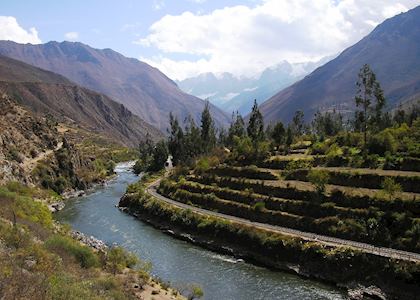
Visiting Peru in October - December
The dry season comes to an end, but conditions are still pleasant. An abundance of birdlife and flora, particularly orchids, can be enjoyed in Peru’s cloudforests at this time. Although water levels in the Amazon will be high from December to March, meaning fauna may not venture as close to the river banks, this does offer the advantage of easier exploration of smaller tributaries which are sometimes inaccessible in the drier months.
- Santurantikuy Market on Christmas Eve is a wonderful experience, with vendors from the high Andes arriving to sell grasses and plants for the nativity manger, and children queuing for hot chocolate in Cuzco.
Peru Climate Guide
Why travel with audley.
- 100% tailor-made tours
- Fully protected travel
- Established for over 25 years
- 98% of our clients would recommend us

Travel advice
Practical tips for traveling to Peru, from social protocols to guidance on money matters, with a link to the latest US State Department travel advice.

Request our brochure
Covering all seven continents, The World Your Way shows you how you can see the world with us. It features trip ideas from our specialists alongside hand-picked stays and experiences, and introduces our approach to creating meaningful travel experiences.
Trip ideas and travel guides for exploring Peru
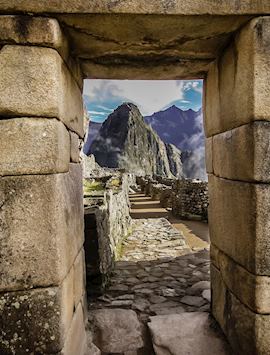
Discover Machu Picchu
8 days from $7,500pp

Incas & islands: Machu Picchu & Galapagos tour
12 days from $13,600pp

Visit Machu Picchu: A first timer's guide
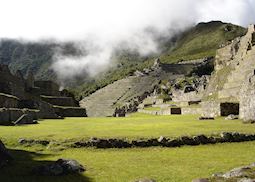
Trekking to and around Machu Picchu
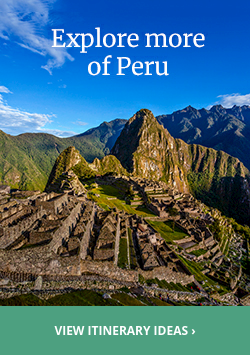
- Search Please fill out this field.
- Manage Your Subscription
- Give a Gift Subscription
- Sweepstakes
- Destinations
- Central & South America
The Best Times to Visit Peru, According to Locals
Whether you’re exploring Lima’s culinary scene or trekking to Machu Picchu, these are the best times to go to Peru.
Harrison Pierce is a freelance writer and digital nomad passionate about personal finance and travel. He is traveling full-time with the help of points and miles and enjoys connecting with people on the ground. His work has been published in Travel + Leisure, Condé Nast Traveler, USA Today Blueprint, Matador Network, and other publications.
- Best Times to Visit Peru for Smaller Crowds
- Best Times to Visit Peru for Good Weather
Best Times to Visit Peru for Lower Prices
- Best Times to Visit Machu Picchu
- Best Times to Experience Lima’s Food Scene
Worst Times to Visit Peru
Peru is famous for many things, but two stand out – adventure and food. Peru is famously home to one of the New Seven Wonders of the World, Machu Picchu. And it’s not all nature and history; in the 2023 edition of The World’s 50 Best Restaurants, Peru holds four spots (including number one), establishing its reputation as a bonafide foodie destination. This country is bursting at the seams with culture, but certain times of the year are better than others to soak it all in.
Peru is located in the Southern Hemisphere, which means the seasons are opposite of the U.S. or Europe. The warmest month of the year is February, and the coldest is August. Keep this in mind when you are packing so you dress appropriately.
MIGUEL MEJIA CASTRO/Getty Images
Peru’s tourism seasons fall into three main categories:
- High Season: May to August
- Shoulder Season: March and April, September and October
- Low Season: November to March
Here are the best times to visit Peru, according to local experts.
Meet the Expert
I spoke with Saul Alvarez Montalvo, the owner and manager at SAM Travel Peru , and Alex, a professional tour guide at Lima Experience , to put together a complete guide on the best times to visit Peru, depending on your travel goals.
Related: T+L ’s Travel Guide to Lima
Maria Ligaya/Travel + Leisure
Best Times to Visit Peru for Smaller Crowds
More than five million tourists traveled to Peru in 2019. Although the 2022 numbers were lower than pre-pandemic levels at just over two million travelers, it’s safe to say that crowds can get very heavy during the peak tourism season in Peru. For travelers looking for smaller crowds, Montalvo recommends visiting during the shoulder seasons – late April and May or September and October. “These are before and after the rainy season, [so travelers have] more chances of excellent weather conditions and fewer crowds,” says Montalvo.
Best Times to Visit Peru for Good Weather
For tourist destinations around the world, peak travel season typically falls when the weather is the best, and Peru is no exception. If you’re looking for the best weather, head to Peru anytime from May to September. Just keep in mind that crowds will be heavier during these months. The shoulder seasons are a good option if you’re looking for a bit more warmth while still avoiding the rain.
There is an exception to this rule. Peru is a large country, so the climates can vary significantly between cities. “Depending on the city you visit, you will have a much nicer or different experience,” explains Alex. “For instance, our summer season on the coast by the ocean is from early December to late February. That is the perfect weather in this area.” By June and July, this area starts getting cold and foggy. “In the highlands, it’s different,” says Alex. “From the middle of December through March is the rainy season.” So, travelers need to decide which city they want to visit and what kind of experience they want to have before determining the best time of year to visit.
Travelers will find the lowest prices during the rainy season. January and February tend to get the most rainfall — around 6 inches each month, with more than half the days seeing some precipitation. If you don’t mind getting a little wet, you should be able to find some great deals. “Companies tend to offer good deals for groups during these months because of the low demand in the tourism industry,” says Montalvo.
If you visit during the rainy season, try to schedule your activities in the morning. Afternoon rain showers are common, so you’d be more likely to stay dry if you get an early start.
Chris Marinaccio/Travel + Leisure
Best Times to Visit Machu Picchu
Montalvo recommends visiting Machu Picchu during the high season. “These months belong to the dry season, providing good weather and gorgeous views of Machu Picchu,” says Montalvo. Getting to Machu Picchu can be tricky for international travelers, so it’s important to plan far enough in advance to avoid any snags during your trip.
You cannot visit Machu Picchu without a tour guide, so they should be able to help you prepare for any weather conditions before your arrival. There are also rules for the number of daily visitors to Machu Picchu; typically around 2,500 to 3,500 people are permitted each day throughout multiple time slots from morning until evening. These rules promote the conservation of the area, so you shouldn’t expect it to be packed, even during the peak season. You’ll just need to plan far enough in advance so your dates don’t get booked up.
Best Times to Experience Lima’s Food Scene
Many consider Lima to be the culinary capital of South America. Central , ranked the best restaurant in 2023 by The World’s 50 Best Restaurants, is located here. Getting a reservation at Central takes some forethought, so planning a few months before you want to go is best. Reservation periods open about three to four months prior; the April, May, and June 2024 reservation periods will likely open up in mid-January 2024 . Of course, Central isn’t the only standout restaurant the city has to offer. “Lima has all different kinds of restaurants at all different kinds of prices,” says Alex.
Several holidays throughout the year celebrate Peruvian cuisine, from Pisco Sour Day in February to the Day of the Peruvian Cuisine and Gastronomy in September. During these holidays, there are festivals, tastings, and other events to appreciate and learn about the country’s food culture. And plant-based travelers aren’t excluded from the fun. “Restaurants are more open to the vegan and vegetarian side of society,” says Alex. “It’s little by little – most of the people can’t believe you can eat without a piece of meat. But now, we are being more open-minded.” For travelers who eat fish, he recommends trying ceviche, which is part of Peru’s culinary heritage.
MediaProduction/Getty Images
The worst time to visit Peru for most travelers is during the rainy season. So many of the experiences that bring travelers to Peru are outdoors; these can become much more complicated in the rain. Remember that the rainy season brings more trouble than just getting wet. Travelers will need to plan around landslides and flooding, which could potentially wreak havoc on an itinerary. However, as noted earlier, the tradeoff could be worth it for flexible travelers looking for fantastic deals and smaller crowds.
Travelers should also be aware of riots and protests, especially in the capital city of Lima. The recent riots following the removal of President Pedro Castillo in December of 2022 caused Peru to declare a months-long state of emergency. Travelers in Peru at the time saw airport closures and the closure of Machu Picchu , so it’s important to stay vigilant and aware of what’s happening in the country before you visit (of course, this advice can be applied to almost any country you visit). Montalvo says, “Travelers should monitor media outlets [to stay] updated about the advice of local authorities so they can avoid visiting Peru during riots.”
The Best Time to Visit Peru
:max_bytes(150000):strip_icc():format(webp)/Becker1-5b734a56c9e77c0025caddbd.jpg)
TripSavvy / Alison Czinkota
Peru is one of those classic adventure destinations that has a lot to offer travelers. From the beaches of the Pacific Coast, to the snowcapped peaks of the Andes, to the sprawling rainforest of the Amazon , the diversity of landscapes, wildlife, and activities is practically unmatched anywhere else on the planet. But when should you visit? The best time to visit Peru is between May and October, but as you'll see, there are a number of variables to weigh before booking your trip.
The most popular time to visit Peru is during the dry season, which runs from May through October. That just so happens to correlate with winter in the Southern Hemisphere, though for the most part, the conditions are as stable and dry as they get at any time of the year. If you're looking for predictable weather, and you want to maximize your chances of having sunshine and clear skies, then this is the best time to go.
Conversely, the rainy season occurs between December and March, with the highest amount of precipitation coming in January and February. During this time of the year the conditions are much less stable, and rainfall can often be quite heavy. That can make hiking the Inca Trail or visiting Machu Picchu even more unpleasant than battling large crowds. Hard rains can also make travel in the mountains unsafe or force trail closures as well, adding new challenges to any trip.
In addition to the dry and rainy seasons, Peru also has two short shoulder seasons in April and November. Those months of the year serve as transitions between the predominant weather conditions. While a bit less predicable, the weather is generally good but a little unstable at those times of the year.
As you might expect, the dry season is easily the busiest time of the year when it comes to travels visiting Peru. That means popular sites like Cusco , Machu Picchu , and the Inca Trail are often very crowded. This is especially true in July and August, when crowds can be quite large at popular tourist spots across the entire country. If your main goal is to avoid lines and overcrowding as much as possible, you may not want to go to Peru during the dry season.
On the other hand, the rainy season—and to a lesser extent, the two shoulder seasons—are much less crowded. Even the most popular sites like Machu Picchu are open, accessible, and easy to navigate, making it a great time to visit for those who really want to avoid crowds, but don't mind dealing with potentially bad weather.
The other time of the year to be aware of is late December into early January. Around the holidays each year, Peru sees another influx of visitors, which can lead to crowded hotels, packed restaurants, and fully booked tours. If that is when you intend to go, keep in mind that the popular attractions may be busier than you expected.
Inca Trail Closures
If hiking the Inca Trail is your primary goal, it is important to be aware that the route is closed throughout the month of February. Due to the very heavy rainfalls that occur during that month, the Peruvian government has made the decision to not issue any permits for the trail during that month. The reason for this closure is two-fold. First, it protects the trail and ensures that it won't get overly damaged when it is most vulnerable following major rain storms. Secondly, the closure also helps to keep trekkers safe by keeping them off the trail when it is at its most treacherous.
The Coast, Mountains, or Rainforest?
Part of Peru's attraction is that it has several unique climate zones to explore, and each of them has its own "best time to visit." For example, if you're mainly staying close to Peruvian Pacific Coast, then November through March will be your best bet in terms of sunshine and warmth. Yes, that is the rainy season throughout much of the rest of the country, but in Lima and along the ocean, it is a great time to be in country.
If Cusco, the Inca Trail, Machu Picchu, and the Andes are your intended destination, then avoid the rainy season if you can help it. The dry season is much more accommodating to visitors and with more stable conditions throughout and warmer temperatures, too. May through September marks the best time to be in the mountains, though it can be quite nice in April and October as well.
Likewise, the Amazon Rainforest is best visited in the dry season, and preferably from May to September. It is always warm and tropical in the Amazon, but less rain means it is also more accessible and enjoyable too. Temperatures are a bit cooler during the rainy season of course, but humidity is quite high all year round.
Festivals and Holidays
As with most countries, Peru has its fair share of national holidays and popular festivals. For the most part, they don't tend to interfere with travel and can actually make for highly memorable experiences. There are two festivals that travelers should certainly be aware of, particularly if they want to take part in them.
The first of those is the Festival of the Sun , which occurs on June 24 each year. This is the biggest and most lavish celebration of the year in Cusco, attracting thousands of visitors to take in its spectacle. The festival marks the passing of the winter solstice and has been celebrated for more than 500 years, which means it has a deep and lasting significance for the indigenous people.
The other festival/holiday to be aware of is Semana Santa, which occurs at Easter, with some celebrations and ceremonies taking place throughout Holy Week, and many hotels, flights, and restaurants are booked solid throughout. While it is another interesting festival to witness first-hand, it is best to be aware of it if you're going to travel to Peru during that sacred time of year.
Dry Season (Winter)
As noted, Peru's dry season occurs from roughly May to October each year. This, of course, makes it the most popular time to visit the country with travelers flocking in to take advantage of the good weather. Because of this, you can expect heavier than normal traffic at all of the top tourist spots, as well as airports, hotels, trains, and restaurants.
During this period, daytime temperatures in the mountains tend to be between 68 degrees F and 77 degrees F, but in the Amazon, things can get a bit warmer, ranging from 86 degrees F to 100 degrees F with lots of humidity. Over on the Pacific Coast, temperatures tend to be fairly mild with lows in the mid-60s and highs in the mid-70s.
Events to check out:
- Festival of the Sun (June 24): Observed throughout the country, the Festival of the Sun is Peru's biggest and most popular festival.
- Independence Day (July 28-29): A major holiday in Peru that celebrates the country's independence from Spain. It is typically marked with parades, special events, and parties, with many businesses being closed.
- Mistura Culinary Festival (September): Held annually in the city of Lima, the Mistura Culinary Festival includes more than 200 restaurants offering up some of the most amazing food.
Rainy Season (Summer)
With the arrival of the rainy season in December that lasts through March, conditions change fairly dramatically. In the mountains, the temperatures drop to an average of 64 degrees F to 68 degrees F during the day, while in the Amazon, the mercury stays pretty consistent with the dry season (mid-80s F to mid-90s F). Along the coast, things improve nicely, with sun and clear skies bringing temperatures ranging from 77 degrees F to 95 degrees F. Despite it being the rainy season, however, it is generally dry along the Pacific at that time.
Because of the shift in temperatures and precipitation, this tends to be the quietest time of the year at Peru's major tourist attractions. If you don't mind battling the weather (pack a good rain jacket!) it can be a rewarding time to be there, but heavy rains have the potential to also make it a miserable experience.
- Puno Day and Week (Nov. 5): This festival celebrates the life of Manco Cápac, who is viewed as the first Incan Emperor. Puno Day is typically celebrated on Nov. 5, with parades and celebrations taking place all week long surrounding that day.
- Day of the Immaculate Conception (Dec. 8): A major religious holiday and feast day on the Catholic calendar that remains sacred and holy in Peru to this day.
- Fiesta de la Candelaria (February): Taking place in the town of Puno, this popular celebration is held in honor of the patron saint of that city. It routinely sees more than 40,000 people taking part in the festivities.
After all of this, if you're still wondering when to go, then the question comes down to do you value good weather or smaller crowds? If the answer is weather, then avoid the rainy season and be prepared to be patient at Peru's biggest attractions, as they are likely to be very busy. On the other hand, if you would rather not deal with a throng of people, then going during the rainy season (or better yet, one of the shoulder seasons) may be right for you. Just pack appropriately, and accept the fact that you'll likely encounter rain and poor weather at times.
The best time to visit is between May and October when the weather is dry during the Southern Hemisphere's winter.
Peru's rainy season lasts from December to March with January and February being the rainiest months.
The dry season is the busiest time of year in Peru for tourism, so to avoid crowds try to travel during the rainy season or during the shoulder months in April and November.
Weather Spark. "Average Weather in Cusco, Peru, Year Round." Retrieved February 17, 2021.
Ticket Machu Picchu. "The truth about the closure of the Inca trail to Machu Picchu." Retrieved February 17, 2021.
Cusco Peru. "Inti Raymi - Sun Festival, Feast of the Incas." Retrieved February 17, 2021.
The Best Time to Visit the Bahamas
The Best Time to Visit Spain
The Best Time to Visit Dubai
The Best Time to Visit the Dominican Republic
Is It Safe in Peru?
The Best Winter Getaways for Families
The Best Time to Visit Machu Picchu
The Best Time to Visit Cologne
The Best Time to Visit Japan
The Best Time to Visit the Great Barrier Reef
The Best Time to Visit Morocco
Where to Go in 2021: 10 Future Trips You Can Start Planning Now
The Best Time to Visit the U.S. Virgin Islands
The Complete Guide to Peru's Sacred Valley
The Best Time to Visit the Maldives
Top 10 Reasons You Should Visit Peru
- EN - English
- PT - Portuguese
- ES - Spanish
- How it works
- Become a Host
- Download the app
Top Destinations
- United States
- United Kingdom
What type of experience are you looking for?
- Non-Profit School
- Permaculture project
- Eco Village
- Holistic Center
- Guest House
- How Worldpackers works

Learn from the most experienced travelers of the community
Traveling with worldpackers, planning and budgeting for travel, make a living while traveling as a lifestyle, travel with worldpackers.
- Using Worldpackers
- Work exchange
- Social impact
Plan your trip
- Women traveling
- Budget travel
- Solo travel
- Language learning
- Travel tips
- Get inspired
- Digital nomads
- Travel jobs
- Personal development
- Responsible travel
- Connect with nature
Top destinations
- South America
- Central America
- North America
- More destinations
- WP Life WP Life
- Exclusive discounts Discounts
- Latin America
The best time to visit Peru: a complete travel guide
Wondering what time of year is best to visit Peru? This detailed guide will highlight the best time to visit Peru, as well as other highlights of this amazing South American country.
Gabrielle Budget Travel With Gabby
Nov 10, 2022
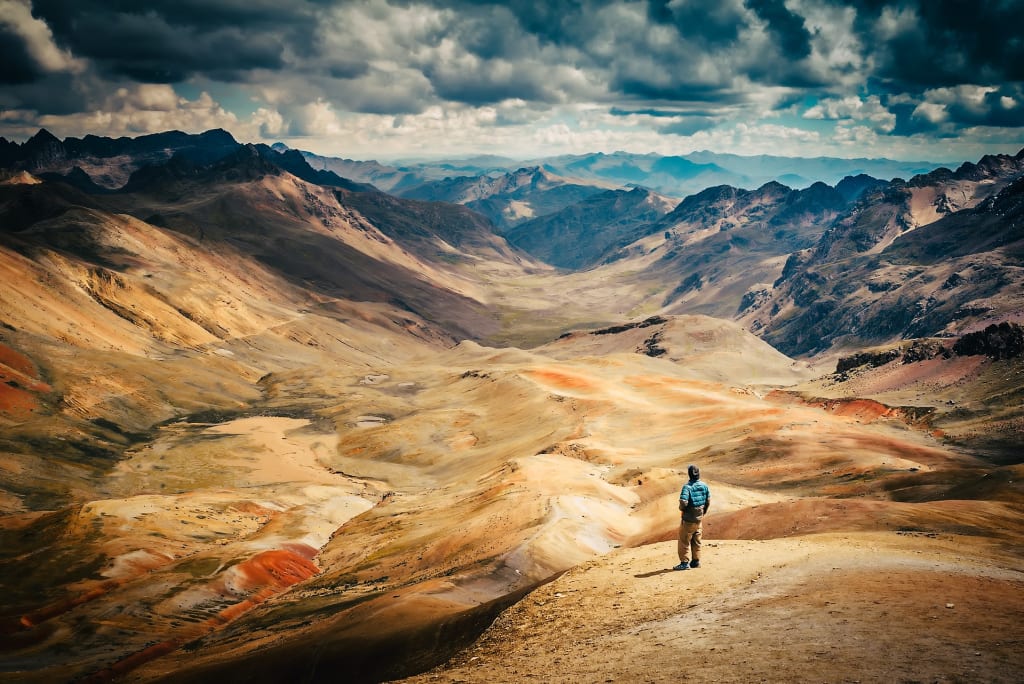
Peru is an incredible country in South America.
It is full of diverse natural landscapes like beaches, salt flats, deserts, lakes, forests, and the famous Andes Mountains and Amazon Rainforest .
It also has big cities and small villages. Peru has exquisite local cuisine, lots of cool wildlife, extremely friendly locals, and a rich history.
So if you’re planning on visiting Peru anytime soon, you may be wondering when is the best time to go .
This article will explore the best time to visit Peru . I’ll also touch on some of the best places to visit in Peru , as well as work exchange opportunities in Peru .
I hope this guide is helpful for those who want to visit this gorgeous and welcoming country on the western side of South America !
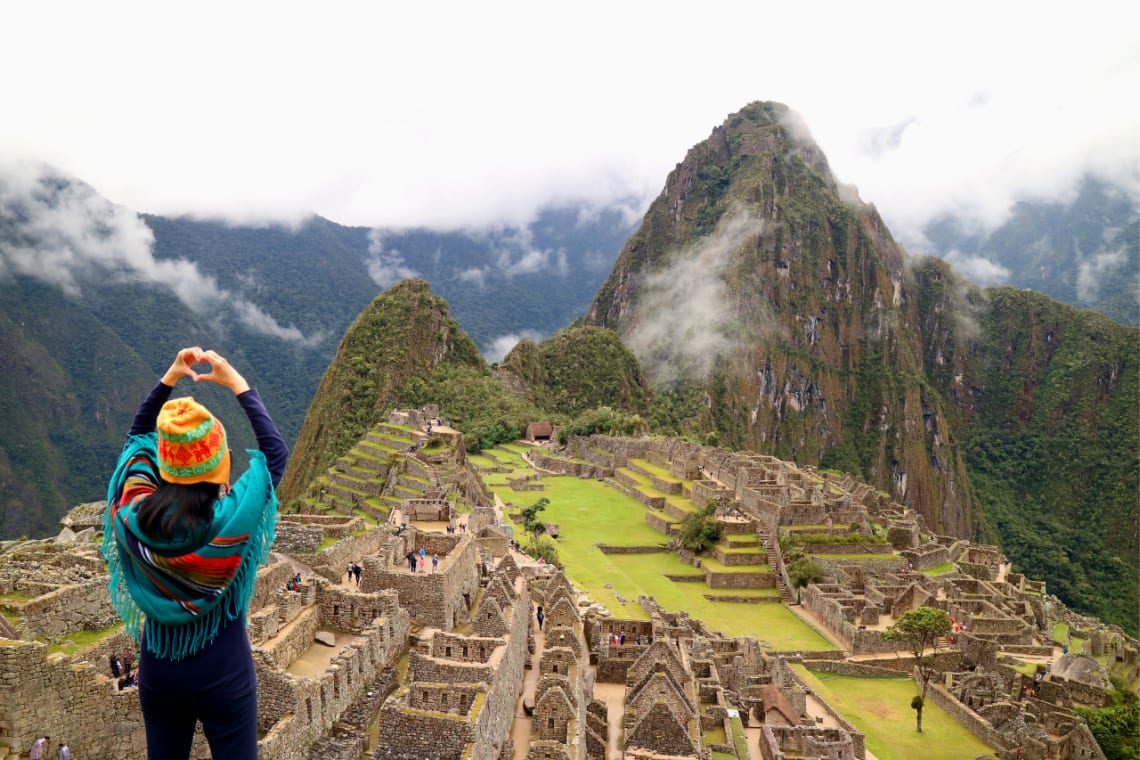
When is the best time to visit Peru?
Peru has two seasons: wet and dry.
The dry season is from May to October , and the wet season is from November to April .
Generally speaking, the dry season has the best weather with the smallest chance of rain. But this means higher flight prices and more crowds, particularly at the famous tourist attractions like Machu Picchu.
Wet season has a high chance of rain, especially in January and February. But prices are cheaper and there are fewer crowds.
So if you want to save money and enjoy the best Peru attractions without any crowds, consider visiting Peru during the wet season.
If you want to enjoy amazing weather on your trip to Peru, visit during dry season.
Probably the best option is to travel to Peru during shoulder season !
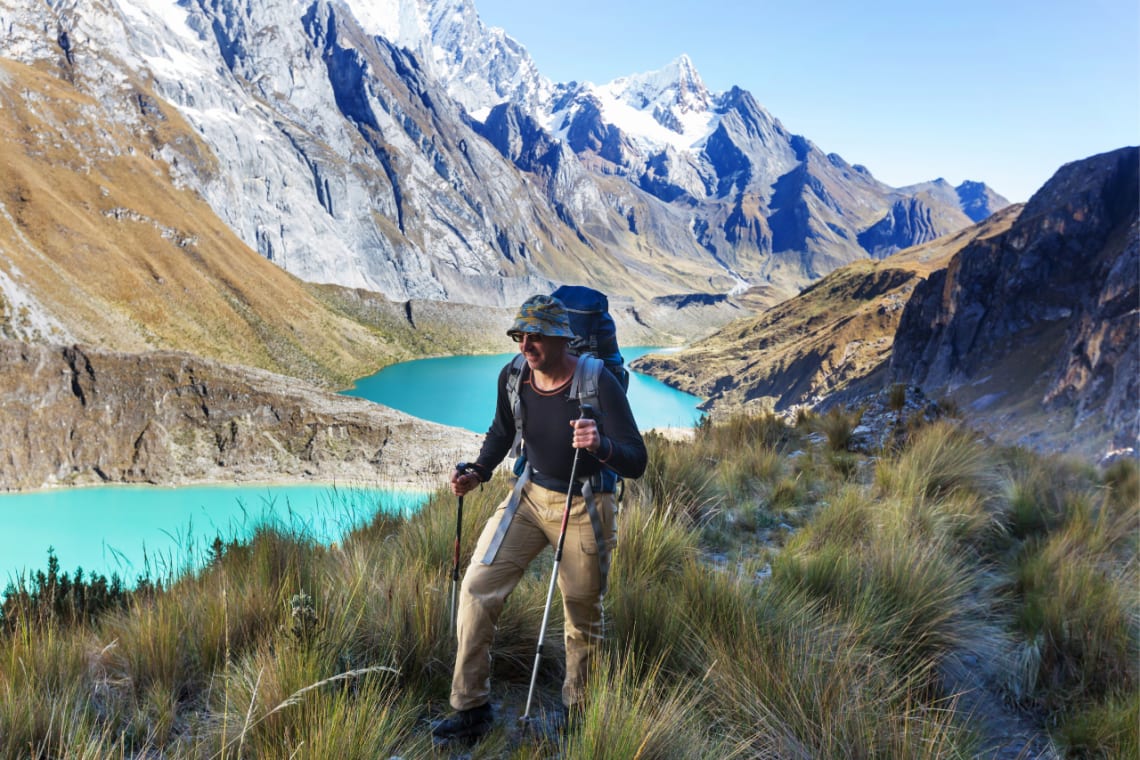
Shoulder season: the best time to visit Peru
Shoulder season means the transition months between off season and peak season.
Off season would be the rainiest months: January and February , while peak season is the busy months of June, July, and August during the drier months.
So shoulder season is around April or May, at the end of the rainy months and the beginning of the dry season. The rain drops off, the sun shines more, and the summer crowds haven’t hit hard yet.
Alternatively, October or November are great months to travel to Peru . The rainy season is starting, but you’ll still enjoy lots of sunshine and the heavy, consistent rain won’t begin until about January. The crowds from summer have calmed down by then.
For a nice middle ground in terms of weather, flight prices, and crowds, shoulder season is the best time of the year to visit Peru . That is April, May, October or November.
Places to visit in Peru
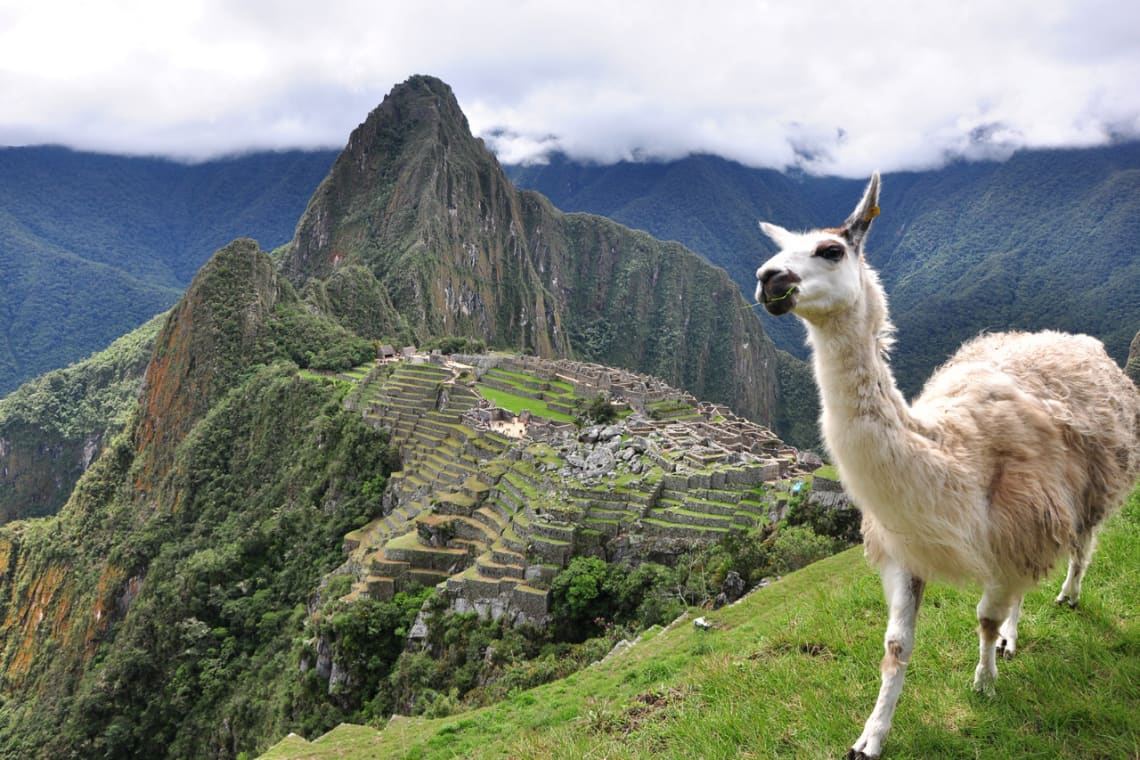
Now that you know the best time to visit Peru, I’ll quickly mention some ideas for what to do in Peru. Here are 9 places to consider when visiting Peru:
Machu Picchu: the "must-see" of every trip
This is, of course, the biggest tourist attraction in the country and the main reason many people travel to Peru. This historic Incan city located high in the Andes Mountains is an iconic landmark, and it is so worth a visit.
You can choose to do a multi-day trek to Machu Picchu, such as the famous Inca Trail or the more challenging Salkantay trek. Or you can just catch public transport to the nearby town of Aguas Calientes and head up the mountain straight away.
Don't miss the historical city of Cusco
Cusco is the gateway city to Machu Picchu. Most travelers spend a few days here before starting a trek or taking the train to Machu Picchu.
Cusco has many things to do , as well as lots of impressive cathedrals, historic monuments, wide public squares, bustling local markets, and amazing restaurants.
There are also lots of fun hostels here where you can party and mingle with other travelers.
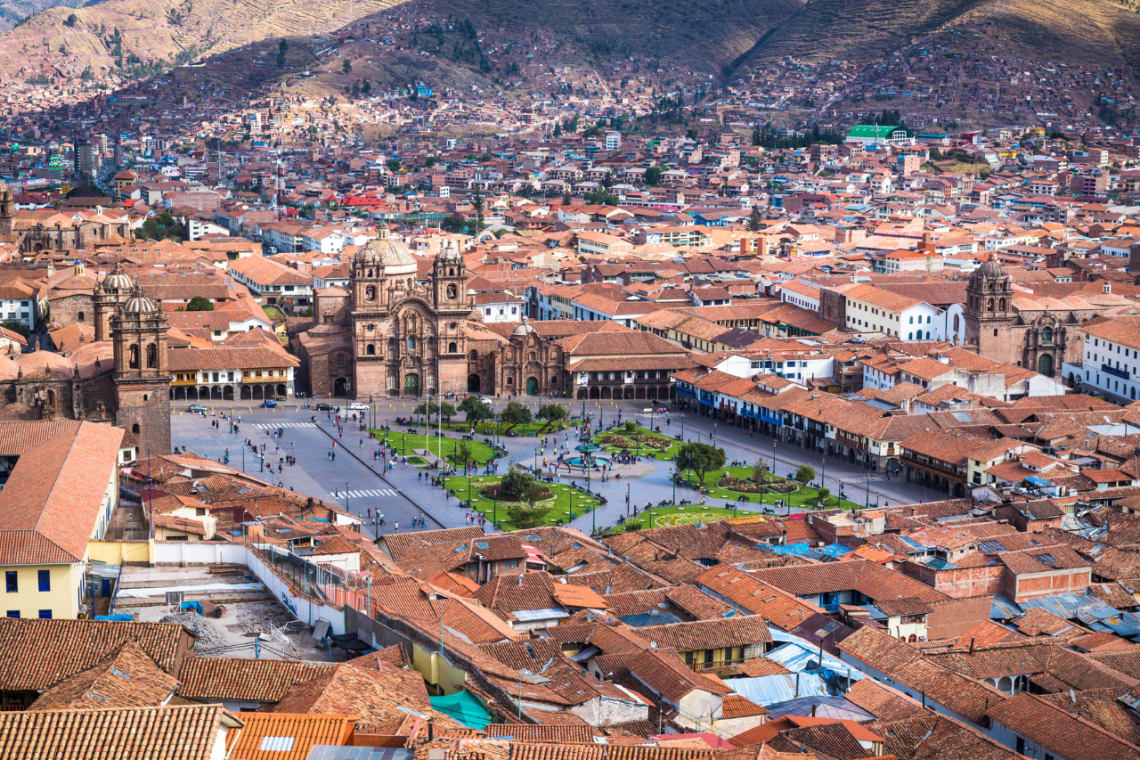
Visit Huacachina Sand Dunes and its oasis town
The resort town of Huacachina near the town of Ica looks like an actual desert oasis. Surrounded by miles of soft golden sand dunes, Huacachina has a lagoon, palm trees, and tourist resorts, and is the base for exploring the dunes.
Sandboarding is a popular sport to try on the sand dunes!
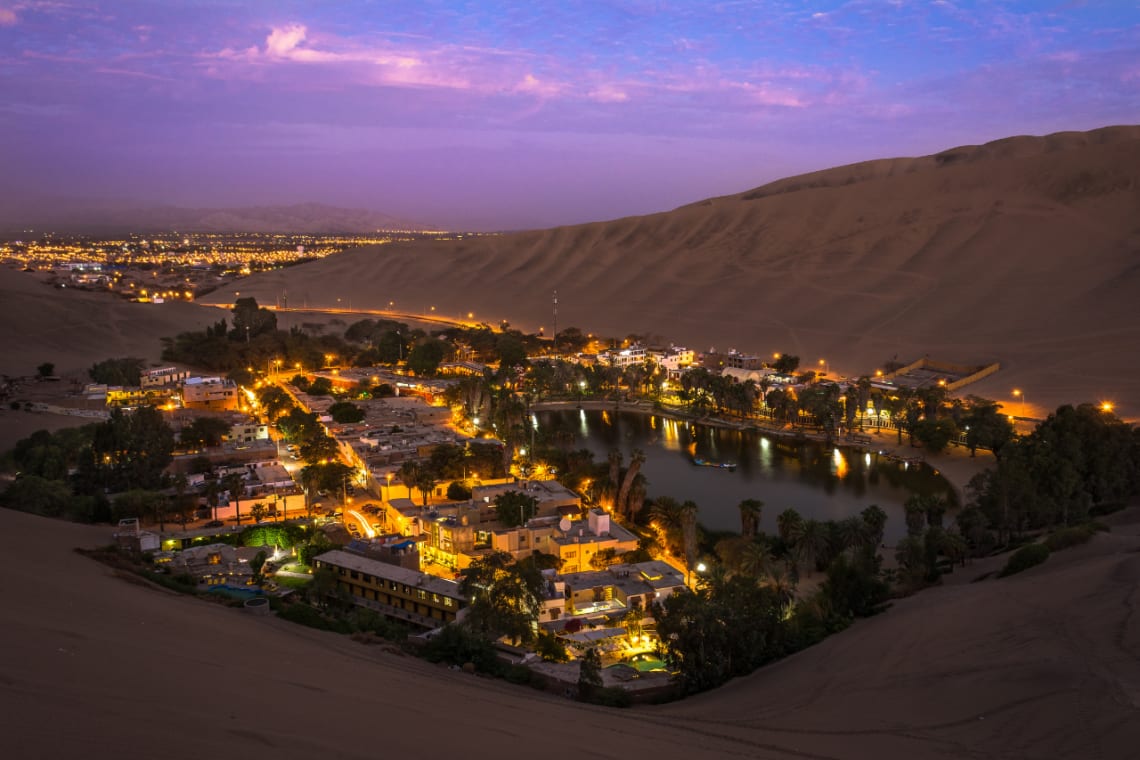
Disover charming Arequipa
The city of Arequipa , surrounded by mountains, is a must-see on a trip to Peru. Dubbed a UNESCO World Heritage Site, the Arequipa historic city center is a charming area full of colonial architecture and a heartwarming local culture.
The buildings in the city center are made of a light colored volcanic rock called "sillar stone".
Get hypnotized by the Rainbow Mountain
Not far from Cusco and Machu Picchu lies Rainbow Mountain, locally known as Vinicunca . This incredible natural phenomenon sits atop a high-alitiude hike that can be done in one day.
The mountain and surrounding valleys are streaked with vibrant natural colors that looks like a rainbow.
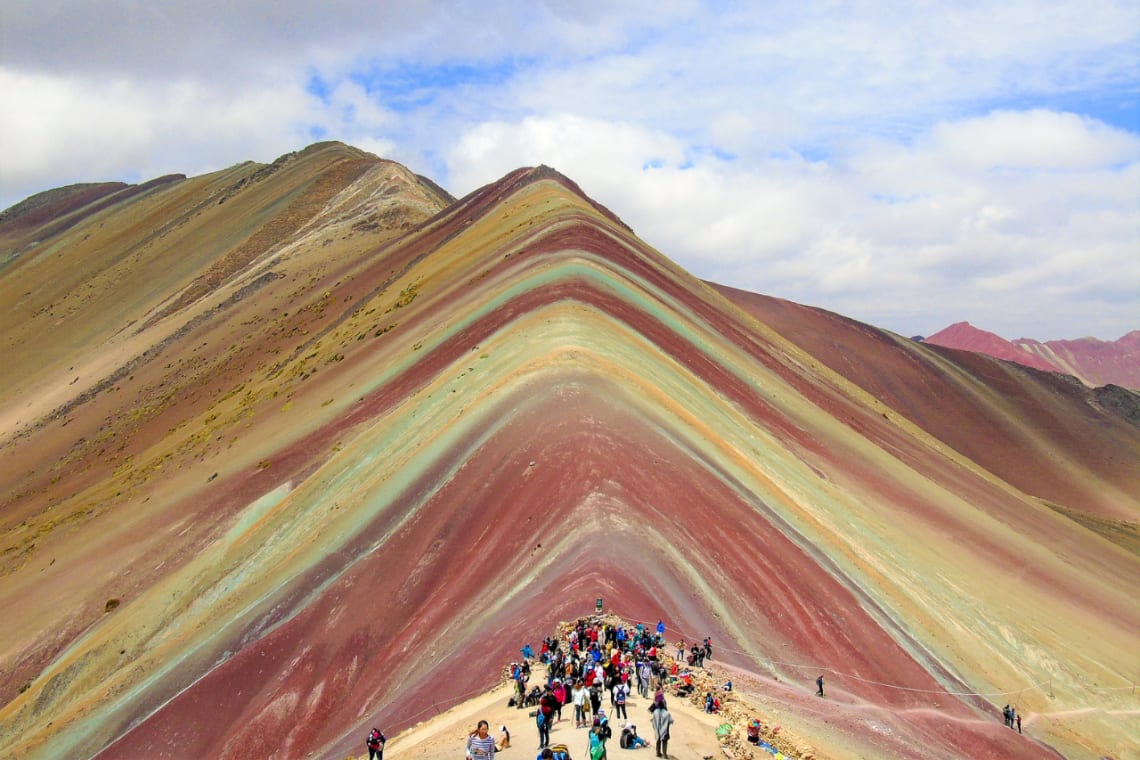
Spend some days in Lima, the capital city of Peru
The capital city of Peru, Lima , is a busy metropolis that is packed with fun things to do. It has a well preserved colonial center, lots of interesting museums, magnificent cathedrals, and cliffside coastal views.
Because Lima is a coastal city, the seafood here is super fresh. This is the perfect place to try one of Peru’s best dishes: ceviche. There are countless high end or humble local restaurants in Lima where you can try this zesty fish and citrus dish.
Overall, Lima is a great place to visit in Peru and one of the 20 best cities to solo travel in South America .
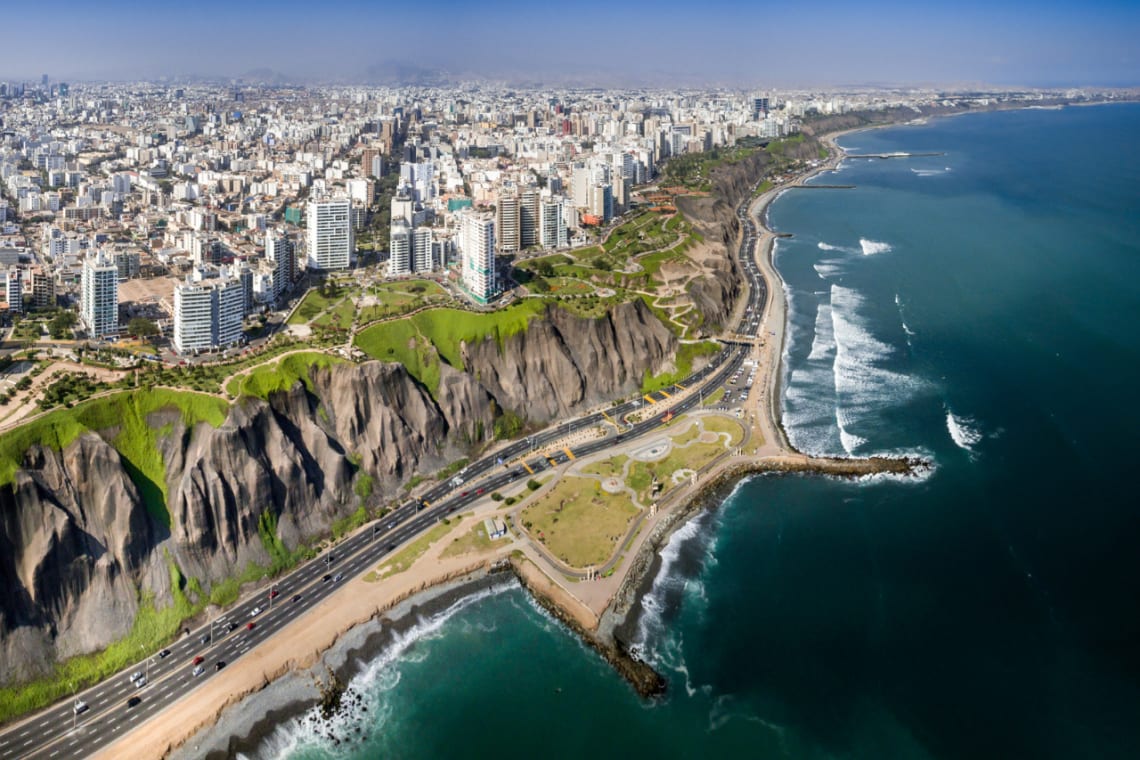
Explore the Amazon Rainforest in Puerto Maldonado
This jungle town is the perfect base for exploring the Amazon Rainforest. From here you can book tours that will take you into the thick of the jungle.
Visit national parks and nature reserves, see some rare wildlife, admire the tropical plants and landscapes, and soak in the hot, humid rainforest weather.
Trek around the marvelous Colca Canyon
One of the deepest canyons in the world, Colca Canyon is one of the best places to visit in Peru.
Book a tour here to visit a traditional village, go trekking along the giant river canyon, or go bird-waching in hopes of seeing an amazing Andean condor sailing over the landscape.
Get to know the local island-villages of Lake Titicaca
Lake Titicaca, which straddles the border of Peru and Bolivia , is the world’s highest navigable body of water. It is a gorgeous blue lake with a few islands that have their own special and unique cultures.
The Uros Island are made entirely out of reeds. It is fascinating to learn how the local families live and thrive on these floating islands in the middle of the lake.
Taquile Island is another isolated spot on the lake where the locals have interesting customs and traditions that remain unchanged from how their ancestors lives.
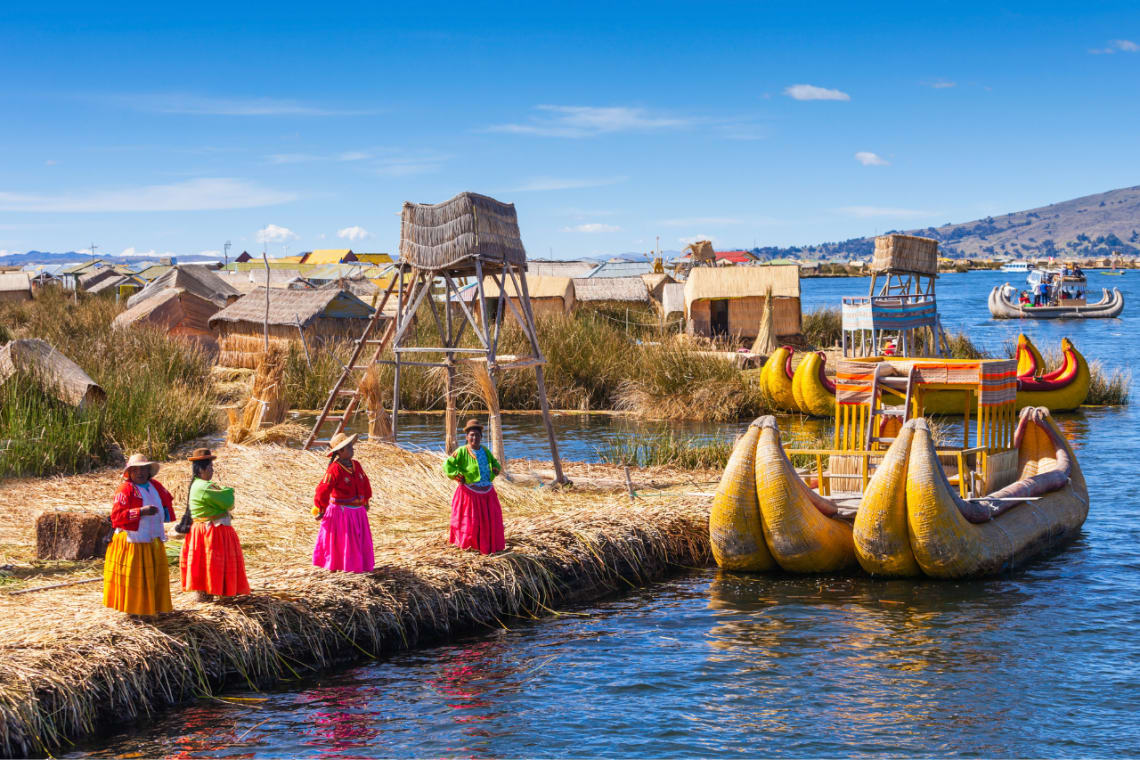
Be part of a work exchange in Peru
For an interesting cultural experience, consider doing a Worldpackers work exchange in Peru !
You can work in exchange for accommodation, so you’ll save money when traveling in Peru. You’ll also get the opportunity to live with locals, learn Spanish , and try out the local way of life.
Worldpackers has over 200 work exchange opportunities in Peru , in over 40 different areas of the country. Some of the work exchanges in more remote areas may require you to speak Spanish. If you don't speak Spanish, Peru is a great place to learn! You can always look for work exchanges in more touristy areas where English is spoken, if you don't have any Spanish skills.
Here are some of the top work exchanges in Peru:
Volunteer at a local zoo in the Peruvian Andres Valley : This work exchange has 26 five star reviews from past travelers! Here you get to work alongside professional veterinarians and knowledgeable staff to learn about different animals and how to care for them.
Teach English at a non profit organization : Here you will work 15 hours per week teaching locals of all ages how to speak English. You will be benefitting the local community, forming connections, and taking day trips around Peru.
Work at a hostel in Piura in Northwest Peru : A great way to make lots of international friends and practice Spanish is working in a hostel. You can do tasks like reception, housekeeping, and administration, all while living in a fun and social environment.
Get in touch with nature at a rural homestay : This home stay work exchange near the Amazon will help you immerse yourself in nature and enjoy a unique place. The hosts have a horseback riding business and need help with web development and videography, so you can also develop your digital skills and gain valuable work experience.
Recap: The best time to visit Peru
So, as we have seen earlier in this article, in general terms the best time to visit Peru is the shoulder season .
However keep in mind, the best time to visit Peru for weather is anytime between May and October . The best time to travel to Peru to save money is during the rainy season, particularly January or February .
There are lots of incredible places to visit in Peru once you arrive. Hike iconic mountains in the Andes like Machu Picchu and Rainbow Mountain. Visit sand dunes, lakes, canyons, and the Amazon Rainforest. Or enjoy the cities like Lima, Cusco, and Arequipa.
And to have an unforgettable experience traveling in Peru and living amongst the locals, try a work exchange !
If your are planning to head to Ecuador after Peru, you should check out when is the best time to visit Ecuador .
For more travel inspiration about other countries in South America, check out these articles:
- 5 Paraguay travel tips .
- 12 reasons to visit Cartagena de Indias .
- 7 cheap vacations in South America to learn about other cultures .
Is Peru safe to travel? Everything you've never known about the country
Join the community!
Create a free Worldpackers account to discover volunteer experiences perfect for you and get access to exclusive travel discounts!
Gabrielle Boucher
Budget Travel With Gabby
Hello! I am a 25 year old from the USA with a knack for traveling on a budget. I fell in love with traveling while studying in Europe, and that love grew even more when I started volunteering abroad in South America. Since then, I've worked odd jobs and volunteered all over the globe while cultivating passions for hiking, wildlife photography, food, wine, animals, permaculture, and more!
Be part of the Worldpackers Community
Already have an account, are you a host, leave your comment here.
Write here your questions and greetings to the author
More about this topic

7 cheap South America vacations to enjoy on a budget
10 colombian desserts and traditional food you must try on a trip to south america.
16 photos to inspire you to visit Peru
How do Worldpackers trips work?
As a member, you can contact as many hosts and travel safely as many times as you want.
Choose your plan to travel with Worldpackers as many times as you like.
Complete your profile, watch the video lessons in the Academy, and earn certificates to stand out to hosts.
Apply to as many positions as you like, and get in contact with our verified hosts.
If a host thinks you’re a good fit for their position, they’ll pre-approve you.
Get your documents and tickets ready for your volunteer trip.
Confirm your trip to enjoy all of the safety of Worldpackers.
Have a transformative experience and make a positive impact on the world.
If anything doesn’t go as planned with a host, count on the WP Safeguard and our highly responsive support team!
After volunteering, you and your host exchange reviews.
With positive reviews, you’ll stand out to hosts and get even more benefits.
- Best time to visit Peru
Book your individual trip , stress-free with local travel experts
- roughguides.com
- South America
- Travel guide
- Itineraries
- Local Experts
- Travel Advice
- Accommodation
Plan your tailor-made trip with a local expert
Book securely with money-back guarantee
Travel stress-free with local assistance and 24/7 support
Choosing when to go to Peru is complicated by huge differences in temperatures across the country’s different regions. The best time to visit Peru will depend on which regions you intend to go and what activities are you planning to do.
What is the best time to visit Peru
Best months to visit peru, climate in peru, peak season in peru, the wet season in peru, the dry season in peru, best time to visit machu picchu, best time to visit lima, festivals and public holidays in peru, tailor-made travel itineraries for peru, created by local experts.

8 days / from 2429 USD
Peru: into the Incan Empire
Who were the Incas? What did they do? What happened to them? Discover the answers, and much more, with this unique trip into the heart of the former Inca Empire.

8 days / from 2822 USD
Female Empowerment Tour
From meditations in Miraflores over visits to craftswomen in Chincheros to gratitude rituals in the Sacred Valley. This itinerary will allow you to reconnect with your feminine energy and learn more about women's lives in Peru.

19 days / from 3510 USD
Culture, Nature and Adventure in Peru
Get to know Peru through its locals and breathtaking trails- full of history. Hop aboard a motorboat to get to know the local way of life of the Uros people, before you start the great Inca trail, where beautiful landscapes, archaeological sites and fresh air are waiting for you.
The dry season (May to September) is considered the best time to visit Peru . It's also high tourist season in. Coastal areas, including Lima and Paracas, have mild temperatures and minimal rainfall. It's an excellent time for visiting popular attractions like Machu Picchu, the Sacred Valley , and Cusco . The Andean region experiences colder temperatures, particularly at higher altitudes, so be prepared for cooler weather if you plan to visit areas like Arequipa or Puno.
During the wet season (November to March) there's more rainfall, especially in the Andean region and the Amazon rainforest. Trekking routes, such as the Inca Trail , may be closed due to heavy rains and landslides. However, the wet season can be an excellent time to visit the coastal regions, including Lima and northern Peru, as they experience warmer temperatures and fewer tourists.
The shoulder seasons (April and October) mark the transition between the dry and wet seasons. The weather can be more unpredictable, with occasional rainfall. It's a less crowded time to visit popular sites like Machu Picchu, and you may find better deals on accommodations and tours.
Planning a trip to Peru? Perhaps our local experts in Peru can help you!

Morning sun rising with cloudy on Aden Mountain at Plaza de Armas, Cusco, Peru © Shutterstock
It’s challenging to choose the best time to visit Peru because of the change in the weather across regions. January is the best month for a trip to the coast for fantastic weather, while May to September is the ideal period for visiting the Andes, Machu Picchu and the Amazon when it’s driest.
Since you’re unlikely to find the best time to visit all areas on a single trip, there's little point in worrying about it. The country’s attractions are broad enough to override the need for guarantees of good weather.
Weather in Peru in January
Expect warm temperatures and abundant sunshine in Peru in January . Coastal areas like Lima enjoy average temperatures of 25-28°C (77-82°F), perfect for beach visits and water activities.
In the Andean highlands, temperatures range from 10-20°C (50-68°F), ideal for exploring ancient ruins like Machu Picchu. The Amazon rainforest experiences high humidity and temperatures around 25-30°C (77-86°F).
For your holidays in Peru in January, try our tailor-made trips to Peru .
Weather in Peru in February
The weather in February is still pleasant weather and largely dry. Along the coast, temperatures hover around 25-28°C (77-82°F) with minimal rainfall, perfect for beach outings.
In the Andean highlands, temperatures range from 10-20°C (50-68°F), providing comfortable conditions for exploring Cusco and Sacred Valley 's archaeological wonders.
The Amazon rainforest experiences tropical weather, with temperatures around 25-30°C (77-86°F) and occasional showers.
Weather in Peru in March
Rainfall increases in the Amazon in March but the northeast coast still experiences temperatures of 25-28°C (77-82°F) and minimal rainfall.
In the Andean highlands, temperatures range from 10-20°C (50-68°F), creating comfortable conditions for hiking.
Explore a hidden gem in Peru with our tailor-made trip . Discover rarely visited destinations, uncover rich archaeological remains, and be amazed by vast nature and stunning landscapes.

Arequipa Church with the Misti Volcano Behind on sunset, Arequipa in Peru © JorgeAndres/Shutterstock
Weather in Peru in April
April in Peru brings favourable weather for exploration. Coastal areas like Lima enjoy temperatures around 23-27°C (73-81°F) with minimal rainfall, perfect for coastal activities and exploring archaeological sites.
In the Andean highlands, temperatures range from 10-20°C (50-68°F), providing pleasant conditions for hiking the Andes or visiting cultural gems like Arequipa. The Amazon rainforest experiences warm temperatures around 25-30°C (77-86°F) and increased rainfall, offering vibrant ecosystems and unique wildlife encounters.
With our tailor-made trip to Peru for nature lovers , you can explore one of the most ecologically diverse countries on earth. Peru boasts an impressive range of ecosystems, with 84 out of the 103 known ecosystems and nearly 90% of the world's recognized climates found within its borders.
Weather in Peru in May
May to September is considered to be the best time to visit Peru. The weather in May is still comfortable for exploring much of Peru. Temperatures in Lima hit around 21-24°C (70-75°F) and there isn't much rain.
The Andean highlands have similar temperatures to April, ranging from 10-20°C (50-68°F), providing pleasant conditions for visiting Machu Picchu or trekking through the Sacred Valley .
The Amazon rainforest has more showers and warm temperatures that hit 25-30°C (77-86°F).
Weather in Peru in June
Temperatures in Lima start to drop to around 18-21°C (64-70°F) in June, though rainfall remains minimal.
Colder temperatures are felt in the Andean highlands, dropping to 5-15°C (41-59°F), providing cool but manageable conditions for exploring the Inca Trail or visiting Lake Titicaca .
The humid Amazon rainforest experiences Peru's warmest June temperatures of between 25-30°C (77-86°F) with regular rain showers.
Weather in Peru in July
In July temperatures drop again to around 17-20°C (63-68°F) but there is still little rainfall, meaning this can be a good time to explore the city.
Temperatures in the Andean highlands stubbornly stay at around 5-15°C (41-59°F), providing cool weather for trekking to Machu Picchu or visiting Cusco .
The Amazon rainforest remains warm and humid with regular downpours.
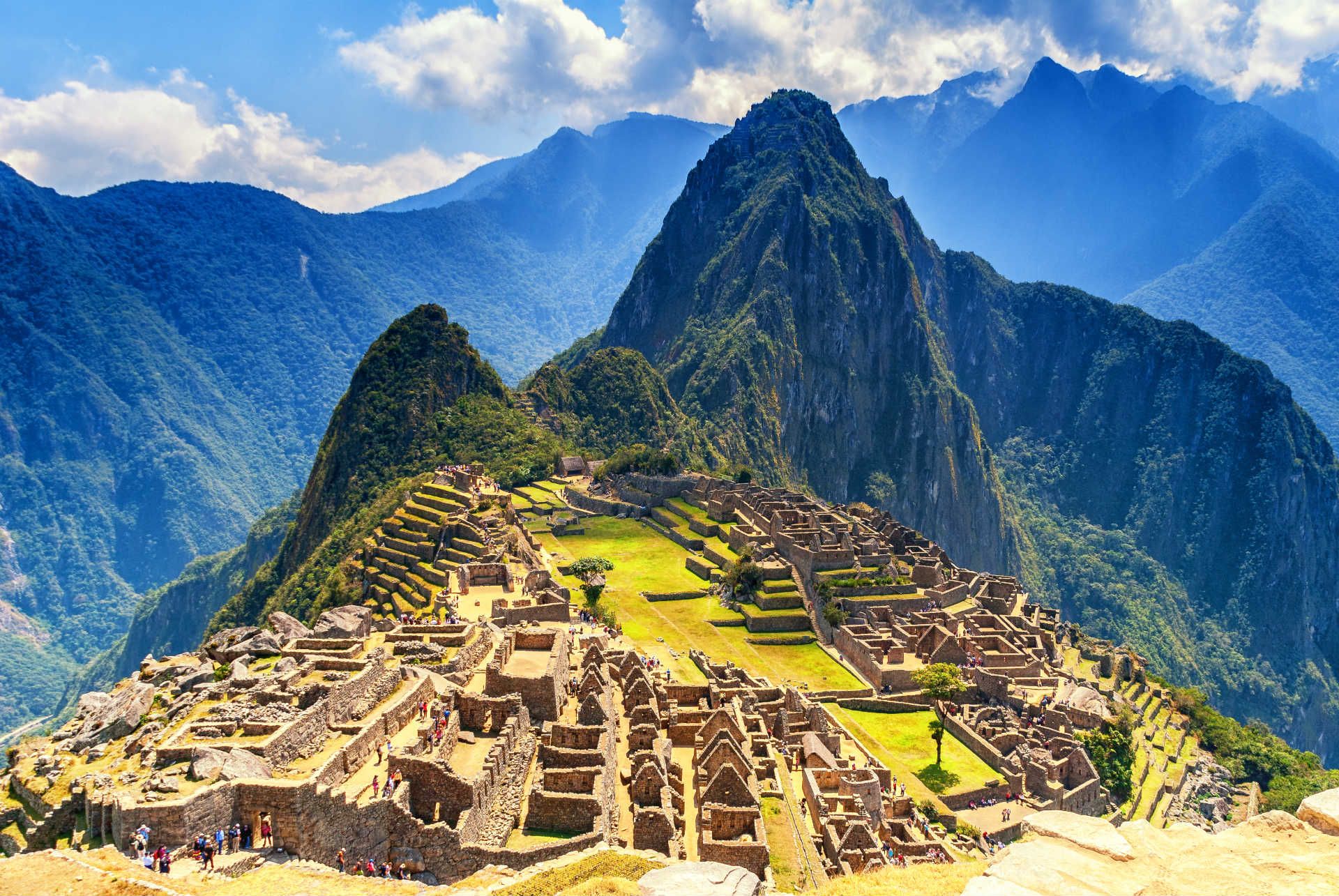
Machu Picchu, Peru © Shutterstock
Weather in Peru in August
August in Peru has pleasant weather for hiking the Andean highlands and trekking the Inca Trail .
Lima is largely dry, despite temperatures falling again to around 16-19°C (61-66°F), whilst the Amazon rainforest experiences thes warmest temperatures of around 25-30°C (77-86°F) with occasional showers.
Weather in Peru in September
The low mist that descends over the Lima Valley in September will start to clear with temperatures sitting around 16-19°C (61-66°F) and occasional showers, creating a refreshing time to explore the capital.
In the Andean highlands, the relatively dry period starts to ease, ushering in more rain. This can be the time to explore cultural gems like Arequipa rather than hiking.
The Amazon rainforest is warm, with temperatures around 25-30°C (77-86°F), wet and vibrant.
Weather in Peru in October
Lima welcomes its coolest temperatures in October (lows of 15˚C and highs of 19˚-20˚C), whilst the Amazon heads into its hot and humid dry season with less rainfall.
It hardly rains in Cusco or around Machu Picchu either, so weather-wise it can be a good time to visit, though many will have the same idea.
Weather in Peru in November
In November, the coastal regions of Peru, such as Lima, have seen temperatures stick around 20-23°C (68-73°F) with more chance of rain.
The air is fresh and crisp in the Andean highlands with little chance of downpours and warmer temperatures that fluctuate between 10-20°C (50-68°F).
It’s also much drier in the Amazon and a good time to visit.
Weather in Peru in December
In December , coastal regions like Lima experience temperatures around 21-24°C (70-75°F) with minimal rainfall, providing ideal conditions for beach visits and water sports.
In the Andean highlands, temperatures range from 10-20°C (50-68°F), creating pleasant weather for trekking to Machu Picchu or exploring the Sacred Valley .
The Amazon rainforest experiences temperatures around 25-30°C (77-86°F) with occasional showers, offering lush landscapes and incredible biodiversity.

Rainbow mountains or Vinicunca Montana de Siete Colores, Peru © Shutterstock
It’s worth taking a look at the weather patterns to assess when to visit Peru; the climate varies according to different physical characteristics and by altitude. Each region, from the desert coast, to the Amazon basin, to the Andes, has a different and varied climate and environment.
Whereas the summer months in the Northern Hemisphere fall around June to August, the height of the summer (verano) along the desert coast more or less fits the expected image of the Southern Hemisphere.
That’s to say it’s extremely hot and sunny between December and March (especially in the north), cooler and with a frequent hazy mist, known as garúa, between April and November. Only in the polluted environs of Lima that the coastal winter ever gets cold enough to necessitate a sweater.
The peak tourist season in Peru generally coincides with the dry season, which runs from May to September. During this period, the weather is usually favorable with minimal rainfall, making it an ideal time to visit popular attractions like Machu Picchu, the Sacred Valley, and Cusco.
The peak season attracts a significant number of tourists, so popular sites can be more crowded, and prices for accommodations and tours may be higher. It's advisable to book your travel arrangements well in advance if you plan to visit Peru during the peak season.
In the Andes, the seasons are more obviously defined, with heavy rains from December to March and a warm, relatively dry period from June to September, the peak season. Inevitably, though, there are always some sunny weeks in the rainy season and wet ones in the dry. There is quite a difference between temperatures in the day and at night, so be sure to pack warm clothing.
In the Andes and the Amazon Basin locals consider the rainy season (December to March) to be winter. To minimise the confusion it’s probably clearer if you just refer to seasons as the ‘wet’ and ‘dry’ season. With this in mind, the wet season in the Amazon is hot and humid.
In Arequipa in the south, the temperatures are really pleasant at this time of year. During the December to February period, you can expect the rainy season in the Amazon Basin and the Andes. Water levels are high at this time, and flora and fauna are abundant. At this time of year, the Inca Trail often closes during February due to possible landslides and maintenance. Machu Picchu itself remains open during this period.
For those coming from the Northern Hemisphere spring is considered to be roughly from March to May. From March the temperature on the coast begins to get milder. It’s still wet within the Andes, but you will find that it’s quieter with fewer crowds on the trails. The rainforest is still hot and humid – as it is all year.
In March to May, it is still hot in the coastal areas, but temperatures are beginning to drop. March is the end of the rainy season in Machu Picchu, and you can expect the area to be drier and warmer by May.
Average rainfall in Peru
In the coastal regions, such as Lima and the northern coast, the average annual rainfall is relatively low, ranging from 0 to 100mm (0 to 4 inches) per year. These areas are characterized by arid and desert-like conditions.
In the Andean highlands the average annual rainfall varies between 500mm and 1,000mm (20 to 40 inches). The rainy season in the highlands coincides with the summer months, from December to March.

Inca trail in Peru © Shutterstock
To minimise confusion we’re talking about the summer months in the Northern Hemisphere – which are Peru’s winter months. Dry conditions and warm weather make this an ideal time to visit Peru.
Cusco is at its best and you can make the most of the Andes’ fantastic trekking opportunities. It is cold though when the sun goes down, so take extra layers. The Amazon is hot all year but at its driest during the May to September period.
December to February can be the best time of year to visit Peru if you are travelling to the coastal regions, especially in the north. You can expect temperatures to be hot and sunny at around a pleasant 29˚C. There will be very little rainfall in coastal regions.
There is less rain in the Andes at this time of year and it’s a good time to travel for those who want to go trekking or climbing. You’ll get some excellent views of the mountain peaks and clear blue skies.
Temperatures are much milder on the coast – at around 18˚-22˚C– than between December and March. Lima is also shrouded in grey mist at this time of the year. The coolest temperatures occur from June to October (lows of 15˚C and highs of 19˚-20˚C).
In the Amazon, temperatures are hot and humid, but this is the dry season, so there will be less rainfall and lower water levels
Machu Picchu is an unmissable highlight of any trip to Peru. In high season, from June to September, the entire Valle Sagrado swarms with visitors and it might be difficult to avoid the crowds. If you plan to go in the high season, you need to book several months ahead as the trail is so popular.
The whole area is quieter from October to April but it’s wetter. The Inca trail is closed in February, which is usually the wettest month. It closes for annual maintenance and repair, although Machu Picchu itself is still open.
The month of May is quite a good choice as it’s the end of the rainy season, and the sky will be bright and clear with excellent views.
Rough Guides tip: check our Rough Guides Itineraries

Woman in Cuzco, Peru © Marco Alhelm/Shutterstock
If you are working out the best time to visit Peru and want to discover Lima at its best, the ideal period is between December and March. This is the the warmest time of the year, when the sky is bright and sunny, and it’s a wonderful time to stroll around the colonial architecture and coastal park.
If you visit between April to November, you may experience a blanket of grey mist, although it hardly ever rains in the capital.
Festivals big and small are cause for celebration throughout Peru – from major cities to small towns and villages. These events centre around elaborate costumes, parades, music and dancing and, of course, food and drink. It’s quite common to stumble into a village fiesta, with its explosion of energy, noise and bright colours.
The main national holidays are those at Easter, Christmas and during October, when everything closes up for the holidays – worth bearing in mind if planning a visit to Peru at these times.
- 1st New Year’s Day. Public holiday.
- 2nd Candlemas. Folklore music and dancing throughout Peru, but especially lively in Puno at the Fiesta de la Virgen de la Candelaria and in the mountain regions.
- Carnival. Whilst the date varies from year to year, Carnival is widely celebrated immediately prior to Lent, throughout the whole country.
March, April
- Semana Santa (Easter/Holy Week). Superb processions all over Peru (the best are in Cusco and Ayacucho); the biggest is on Good Friday and in the evening on Easter Saturday, which is a public holiday.
- 1stLabour Day. Public holiday.
- 2–3 Fiesta de la Cruz (Festival of the Cross). Celebrated all over Peru in commemoration of ancient Peruvian agro-astronomical rituals and the Catholic annual calendar.
- Beginning of the month Corpus Christi. This takes places exactly nine weeks after Maundy Thursday, and usually falls in the first half of June. It’s much celebrated, with fascinating processions and feasting all over Peru, but is particularly lively in Cusco.
- 24 Inti Raymi. Cusco’s main Inca festival dedicated to the Inca deity, Inti.
- 29 St Peter’s Day. A public holiday all over Peru, but mainly celebrated with fiestas in all the fishing villages along the coast.
- 15–17 Virgen de Carmen. Dance and music festivals at Pisac and Paucartambo.
- 28–29 National Independence Day. Public holiday with military and school processions.
- 13–19th Arequipa Week. Processions, firework displays, plenty of folklore dancing and craft markets take place throughout Peru’s second city, Arequipa.
- 30th Santa Rosa de Lima. Public holiday.
- End of the month, Festival of Spring. Trujillo festival involving dancing – especially the local Marinera dance and popular Peruvian waltzes.
- 8th Public holiday to commemorate the Battle of Angamos.
- 18–28th Lord of Miracles. Festival featuring large and solemn processions (the main ones take place on October 18, 19 and 28); many women wear purple for the whole month, particularly in Lima, where bullfights and other celebrations continue throughout the month.
- 1st - Fiesta de Todos los Santos (All Saints Day). Public holiday across Peru.
- 2nd Día de los Muertos (All Souls Day). A festive remembrance of dead friends and relatives that is taken very seriously by most Peruvians and a popular time for baptisms and roast pork meals.
- 1–7th Puno Festival. One of the mainstays of Andean culture, celebrating the founding of Puno by the Spanish conquistadors and also the founding of the Inca Empire by the legendary Manco Capac and his sister Mama Ocllo, who are said to have emerged from Lake Titicaca. October 5th is marked by vigorous, colourful, community dancing.
- 1–30th International Bullfighting Competitions. Bullfights take place throughout the month, and are particularly spectacular at the Plaza de Acho in Lima.
- 12–28th Pacific Fair. One of the largest international trade fairs in South America – a huge, biennial event, which takes place on a permanent site on Av La Marina between Callao and Lima Centro.
- 8th Feast of the Immaculate Conception. Public holiday.
- 25th Christmas Day. Public holiday.
The Rough Guides to Peru and related travel guides
In-depth, easy-to-use travel guides filled with expert advice.

Travel advice for Peru
From travel safety to visa requirements, discover the best tips for traveling to Peru
- Eating and drinking in Peru
- Getting around Peru: Transportation Tips
- How to get to Peru
- Travel Tips Peru for planning and on the go
Find even more inspiration here

- Travel Tips
written by Rough Guides Editors
updated 02.02.2024
Ready to travel and discover Peru?
Get support from our local experts for stress-free planning & worry-free travels.
- Where to stay
- Travel advice
Best Time to Visit Peru: When to Visit Every Region

An important research point for any dream vacation is knowing the best time to visit your destination of choice. Each place has its own distinct climate and time of year when it’s most picturesque. Peru is a country unlike any other, with many differing landscapes and climates. We’ve got your back in helping decide the best time to visit Peru, and what to pack for your adventure.
Peru is composed of hundreds of microclimates, but you’re likely to encounter three major climate zones on your adventure to Peru. Peru weather varies drastically across the country because of these differing landscapes: mountains , coast and jungle . Additionally, s easons in Peru can be divided into a wet season and a dry season no matter the region. And since Peru is in the southern hemisphere, the traditional seasons are opposite to those in North America and Europe. This means that winter in Peru lines up with the summer months in the USA, and vice versa. For a comprehensive list of some of the ruins you’re likely to come across at these locations, read our blog post on the 21 Best Ancient Ruins to Visit in Peru .
To summarize at a glance, the best time to visit Peru in all three regions: the Coast, Andes and Amazon, is in April or May.
Table of Contents:
- Machu Picchu
- Cusco/Sacred Valley
- Lake Titicaca
- Arequipa/Colca Canyon
- Paracas/Nazca
- Puerto Maldonado
Don’t have time to read the full article? Talk with one of our travel advisors today to get personalized answers for your exact questions.
Best Time to Visit the Andes Mountains

The Andes Mountains as seen from the Ausangate Trek . Image: View of the blue lagunas of the cordillera Vilcanota on the Ausangate circuit by sergejf on Flickr under the CC BY 2.0 License. Resized, cropped and compressed from original.
If you’re at high altitude in Peru, you’re in the Andes region. A mountain range that spans seven South American countries, it’s an impressive destination for hikers, climbers and modern-day explorers. The Peruvian Andes, in particular, boasts breathtaking destinations. There is Lake Titicaca , the highest navigable lake in the world, which has the dream-like floating Uros Islands and other unique cultures. There is Huaraz , which has a seemingly infinite number of hikes for adventure lovers. And then there’s, of course, Machu Picchu , the great Incan citadel that remained hidden from the Spanish conquerors.
Best Time to Go
Dry season in the Andes region (April-October) is the best time to visit Peru. This is because you’re more likely to get sunny days, most notably at Machu Picchu. During the rainy season, clouds are more likely to obscure the ruins, especially in the morning. You’re also more likely to encounter periodic showers in the Andes during the rainy season.
Seasons in the Andes Region
- Rainy season: November–March
- Shoulder seasons: April/May and September/October
- Dry season : April–October
What to Pack for the Andes
- Voltage converter: South America voltage is 220v compared to 110v in the U.S. (Read more here: Electrical Outlets in Peru )
- Lightweight waterproof jacket
- Sunblock & hat
- Comfortable walking shoes or hiking boots with a good grip
- Warm clothes for colder evening & early morning temperatures
- Light clothes for warmer daytime temperatures
- Scarf, hat & gloves (if you’re prone to getting cold)
Best Time to Visit Machu Picchu

Wild orchids bloom in the wet season between February and April in the green mountains surrounding Machu Picchu. Image by PublicDomainPictures on Pixabay.
Machu Picchu is the number one draw for travelers to Peru and it’s no wonder why! A UNESCO world heritage site, this ancient citadel is a sight to behold. That is, if you can see it. There are a few months of the year that the ruins are obscured in clouds and rain at certain times of day. Therefore, the best time to travel to Peru is when the weather at Machu Picchu is at its best.
So, what is the best month to go to Machu Picchu? Most will say that the dry season, between April and October, is the best time of year to visit Machu Picchu . Likewise, this is also the best time of year to hike the Inca Trail to Machu Picchu.
Specifically, we would recommend April or May as the very best time to visit Machu Picchu. Why? This is a shoulder season with slightly fewer crowds. Moreover, after the heavy rainfalls of the rainy season, the surrounding landscapes on your Peru adventure will be lush and vibrant green. If visiting in April, however, be sure to avoid Semana Santa , or Holy Week leading up to Easter, as this is a very popular vacation time for locals.
As can be said about any destination in Peru, there’s no bad month to visit Machu Picchu. In fact, there are good things to be said for visiting during the rainy season, like fewer crowds and off-season discounts.
Machu Picchu Tours:

Machu Picchu Climate
- Machu Picchu is located in the Andes region of Peru in the geographical location called a cloud or montane forest.
- It is a subtropical highland climate.
- Rainy season (November-March) is wet and humid while dry season (April-October) is arid and cold.
- Read more about Machu Picchu climate and weather here .
Machu Picchu Weather
Weather in Machu Picchu generally varies between misty clouds, heavy rainfalls and brilliant sunshine. Located in the Andes mountains, it’s typical for weather patterns to shift throughout the day, especially during the Machu Picchu rainy season. If doing an early morning tour of Machu Picchu, be prepared with warm clothes until the sun rises over the mountains. You’ll notice the temperature remains fairly steady year round, but whether it’s cloudy or sunny in the mountains can affect the feeling of the temperature.
The wettest month in Machu Picchu is March, with a rainfall average of 6 inches (141 mm). The driest month is June with an average of .6 inches (17 mm). In terms of temperature, the warmest months in Machu Picchu are November and December, with an average high of 79ºF (26ºC) and low of 55ºF (13ºC). The coolest months are June and July, with an average high temperature of 77ºF (25ºC) and low of 48ºF (9ºC).
Best Time to Visit Cusco and the Sacred Valley

The Plaza de Armas of Cusco on a sunny blue day.
Like Machu Picchu, the best time to visit Cusco and the Sacred Valley is during the dry season between April–October. These three regions share similar weather patterns, though typically the Sacred Valley gets a bit more sunshine than Cusco. Year-round you can expect nighttime temperatures to drop and shaded areas to be chilly. Always dress in layers in the Andes, no matter when you’re traveling to Peru.
Cusco and Sacred Valley Climate
- Machu Picchu, Cusco and the Sacred Valley all share the same subtropical highland climate: cwb on the Köppen climate classification .
- Wet seasons or summers are wet and humid while dry seasons or winters are dry and cold.
Cusco and Sacred Valley Weather
Cusco . The average high and low temperatures in Cusco during the wet season (Nov-Mar) is 67ºF/44ºF (19ºC/6ºC). Average rainfall during the wet season is 12 days of the month. The average high and low temperatures in Cusco during the dry season (Apr-Oct) is 68ºF/37ºF (20ºC/3ºC). Average rainfall during the dry season is 3 days of the month.
Sacred Valley . The average high and low temperatures in the Sacred Valley during the wet season is 69ºF/45ºF (21ºC/7ºC). Average rainfall during the wet season is 13 days of the month. The average high and low temperatures during the dry season is 69ºF/38ºF (21ºC/3ºC). Average rainfall during the dry season is 3 days of the month.
Best Time to Go to Lake Titicaca

Lake Titicaca on a clear day during the dry season. Image by fransoopatrick on Pixabay.
The best time to visit Lake Titicaca is during the dry season in the Andes between April-October. Adding on Lake Titicaca after Machu Picchu is a perfect way to discover more of Peru’s archeological treasures since you’ll already be acclimated to the high altitude. Lake Titicaca is brimming with culture, color, and wonder! Sunsets over the lake are uniquely painted in the sky by the thin air. History is in its very soil and even the depths of the lake reveal more to us about the cultures that still call this place home.
Lake Titicaca Climate:
- Tundra climate, ET on the Köppen climate classification .
- Lake Titicaca is cold year-round. While the high altitude still means the sunshine will warm your skin, nighttime temperatures drop drastically.
- Like other destinations in the Andes region, rainy seasons (summers) are wet and humid while dry seasons (winters) are dry and cold.
Lake Titicaca Weather:
Coldest months in Lake Titicaca are June and July with an average high of 61ºF (16ºC) and average low of 19ºF (-7ºC). Warmest month is November with an average high of 66ºF (19ºC) and low of 36ºF (2ºC). The wettest month is January with 5 inches of rain (133 mm) and the driest month is July with .7 inches (2 mm).
Best time to Visit Arequipa and Colca Canyon

Plaza de Armas of Arequipa.
The best time to visit Arequipa and Colca Canyon is in April or May, during the shoulder season after the rainy season in the Andes region. This is when the area is at its most lush and most picturesque. Arequipa gets an exceptional number of sunny days each year (300+). However, temperatures average only 59F (15C) year-round. December to March marks the rainy season, though rainfall is milder than in other regions of the Andes.
Arequipa-white-cathedral:
Alt-Description: The Basilica Cathedral of Arequipa, a white stone Catholic cathedral, is seen through the walkways of Arequipa’s main square.
Description: The best time to visit Arequipa is in April or May. Photo by Ana Castañeda for Peru for Less.
Arequipa Climate
- Tropical and subtropical desert climate or Bwk on the Köppen climate classification.
- Arequipa is a closer climate to the coast than other parts of the Andes region. Why? Because Arequipa is actually the northernmost part of the Atacama Desert.
Arequipa Weather
Average high and low temperatures in Arequipa during the wet season (Nov-Mar) is 74ºF/52ºF (23ºC/11ºC). The average rainfall during the wet season is about 3 days of the month. Average highs and lows during the dry season (Apr-Oct) is 75ºF/49ºF (24ºC/9ºC). The average rainfall during the dry season is 0 days of the month.
Holidays in the Andes
It’s not just weather that’s a determining factor in deciding when to travel. It’s also important to look out for regional holidays. During holidays and festivals in the Andes, it can get very crowded, traffic can be more congested, and lodging and dining options can be limited and pricier. On the other hand, certain festivals can provide an amazing cultural experience. Either way, here are the significantly busy holidays to be aware of:
- Christmas Eve and Christmas (Dec. 24 and 25)
- New Year’s Eve and New Year’s (Dec. 31 and Jan. 1)
- Virgen de la Candelaria — Puno only (first couple weeks of February)
- Semana Santa (week leading up to Easter)
- Inti Raymi — Cusco only (June 24)
- Peruvian Independence Day (July 28 and 29).
Best Time to Go to the Coast/Desert

Paragliders soaring over the Pacific coast of Miraflores, Lima.
Peru’s coast is home to the capital city of Lima, the beach towns of Mancora and Piura, and the desert destinations of Nazca Lines , Paracas and Huacachina . Peru’s desert, the Sechura Desert, stretches to the northern border of Peru, along the coast, and to the foothills of the Andes mountains. For archaeological mysteries, stellar surfing opportunities, interesting sea creatures, and one of the most amazing cities in all of South America, head to the coast.
Best Time to Go
The best time to visit the coast is during the summer months (November to April) . This, unfortunately, coincides with the rainy season in the Andes, home to Machu Picchu. There is an ideal moment of overlap, however, during the shoulder seasons in April/May and October/November where you can still have great weather both on the coast and up in the Andes. fInti
Seasons on the Coast
- Summer Season . Sunshine and warm weather (December to March).
- Winter Season . Cloudy skies and mist (June to September).
- Shoulder Season . April/May and October/November have more moderate weather, with a mix of clouds and sunshine.
What to Pack for the Coast
- Hat and Sunscreen
- Bug repellant
- comfortable walking shoes or sandals
- Stylish evening clothes for trying out a top-rated restaurant or Lima nightlife
- A sweater and long pants (winter season day & night, summer season if outdoors)
- Shorts and teeshirts (summer season day)
Best Time to Visit Lima

Road leading down the the ocean in Miraflores.
The best time to visit Lima is during the dry season on the coast between November to April .
Lima is located in the coastal desert region of Peru. But while it’s easy to imagine it hot, and sunny year-round, Lima has winters that come with prolonged overcast skies despite it never quite raining. Many Limeños, or Lima residents , wear scarves and jackets during the windier and colder winter months.
Lima Climate
- Lima is classified as a tropical and subtropical desert climate or Bwh on the Köppen climate classification.
- Though it has less than an inch of rainfall each year, this does not mean clear skies year-round. Instead, from June to October gray clouds hang overhead and a mist clings around the tall modern city buildings.
- From November to May, brilliant blue skies with a powerful sun illuminate the colorful flowers that give the most popular district its name, Mira flores. During this time, many Lime ñ os head south to the beaches, like Paracas, for the weekend. This means that during the summer months in Lima you will have fewer crowds at museums, archeological site, and some of the world’s best restaurants.
Lima Weather
The warmest month in Lima is February, with a high/low of 81ºF/66ºF (19ºC/26ºC). The coldest month in Lima is August with a high/low of 64ºF/59ºF (15ºC/18ºC). In general, the summer months (December-March) are warm and sunny and the winter months (June-September) are misty and grey. Shoulder months (April, May, October and November) have a mix of clouds and sunshine.
Best time to Visit Paracas and Nazca

You can spot pelicans year round in Paracas.
The best time to visit Paracas or take a Nazca Lines tour is during the dry season on the coast between November to April. Like Lima, Paracas is also located in the coastal desert region of Peru. This is a popular spot for visiting the biodiverse Ballestas Islands and the Nazca Lines . Paracas is Limeños’ beach getaway destination during the summer making it full of life and activity. For a quieter getaway with fewer people, visit during the wet season or winter months. However, this season will be windier. For tours like Ballestas Islands opt for the earlier tour at 7 a.m. instead of 10 a.m. for a significantly less choppy boat ride. Nazca Line overflights operate year-round but only in the midmorning to midafternoon due to wind conditions.
Paracas and Nazca Climate
- Like Lima, Paracas and Nazca are classified as a tropical and subtropical desert climate or Bwh on the Köppen climate classification.
- Strong winds define Paracas, especially during the winter months.
Paracas and Nazca Weather
Paracas . The warmest temperatures in Paracas are in February with a high/low of 84ºF/67ºF (29ºC/19ºC). The coolest temperatures are in August 70ºF/56ºF (21ºC/13ºC). There is little to no precipitation year round.
Nazca . The warmest month in Nazca is March, with a high/low of 92ºF/67ºF (33ºC/19ºC). The coolest month is July with a high/low of 78ºF/51ºF (25ºC/10ºC). Like Paracas, there is little to no precipitation year round and almost always clear skies.
Best Time to Go to Trujillo

The famous Chan Chan ruins.
Trujillo is blessed with great weather year-round . Nicknamed the City of Everlasting Spring, it is a marvel of a city on the coast north of Lima. With a mixed bag of neoclassical architecture, Italian sculptures, Peruvian traditions like marinera dancing and the Peruvian Paso horse, and the Chan Chan ruins that predate Machu Picchu . It makes for an ideal destination to add on to your Peru itinerary because it can be enjoyed any time of the year.
Trujillo Climate
- Tropical and subtropical desert climate or Bwh on the Köppen climate classification.
- Trujillo is defined by sunshine and warm temperatures.
Trujillo Weather
The warmest month in Trujillo is March, with a high of 79ºF (26ºC) and a low of 67ºF (19ºC). The coolest months in Trujillo are August and September, with a high/low of 69ºF/59ºF (20ºC/15ºC). There is an average of 0 days of rain per month year-round.
Best Time to Visit Mancora

Sunset over the Pacific in Mancora.
The best time to visit Mancora is during the dry season on the coast between November and April. Mancora is one of the best beach destinations in Peru bringing in local and foreign visitors, especially from mid-December to February. New Year’s, in particular, is a popular time to visit Mancora. Located in Northern Peru, close to the border with Ecuador, it is the ideal place to get some R&R. The wet season in Mancora is brief, lasting only a couple of months — March and April.
Mancora Climate
Mancora weather .
The warmest month in Mancora is March with an average temperature of 80°F (27°C). August is the coolest month, with temperatures averaging 70ºF (21°C). There is barely any rainfall throughout the year, but the wettest month is February with one inch (29mm) and driest are July through November with 0 inches on average (no rain at all).
Holidays on the Coast
Like in the Andes, while weather is a major factor when deciding when to visit Peru, so are holidays. There are some holidays on the coast that can affect traffic, hotel availability and tour/site opening. Here are some holidays to be aware of if you’re traveling to the coast:
- Peruvian Independence Day (July 28 and 29)
Best Time to Visit the Amazon Rainforest

Morning mist rising off the river in the Amazon.
Spanning eight South American countries, The Amazon Rainforest is the largest remaining rainforest on the planet. It is also one of the world’s most biodiverse places and home to jaguars, pink dolphins, macaws, monkeys and many more amazing creatures! A trip to the Amazon allows you to explore the flora and fauna, connect with local Amazononian communities and relax in a jungle lodge right among the birds and trees.
The best time to visit Peru if you’re interested in exploring the Amazon Rainforest is during the dry season between June to December. In the Amazon, there is a dry season and a rainy season like other regions of Peru. However, you’re likely to experience high humidity, heat, and rain regardless of the season. Good things can be said about both seasons, but the high season for travel is during the dry season.
- Dry Season. Low water season is between June and December.
- Wet season . High water season is between December and May.
What to Pack for the Amazon Rainforest
- Camera Protector
- Bug Repellant
- Sunglasses, hat, and sunscreen
- Synthetic/light garments that cover your body
- Hiking boots & House shoes
Best Time to Go to Iquitos

Aerial view of the Amazon River snaking through the jungle. Image: clouds-32 by Apollo on Flickr under the CC BY 2.0 License. Resized, cropped and compressed from original.
Iquitos is a destination that can be visited year-round. The best way to plan when to go to Iquitos is to base your decision on your desired activity level. The wet season will have you doing more sitting boat excursions due to higher water levels at this time of year. Dry season means you’ll have more walking/hiking excursions.
Read more about the best time to visit Iquitos in our full Iquitos Travel Guide .
Iquitos Climate
- Tropical Rainforest climate or AF on the Köppen climate classification.
Iquitos Weather
The temperatures year-round in Iquitos stays pretty stable, with an average high of 89-90ºF (31-32Cº) and a low of 69-71ºF (20-22ºC). It also rains pretty steadily year-round, with September being the driest with an average of 10 days of rain per month. The wettest month on average is March with an average of 15 days of rain per month. During the high water season (December-May), water floods the jungle floor making much of it navigable only by boat.
Best Time to Visit Puerto Maldonado

Rainbow over the river in the southern Amazon Rainforest.
The best time to go visit Puerto Maldonado is during the dry season in the Amazon region between June and December. Visitors can enjoy the Amazon year-round but heavier rains during the wet season make it the off-season for tourism. Unlike Iquitos, the wet season in Puerto Maldonado doesn’t mean less walking. Instead, you’ll be trekking along muddier trails. This isn’t all bad, though. Muddy trails are prime places to spot fresh animal prints. And don’t worry, the majority of lodges provide mud boots to guests.
Puerto Maldonado Climate
Puerto maldonado weather .
The average daily high temperature in Puerto Maldonado ranges steadily between 85-91ºF. The low ranges between 64-72ºF. June and July tend to be the coolest months and October the warmest. Rainfall ranges significantly, with the driest month being July with an average of 2 days of rain per month and the wettest being January with an average of 17 days rain per month.
Holidays in the Amazon
The Amazon also has its influx of local tourism during the holiday season. During this times the lodges can fill up quite quickly and have higher rates. Also, more people can cause the wildlife to scatter and be harder to spot. Here are the holidays to try to avoid if you’re traveling to the Amazon :
While there is no bad time to visit Peru, there is a best time to visit Peru! If aiming to visit all three regions during your Peru adventure, the best months to visit Peru are April or May. You’ll have better chances of good weather on the coast, clear skies in the Andes, and more boat excursions (vs. walking excursions) in the Amazon. Of course, Peru is constantly in flux, its ecosystems shift as the year turns and there is beauty and inspiring vistas to be had year-round! The best time to visit Peru, truly, is as soon as possible!
Contact us to talk with one of our expert Travel Advisors and start planning your dream Peru vacation today!

Originally from Canada, Michelle is a wanderer who has made Peru her home since 2018. In search of the best Red Velvet cupcake, she has been eating and travelling her way through Peru and South America ever since. Obsessed with glaciers, mountains, and french fries Peru has become her home away from home.
Related posts:
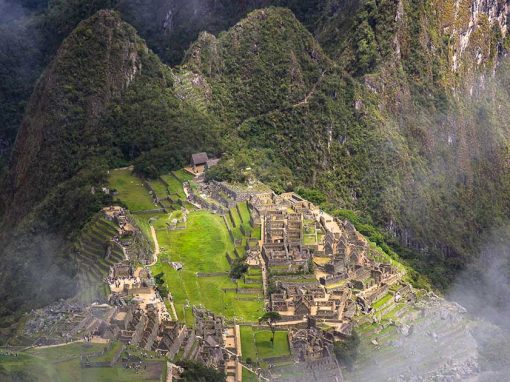
The Best Time to Visit Machu Picchu
Learn about the best time to visit Machu Picchu before you plan your trip with our comprehensive guide.

The 20 Best Things to Do In Peru (Chosen by Experts!)
Discover all of the incredible things to do in Peru, from hiking the famous Inca Trail to Machu Picchu to swimming with sea turtles in Mancora. Your Peruvian adventure awaits!

Start Planning!
Explore all our best-selling packages
See All Packages
Book With Confidence
We're flexible! Postpone your tour with zero cost up to 10 days prior to departure.
The following preferences are optional , but will help enhance your trip's customization.
Are you interested in visiting the best restaurants in Latin America?
Book with confidence
We're flexible! Postpone your tour with zero cost up to 10 days prior to arrival with open dates
( Optional. You may choose more than one)
TIP: Tell us the destinations you have in mind.
- Tour Packages
- Amazon Rainforest
- Galapagos Islands
- Sacred Valley
- 5000+ Reviews
- Travel Guides
- Work With Us
- Responsible Travel
Rely on our expert services to customize a unique experience. Comfortable hotels, tours, and all transportation. 24/7 in-trip support.
Our Peru For Less Travel Blog is a living library of travel information, knowledge, and advice from a group of travel loving experts who live, work, eat, and breathe all things in South America.
"Our tours are Fully Customizable and leave 365 days a year!"
- Destinations
1-817-230-4971
Sales & travel support
Best time to visit Peru

The best time to visit Peru is between May to October for the dry season. Although this time of year looks different for each geographical area of Peru, it is generally categorized by sunny, dry and clear weather, perfect for trekking, exploring or sightseeing. If you’re looking for an action-packed expedition through the higher regions, this time is devoid of the muddy paths and rain that are prevalent in the wet season. But you’ll still find the lower regions full of wildlife, festivals and fun.
The best time to see Machu Picchu is from April to September during the dry season, when it’s not quite as slippery on the trails. While the period of June to August is the busiest tourist time, going before or after means slightly cooler temperatures but fewer people to share the trails with.
Located in the Andes Mountains, northwest of the city of Cuzco, Machu Picchu was likely built sometime around the mid-15th-16th century by the Incas. This ancient mountain fortress contains a palace, temples and other significant city buildings for the Inca population who resided in this archaeological phenomenon.
The best time to visit Lima, the capital city of Peru, is between December to March when the coastal climate is at its best. Temperatures sit around 86°F and the city is alive with bars, notable restaurants, concerts and cultural events. Things to do in Lima include strolling through the Museum of Art (MALI), meandering through the Bosque El Olivar (Olive Tree Forest) and sightseeing along the Pacific coastal pathway known as the malecón.
However, don’t let the weather and seasonal fog that rolls in from June to August keep you away. There are plenty of festivals and fun-filled adventures to be had during the other times of the year, including the Lima Pride Week (around June to July) and the Mistura Food Fair in September.
Visit Cusco between June to August for the best weather in the mountainous climate region and delight in the wonders of the ancient world. Cusco’s elevation sits at around 11,152 feet above sea level so it’s best to visit during the dry season to avoid the heavy rainfall and snow that accompanies the wetter months.
Cusco, or Cuzso, is the oldest continually inhabited city on the South American continent. It is home to archaeological marvels such as Inca temples and their wonders found at the Museo Machu Picchu alongside the stunning La Catedral and the start of the Inca Trail .
Best for: visiting beaches, surfing, sea lions, Año Nuevo, Anniversary of Lima
Keen on some sun, sand and surf? January is the best time for visiting Peru’s scenic coastal spots and the many unique sights around the rest of the country. Book a trip to Islas Ballestas to see the birth of the new generation of sea lion pups or head slightly inland for a glimpse of the archaeological site the Nazca Lines.
Best for: Pisco Sour Day, Carnaval, beaches, surfing
The first Saturday of February is National Pisco Sour Day. Celebrate Peru’s national drink the local way with a glass of this cool, creamy and citrusy cocktail loved worldwide! You’ll find that beaches are in and the mountains are out during February as the famed Inca Trail is closed for cleaning. Other tracks within the Andes are open but they may be rather muddied from rain. The end of February brings the start of the world-renowned Carnaval celebrations. If partying in the streets and the odd water fight is your idea of a good time, head to Cajamarca for a celebration you’ll remember!
Best for: Semana Santa, Festival de Varano Negro, bird mating season, orchids in bloom on the Inca Trail
Several exciting festivals fall in March including Semana Santa (Holy Week) and the Festival de Varano Negro, the celebration of African culture in Peru. March is a great time to head away from the cooling coastal towns and be immersed in the Peruvian wilderness. Since the summer visitors have departed, you’ll be able to snatch up off-season prices.
Best for: river wildlife watching, hiking in the Andes, Festival de las Cruces, Noche en Blanco, Q’oyoroti
Savour some of the greatest experiences that Peru has to offer in May before the holiday crowds arrive. Take a tour along the Amazon River and cast your eye for local wildlife or take a gander at the Inca Trail to see one of the new Seven Wonders of the world, Machu Picchu.
Best for: Q’eswachaka, Inti Raymi, Feast of St Peter and St Paul, Corpus Christi, Lake Titicaca
June is filled with unique cultural festivals and is a thriving time for tourism. Although it is the busiest time of year, the weather is greatly suited for trekking through the Andes or exploring the Amazon jungle via foot or boat. Why not visit one of Peru’s most scenic inland sights at Lake Titicaca and see the unique floating islands, known as Islas Uros.
Best for: National Independence Day, La Virgen del Carmen, hiking in the Andes and riverboat expeditions
The party is on from the 28 to the 29 of July for Peru’s National Independence Day. The streets are bustling with folk music, dancing, fireworks and more as the locals celebrate their over (200) years of independence. However, if you’re looking for a more serene experience, find yourself exploring the Amazon basin or the cultural landmarks that are scattered throughout the country. Take note that sometimes July will see snowfall at higher altitudes.
Best for: hiking, riverboat journeys, Feast of Santa Rosa de Lima, Sacred Valley
August brings the end of the high season, and an average temperature of 68°F sees a perfect time for outdoor adventuring. Explore the wonder of Peru’s Sacred Valley by venturing to the Pisac or Ollantaytambo Ruins of ancient Inca civilizations.
Best for: Mistura festival, rainforest trekking, wildlife watching
Springtime in Peru is an excellent moment to visit the most popular sites without competing for your view. September is also home to the celebration of Peruvian local cuisine with the festival Mistura. Try an assortment of unique and native flavors over this 10-day event. If you’re looking for a good time to venture into the Amazon rainforest, take a trip to the city of Puerto Maldonado, known as the gateway to the southern Amazon jungle for wildlife tours.
Best for: Battle of Angamos Day, animal sightings, boat tours along the Amazon River
October sits within the shoulder season for tourism in Peru. If you’re keen on surfing the waves at one of Peru’s best beaches, October is a great month to strap on your surfboard. Animal lovers should get their binoculars ready for wildlife sightings on boat rides exploring the city of Iquitos or Puerto Maldonado.
Best for: Virgen de la Candelaria, surfing at Puerto Chicama, All Saint’s Day
November marks the time you may want to avoid the Northern areas of the country due to heavy rain and snow as it’s the start of the rainy season. But if you’re looking for a dose of history, culture and fun, join in the celebrations during Peru’s largest festival, Virgen de la Candelaria. Held in the city of Puno in the southeast of the country, this festival combines Peru’s catholic and indigenous communities with costumes, masks, dancing and folk music.
Best for: relaxing on the beach, Fiesta de la Purrísma, Noche Buena
Summer temperatures make Peru in December an ideal place for beach lovers. But if you’re keen on adventure, why not take a day trip and spot some wildlife on the Ballestas Islands or join in on the coastal water sports while the rainy season plays out in the higher regions? Christmas celebrations around the country get into full swing during Fiesta de la Purrísma Concepción and Noche Buena just before Peru brings in the New Year.
Let's create an exclusive trip for your group.
From heartache to hiking boots in Peru’s Sacred Valley
The top 10 destinations to travel in May 2024
Machu Picchu or Chichen Itza? Which historical site should you visit?
10 ways to get closer to nature with Intrepid
What to expect on an Intrepid Premium trip
What it’s like spending the night in a homestay on Peru’s Lake Titicaca
8 offbeat trips to escape the crowds in 2023
9 ways to get to know a place through multi-active adventures in 2023
- Best Time of Year to Visit Peru and Machu Picchu
Peru Weather and Climate
The mysterious city of machu picchu (adventure life), when to visit the andean highlands (machu picchu, cusco, sacred valley, and the inca trail), when is the best time to visit machu picchu , machu picchu month by month.
- The weather in Machu Picchu and the Andean mountains of Cusco is rainy.
- Landslides on the Inca Trail may occur during this month, making hiking not advisable.
- Temperatures range between 27°C/80°F during the day and 17°C/63°F at night.
- Considered the worst time to visit Machu Picchu due to heavy rains and unbearable weather.
- The Inca Trail closes for maintenance, and the risks of getting stuck due to landslides are high.
- Temperatures range from 28°C/82°F during the day and 18°C/65°F at night.
- Recommended for hiking tours, as the rains start to subside, and beautiful views emerge.
- Temperatures range between 27°C/81°F during the day and 17°C/64°F at night.
- One of the best months to visit Machu Picchu, with warmer weather and fewer crowds.
- Ideal for hiking the Inca Trail or alternative treks.
- Temperatures range from 22°C/77°F during the day and 14°C/61°F at night.
- The arrival of the dry season brings blue skies and breathtaking views.
- Festivities in Cusco and traditional Andean religious celebrations take place during this month.
- Temperatures can reach high 20s°C/70s°F during the day and drop to 13°C/55°F at night.
- The start of the high season with thousands of tourists for winter solstice celebrations.
- Temperatures range between 20°C/58°F and 11°C/52°F during the day and can get below freezing at night.
- Full swing of winter with blue skies and impressive views.
- Crowded with tourists from the Northern Hemisphere during summer vacations.
- Temperatures range from 19°C/66°F during the day to 10°C/50°F at night.
- Fairly cold with lengthy lines and overcrowding on hiking trails.
- Recommended to climb Machu Picchu or choose alternative treks for a quieter experience.
- Temperatures range from 20°C/68°F during the day to 12°C/54°F at night.
- End of the dry season and beginning of the rainy season.
- Fewer crowds and beautiful views before the first rains of the month.
- Temperatures range from 21°C/70°F during the day to 12°C/54°F at night.
- Considered one of the best months with fewer crowds and silence in the Sanctuary.
- Ideal hiking weather with temperatures between 22°C/72°F and 12°C/54°F.
- Start of the rainy season with scattered showers and dwindling tourist numbers.
- Great photo opportunities of mountains and valleys.
- Temperatures range from 24°C/75°F during the day to 13°C/54°F at night.
- Weather is touch-and-go with some sunny days amid looming rain clouds.
- Fewer crowds on the Inca Trail but increased tourist activity during the holidays.
- Temperatures range from 26°C/79°F during the day to 16°C/61°F at night.
Machu Picchu Weather Table
Best time to hike machu picchu, when to go on a sacred valley tour, trek through the amazon (valeria blanc) when to visit the amazon jungle.


When to Visit the Pacific Coast & Lima
Want to go.
- South America
- Machu Picchu
Peru Travel Guide
- All Peru Trips
- Peru Travel Info
- Luxury Peru
- Inca Trail Frequently Asked Questions
- Hiking the Inca Trail
- Skylodge Adventure Suites
- Sacred Valley
- History and Culture of Peru
- Peru Amazon Rainforest - Cruises & Eco Lodge
- Machu Picchu & Galapagos Tours
- Machu Picchu Travel Guide
- Peru Food Guide - Brief Guide to Peruvian Gastronomy
Favorite Peru All Trips
- Machu Picchu by Train
- Classic Inca Trail
- Islands and Incas
- Choquequirao Trek and Machu Picchu
- Incas and Rainforest
- Discover Peru
Top Peru Travel Destinations
- Aguas Calientes (Machu Picchu Pueblo)
- Lake Titicaca Peru
- Ollantaytambo
- Puerto Maldonado
Peru Trips by Departure Date
- 2024 Peru trips (123)
- 2025 Peru trips (109)
- 2026 Peru trips (69)
- April 2024 (95)
- May 2024 (109)
- June 2024 (110)
- July 2024 (108)
- August 2024 (109)
- September 2024 (106)
- October 2024 (108)
- November 2024 (105)
- December 2024 (106)
Top Experiences in Peru
- Peru Land Tours (55)
- Peru Wildlife & Safari Exploration (45)
- Peru Cruises (34)
- Peru River Cruises (29)
- Peru Active (20)
- Peru Luxury (16)
- Peru Trekking (15)
- Peru Cultural (9)
- Peru Most Popular (4)
Peru Trips by Duration
- 5 day trips (15)
- 7 day trips (9)
- 8 day trips (13)
- 9 day trips (5)
- 10 day trips (8)
- 11 day trips (3)
- 12 day trips (5)
Peru Trips by Activity
- Peru wildlife viewing (51)
- Peru rainforest exploration (43)
- Peru local market visits (40)
- Peru village visits (37)
- Peru archaeological site visits (36)
- Peru kayaking (34)
- Peru hiking (30)
- Peru fishing (18)
- Peru camping (17)
- Peru wilderness lodge exploration (14)
- Peru homestays (6)
- Peru biking (6)
- Peru small ship cruises (6)
- Peru whitewater rafting (4)
- Peru snorkeling (3)
- Peru horseback riding (3)
Why Travel With Adventure Life
Recognized by.

- Deutschland
Best Time To Visit Peru

A handy guide to Peru’s seasons
While Machu Picchu and Lima are generally considered the best places to visit in Peru , there numerous other destinations that are worth a visit, if you travel during the right season.
The dry season from May to September is recommended as the best time to visit Peru. Temperatures range from 60°F to 85°F (16°C to 27°C), which is especially ideal for those who want to explore the countryside. During this time, the weather is splendid, with sunny days and clear blue skies. However, booking in advance is essential due to the heightened demand during the peak season.
Expect a variety of climatic zones during your Peru vacation. The lands stretch over a vast distance from the north to the south. There is also a significant difference in altitude between the coastal areas and the Andes. Thus, the climate of Peru differs greatly from one region to another. Here is an overview on the weather to help you plan your Peru luxury tours .
Best Time To Visit
We recommend.
- Welcome the New Year in an unusual fashion at Huancayo – with traditional dances and plenty of dress-up
- Head to Trujillo’s national dance festival, the Fiesta de la Marinera
- Be surrounded by music and color at the Virgin of Candelaria Feast in Puno
- Join in water fights at the Carnaval festival in Cajamarca
- Soak up some sun at Mancora
- Marvel at the colorful street art in Lima
- Explore the Amazon rainforest by boat
- Watch unforgettable sunsets from the upscale, beachfront district of Miraflores in Lima
- Witness colorful processions during the Semana Santa festival in Ayacucho
- Test your stamina at Huaraz, Peru’s trekking mecca
- Give in to the charms of the White City – Arequipa.
- Join the colorful Inti Raymi festival in Cusco
- Set off on a boat ride in the sapphire blue waters of Lake Titicaca
- Trek the famous Inca Trail and marvel at the ruins of Machu Picchu
- Stay in the midst of nature as you explore the Amazon from Iquitos
- Take a horse ride up the Rainbow Mountains
- Sample fresh ceviche at one of Lima’s awardwinning restaurants
- Hop on the Andean Explorer and discover the beautiful Peru countryside by train
- Head to Chiclayo and Trujillo for a fascinating history lesson
- Gourmands head to Lima’s Mistura Food Festival – one of the biggest in Latin America
- View the Amazon rainforest from high above on a canopy bridge walk
- Puno Festival week beckons with folk dances and festivities
- Ride the waves at Mancora
- Enjoy beautiful displays of nativity scenes in Cusco
- Solve the mystery of the Nazca lines
- Work on your tan at the untouched beaches of the Paracas National Reserve
Best Time to Visit Peru by Region
Climate of coastal peru – lima, chiclayo and trujillo.
- Summer: December – March
- Winter: June – September
The weather on the coast of Peru is greatly influenced by the cold Humboldt current. During summer, temperatures range between 77-83°F on the northern coast while in winter, they dip to 50–59°F. The weather is more moderate in the South. During summer, the temperature in Lima rises to 77 while in winter, it dips to 59°F.
What to pack: Comfortable shoes and sun protection (sunglasses, hat and suntan lotion)
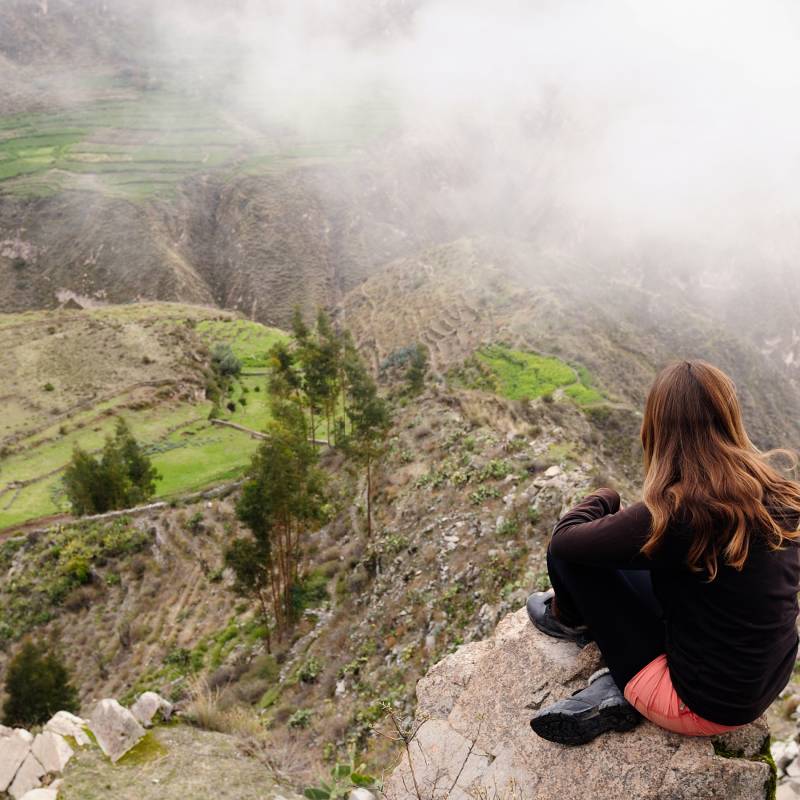
Climate in Peru Highlands – Cusco, Machu Picchu, Puno, Arequipa, Colca Canyon
- Dry Season: April – November
- Rainy Season: December – March
The climate in the Andes depends entirely on the altitude with two main seasons, dry and rainy. The best time to travel to Peru Highlands is between May to October when the skies are clear. Temperatures range between 32 to 85°F in the dry season and 41 to 68°F in the rainy season.
What to pack: Comfortable hiking boots and clothing that can be used for layering. A warm jacket is ideal for the chilly evenings.
Climate in Northern Peru – Cajamarca, Leymebamba, Chachapoyas
- Dry Season: May – September
- Rainy Season: October – April
It is easy to differentiate between the dry and rainy seasons in Northern Peru. Since Cajamarca, Leymebamba and Chachapoyas lie in remote areas, a trip to these destinations is not recommended during the rainy season. The best time to travel to Northern Peru is from May to October when temperatures range between 59 and 77°F.
What to pack: Waterproof jacket, comfortable hiking boots, sunglasses, hat and cream. A warm jacket or fleece is recommended for the evenings.
Climate in Northern Peru: Mancora
In Mancora, the temperatures rarely drop below 64°F and go above 90°F throughout the year.
What to pack: Sunglasses, hat and suntan lotion, swimwear, sandals.
Climate in the Peruvian Amazon Jungle – Puerto Maldonado, Iquitos
- Dry Season: May – November
- Rainy Season: December – March
The Peruvian Amazon also experiences two distinct types of climates, the dry and the rainy seasons. During the dry season, temperatures can rise as high as 80°F and it is considered to be the best time to visit Peru, while in the rainy season, heavy showers occur at least once every day. The region experiences high humidity levels throughout the year.
What to pack: Light cotton clothing with long sleeves and trousers to protect you from insect bites. A waterproof jacket is ideal, as are comfortable walking
From the Blog
All aboard luxury train ride in the peruvian andes.
How about a luxury train ride through the towering Andes Mountains? Embark on one of the last great adventures! The Belmond Andean Explorer takes you on a journey along one of the world’s highest rail routes to discover the breathtaking beauty of the Peruvian Andes. Travel with elegance and style on a glamorous rail journey that…
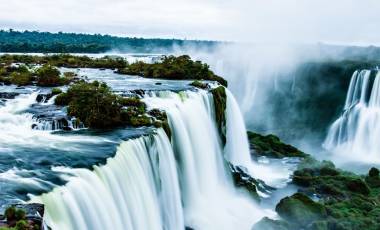
Iguazú Falls – The World’s Largest Waterfalls
It is often said that Argentina provides the show and Brazil enjoys the view of the Iguazú Falls, with Brazil dominating the panoramic side having several viewing walkways! So, which is the best side?
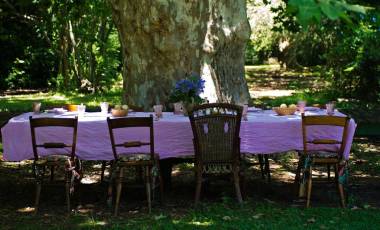
Top Tips for Tipping in South America
There are many cultural norms when you travel in South America. How you tip is just one of them. Whether you wish to tip at a restaurant, cafe, in a hotel or your driver, check out our top tips for tipping before you embark on customized South America tours.
Popular Trips to Peru

Peru: Lima, Rainforest and Machu Picchu
Delve into the natural beauty, culture and history of Peru over the course of 11 memorable days. Savor the culinary delights of Lima after a day of exploring its colonial architecture. You might find yourself taking plenty of pictures as you admire the scenic landscapes and wildlife around Puerto Maldonado. Round off your Peruvian vacation…
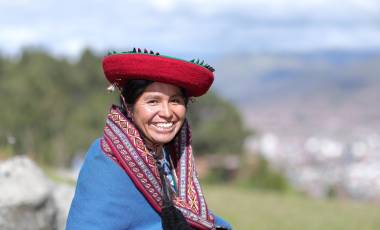
Peru: Traditions of the Sacred Valley
Go off the beaten track at Peru’s Urubamba Valley, or the Sacred Valley of the Incas, and discover a unique cultural landscape and communities. Explore historic villages such as Pisac, Ollantaytambo and Lamay, and visit Machu Picchu, Cusco and Lake Titilaka in Puno.
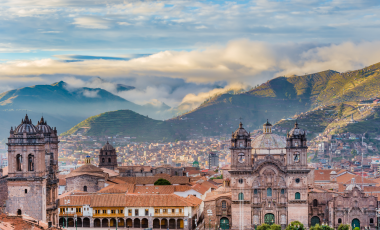
Peru: Luxury Highlights & Belmond Hiram Bingham Experience
Soak in the raw beauty of Peru on this 15-day tour that allows you to experience this stunning country aboard two iconic trains – Belmond Hiram Bingham and Belmond Andean Explorer. Start your exploration in the capital city of Lima, before chugging along past the Peruvian Andes to Cusco on the Andean Explorer. Marvel at…
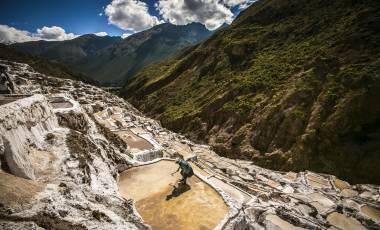
Peru: Explore the Sacred Valley of the Incas
Go back in time as you set off on an exciting journey to the heart of the ancient Incan empire, on this eight-day tour of Peru. Begin your tour in the beautiful capital city of Lima, before hiking up Andean highlands and taking in the splendor of the Sacred Valley. Here, you will stay at…
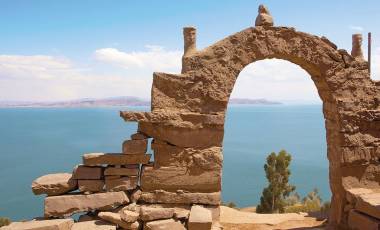
Peru and Bolivia: Ancient Cultures
Uncover centuries-old cultures and lost civilizations on this tailor-made Peru and Bolivia trip. Discover the Inca citadel of Machu Picchu and the colonial city of Cusco in Peru. Visit the floating islands of the Uros in Lake Titicaca and discover the sacred Incan island of Isla del Sol in Bolivia.

Peru: Southern Gems and Machu Picchu
This classic Peru and Machu Picchu vacation will give you incredible insights into the heart of the country. Explore the Nazca Lines and venture into the impressive Colca Canyon in southern Peru. Meet the Uros of glittering Lake Titicaca and finish on the path of the Incas.
Best Places To Visit
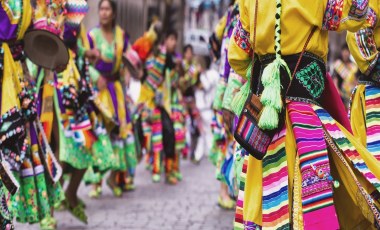
Cusco is a UNESCO World Heritage Site and an amazing amalgam of an Inca capital and colonial city.
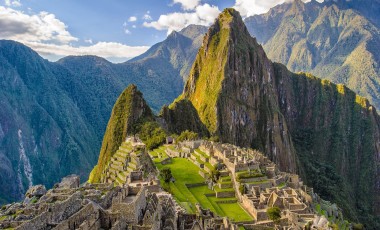
The ruins of Machu Picchu are one of the most beautiful and enigmatic ancient sites in the world.
Machu Picchu Pueblo
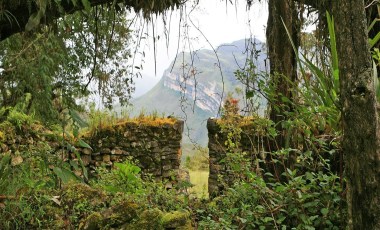
With its unique sub-tropical climate and mountain range scenery, Chachapoyas is a mysterious and remote region where a wealth of archaeological ruins and artifacts still have yet to be unearthed and understood.
Chachapoyas
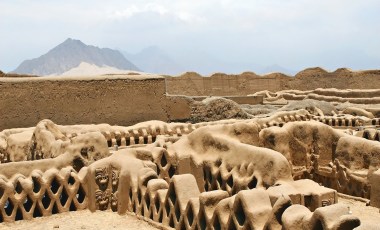
Although Trujillo is less frequented, it is certainly as interesting as Chiclayo.
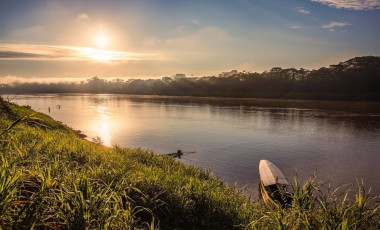
The small city of Puerto Maldonado is located a short distance (by Perúvian standards) away from Cusco, and is the southern doorway to the rainforest.
Puerto Maldonado
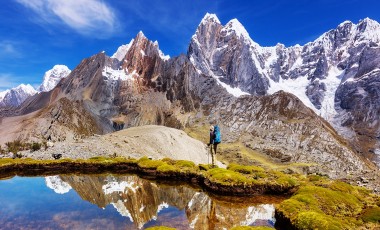
Offering glaciers, scenic lakes and dramatic snow-capped mountains, the Cordillera Blanca is an outdoor enthusiasts dream! Forming part of the larger Andes range, the region is ideal for those searching for active adventure or a relaxing getaway in the mountains.
Cordillera Blanca
Travel guide.
What vaccinations do you need before setting out on Peru holidays? How do you make payments in Peru? How can you protect yourself from altitude sickness? Discover all this and more by following this link.
Things To Do
Mystical ruins, indigenous communities and floating islands – Peru is brimming with treasures. Follow this link to see our list of top ten things to do.
The safety situation in Peru has steadily improved in recent years. The country benefits greatly from its growing tourism sector and therefore, local authorities take travel safety issues very seriously. Here are some safety tips for stress-free Peru holidays.
The Enchanting Difference
Authentic & unique.
Our award-winning, licensed local guides provide incredible insights and exclusive experiences for you.
Personalized & Private
Our experts completely customize your private tour to match your interests and preferences.
High-Quality Experiences
All our accommodations and services are personally tested by our team.
Fully Supported Travel
You’ll have a personal and dedicated trip coordinator, backed by 24/7 support in case of emergencies while you’re traveling.
Financial Protection & Flexibility
Your booking is flexible and completely secure with us.
Safe & Secure
Your safety and well-being are our top priorities.
What Our Guests Say
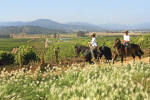
Do you have a vacation in mind? Personalize your itinerary with our Trip Builder.
The Best Time to Visit Peru
If you are planning a trip to Peru then you have already picked a spectacular location! All that is left is to make sure that you make the most of what this country has to offer. To figure out when the best time to visit Peru is for you, there is one important factor that you must take into consideration: the weather.
The best time to visit Peru also depends upon which part of the massive country you are planning to see, and what activities you want to do.
The Only Peru Guide Expert Tip
Do NOT miss Huacachina Oasis on any trip to Peru. This sunny-all-year-round place must be seen to be believed and is Peru’s fastest-growing destination outside of Machu Picchu. Companies like Peru Hop run day trips to Huacachina for those who plan to fly within Peru.
There are 3 regions of Peru : The Coast, The Highlands and the Amazon Jungle. In order to be fully prepared for your travels, it is important to understand how climates can vary in the regions throughout the year. For a full, in depth analysis of the weather in the amazon , find our blog.
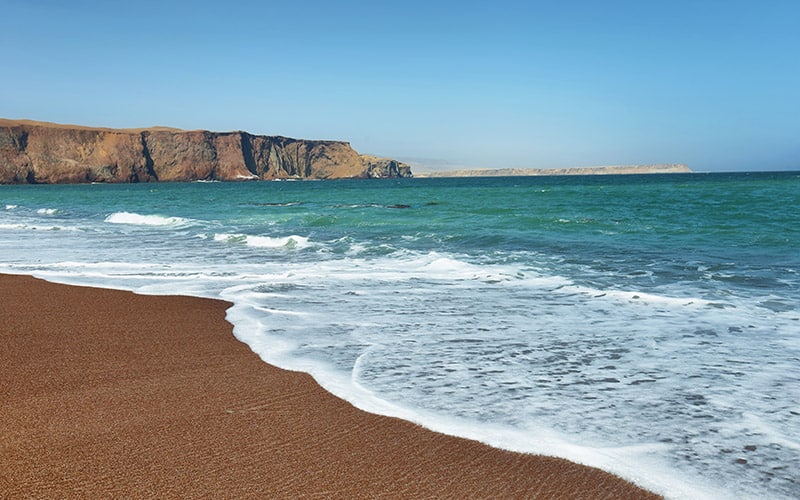
Peru has two seasons owing to its proximity to the equator. These are not traditionally known as summer and winter, but as the rainy/wet season (‘summer’) which runs from December to March, and the dry season (‘winter’) which runs from May to September. The months in between can be unpredictable but are a mix of both, with more sun than the dry season and less rain than the rainy season.
The rainy season gets its name because of the extraordinary amount of rain that falls on the highlands and in the jungle. The coast is a little different, as it typically experiences minimal rainfall even during the rainy season. Consequently, the dry season on the coast is known as garua season: classified as mostly dry overcast weather, with occasional drizzling rain. The rainy season is extremely hot, and known as the summer months.
Visiting Peru in the Summer- December to March (Peru’s Rainy Season)
The rainy season is actually the warmest time in Peru, as well as being the wettest season. With frequent rainfall in the highlands and the jungle, some of the major trails for travelers close because of this, including most of the Machu Picchu treks , like the Salkantay trek . If you’re here for the Inca trail , February is not your friend.
The Peruvian Andes in the Summer/ Rainy Season
You are likely to see a great amount rainfall in the highlands and in the jungle of Peru. The rainy season (summer) isn’t the best time to visit Peru if you’re looking to trek in the mountains; as many paths simply become rivers, leaving them unwalkable; you will find that many trails close during this time. Be sure to check the availability of your chosen route before setting off. You can do this, and compare prices, at the website Find Local Trips .
During the wet season in the Andes Mountains (including Cusco ), the average temperature is around 18˚C (64˚F). At night the temperature drops to around 7˚C (44.6˚F). Even though heavy rainfall and regular thunder and lightning is guaranteed, the clouds will eventually part and grey skies will transform into sunshine. This is a beautiful sight, if you can wait out the storms.
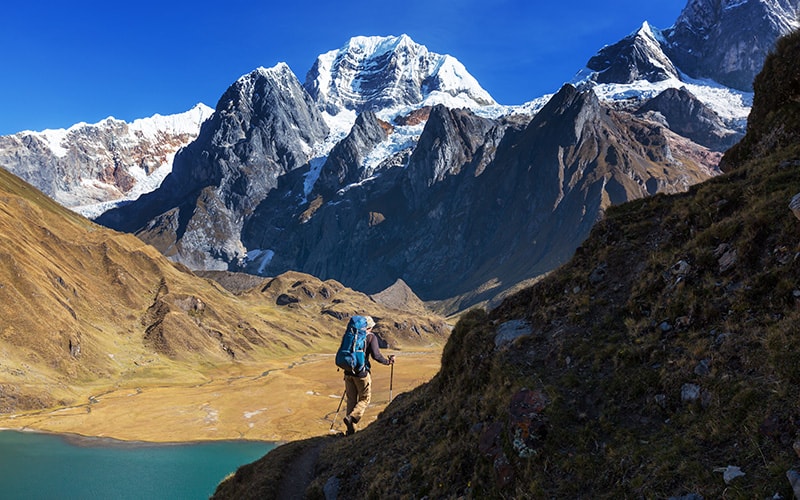
All in all, a general rule of thumb is that the rainy season (‘summer’) in Peru is not an ideal time for trekking up in the Andes Mountains but it is the perfect opportunity to take advantage of the sun along the Pacific Coast, where temperatures and the weather are generally stable thanks to the desert climate.
The Peruvian Coast in the Summer
These months are the perfect opportunity for sunning yourself along the coast, where temperatures are much higher than the highlands of the Andes, and dry days are all but guaranteed. In the capital of Lima there is an average of only one day of rainfall through the whole year.
The Pacific Coast is generally warm, and can get very hot depending on the place. ( Huacachina , the only desert oasis in South America, boasts high temperatures all year round). The highest average temperature along the coast in summer ranges between 24˚C (75.2˚F) and 29 °C (84.2 °F), but can reach up to 32° (89.6°F). The capital of Peru, Lima, has beautiful sunny days through all of the summer months. AS well, Mancora in the north gets beautiful sunshine with high temperatures all year round. If you like hot weather, these are great places to spend summer in Peru.
The Peruvian Amazon in the Summer/ Rainy Season
For a full in depth look at the weather in the Amazon , check out our blog.
In the Amazon region , it is hot and rainy for most of the year. It’s worth noting that the rain in the jungle probably isn’t what you’re used to at home, it is incredibly heavy, and not the sort of weather you can just pop a waterproof on and continue through.
Generally in the rainforest temperatures stay similar throughout the year. However in summer temperatures rise a little and can reach as high as 42 °C (107.6 °F) (in Iquitos ), with heavy rainfall causing river levels to rise. This isn’t all bad though, as the increased river levels make it easier for boats to venture deep into the jungle. This gives you a greater chance of seeing spectacular and unique wildlife (including the famous pink river dolphin). It is also worth knowing that the rainy season in the jungle is mosquito high season. Make sure that while you’re packing you have plenty of repellent, long and loose clothing, and are up to date on your yellow fever injection.
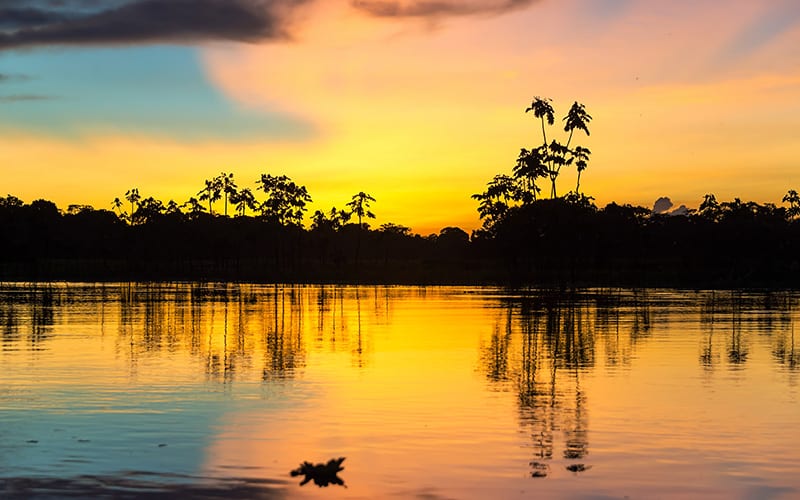
Visiting Peru in the Winter (Dry Season)- May to September
If you’re planning to travel the whole country, the best time to visit Peru is, surprisingly, the winter. This is the driest season in Peru, which is especially important if you are planning to visit Cusco, trek the Rainbow Mountain or a Machu Picchu trail, such as the Inca trail.
Visiting the Peruvian Andes in the Winter (Dry Season)
One of the main attractions of Peru is Cusco and Machu Picchu. Cusco is situated high in the Andes mountains (with an elevation of 3,400 meters). From May to November it is generally dry in the Andes. Temperatures in the highlands have a wide range, especially between the day and the night. During the day they sit around 20˚C and through the night they drop as low as 2˚C through the winter.
Also worth noting, the majority of buildings in Peru have no built-in heating. We advise you to be well-prepared for the cold in winter when in places such as Cusco, high up in the Andes Mountains. It can get very cold there, especially during the evenings and early mornings.
Despite the cold, these might also be the brightest months that Cusco has to offer as the clear, sunny skies shine through the day. Packing light may seem difficult, but why not wait to purchase some warm clothing in the indigenous markets of Cusco? Famous for its vibrant alpaca-wool scarves, hats and jumpers, this is the perfect place to get souvenirs for your friends and family, as well as a treat for yourself as well.
Visiting the Peruvian Coast in the Winter (Garua Season)
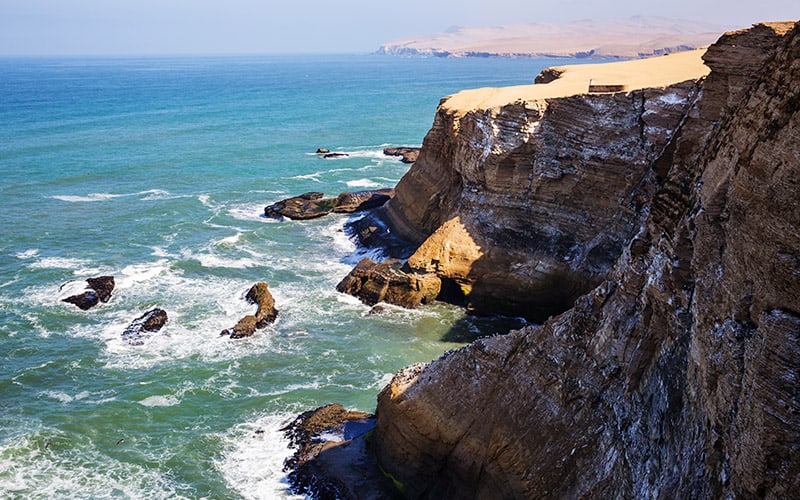
Unfortunately, during winter in Peru the skies along the pacific coast are typically very cloudy. Some locals know Lima as ‘The Grey City’, due to the thick layer of fog that lingers over the coast between the months of May, right through to October. Despite the cloud, the coast of Peru is particularly humid with an average of 80% humidity. The highest average temperatures range from 15˚C (59˚F) and 21 °C (69.8 °F), and lowest between 8˚C (46.4˚F) and 15 °C (59°F).
Visiting the Peruvian Amazon in the Winter (The Dry Season)
Exploring this region is more enjoyable in the dry season. There is less rainfall and temperatures here stay tropical all year, making the adventure even more palatable.
Similar to the Andes, the recommended time to visit the Amazon Jungle is during the dry season, as there are less mosquitos and, most importantly, less rainfall. However, there are also many perks of visiting it during the rainy season thanks to the rise in water levels in rivers.
Ultimately, there are plenty of variables when it comes to the best time to visit Peru. Between the three geographical regions, the two seasons and Peru’s unpredictable climate, there are more than enough factors to consider. The weather in Peru can sometimes be unpredictable, but the rich culture and warm people make up for any logistical snags caused by the weather.
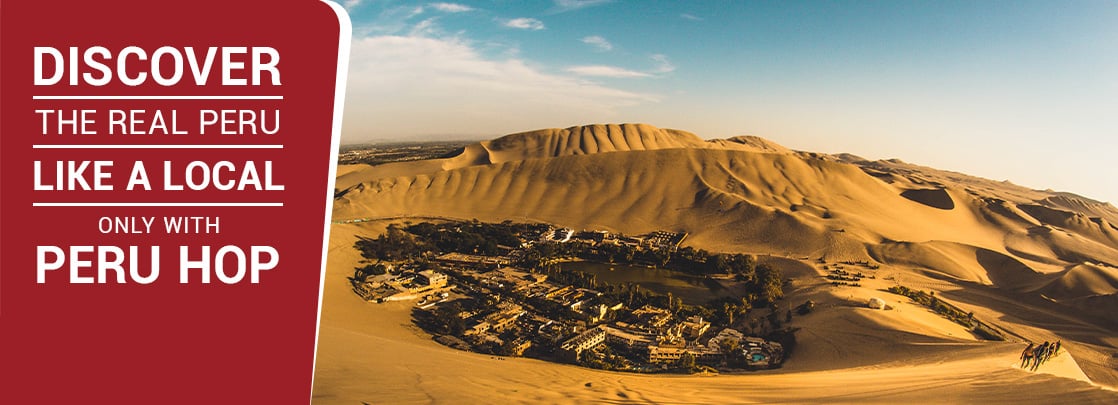
YOU MAY LIKE

Lima to Machu Picchu – Agencies DON’T want you to read this!

#1 Rated Day Trips From Lima To Unforgettable Destinations

Everything You Need to Know to Avoid the Typical Tourist Mistakes At Machu Picchu

What NOT To Do When Visiting Rainbow Mountain

Spend 50% less and see 100% more in Peru

Machu Picchu Tickets – All You Need To Know!

These Hidden Destinations Just Outside Of Lima Will Blow Your Mind!

Peru – How to Avoid Being a Typical Tourist

OFFICIAL: This Company Was Voted The Best Way To Get Around Peru

Peruvian Travel Secrets That Only The Locals Know
You must be logged in to post a comment.
- Work With Us
- Blogging Bootcamp

- Van Conversion Academy
- Campervan Shop
- Campervan Rentals
- Plan a Trip
- Itineraries
- Destinations
- Responsible Travel
- Family Travel
- Budget Travel
- Scuba Diving
- Travel Credit Cards
- Digital Nomad
- Teach English Abroad
- Blogging Resources
- Income Reports
- Travel Shop
- Meet Katie & Ben
- About Two Wandering Soles
- Personal Stuff
- Portfolio & Press
Best Time to Visit Peru: When to Go & When to Avoid!
Home » Blog » Peru » Best Time to Visit Peru: When to Go & When to Avoid!
This captivating country is one of those places that actually lives up to the hype — there’s so much to explore! Comprising multiple distinct ecosystems, there’s a lot to consider when choosing the best time to visit Peru. We’ve broken down each region to help you plan!
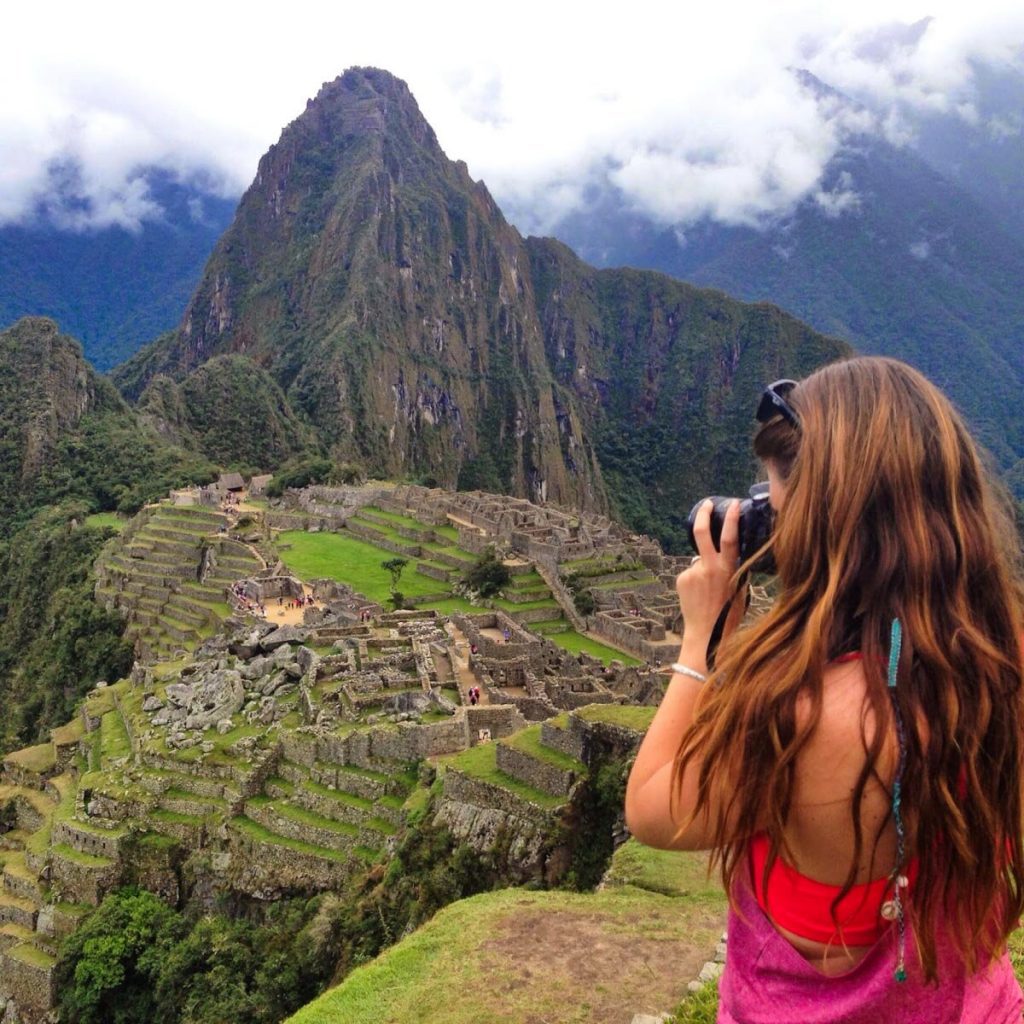
Stunning Peru is an absolute must on any South American itinerary. This nation truly has it all: incredible rugged mountain scenery, jungles, scenic beaches, flavorful food, and a unique blend of culture and history that’s a result of both Pre-Columbian and European influences.
As the third-largest country on the continent, we’re being very literal when we say there’s a lot of ground to cover with so many incredible things to do in Peru . In just a week’s time, you could spot toucans in the lush jungle, trek through high-elevation valleys, and relax on a pristine beach — there’s so much diversity!
Deciding on the best time to visit Peru is an important decision, and one that’s a bit more complex than it initially seems.
When is the best time to visit Peru?
May though September is generally the best time to visit Peru, especially if you’re planning activities like visiting Machu Picchu in the Andes (which we wholeheartedly recommend!).
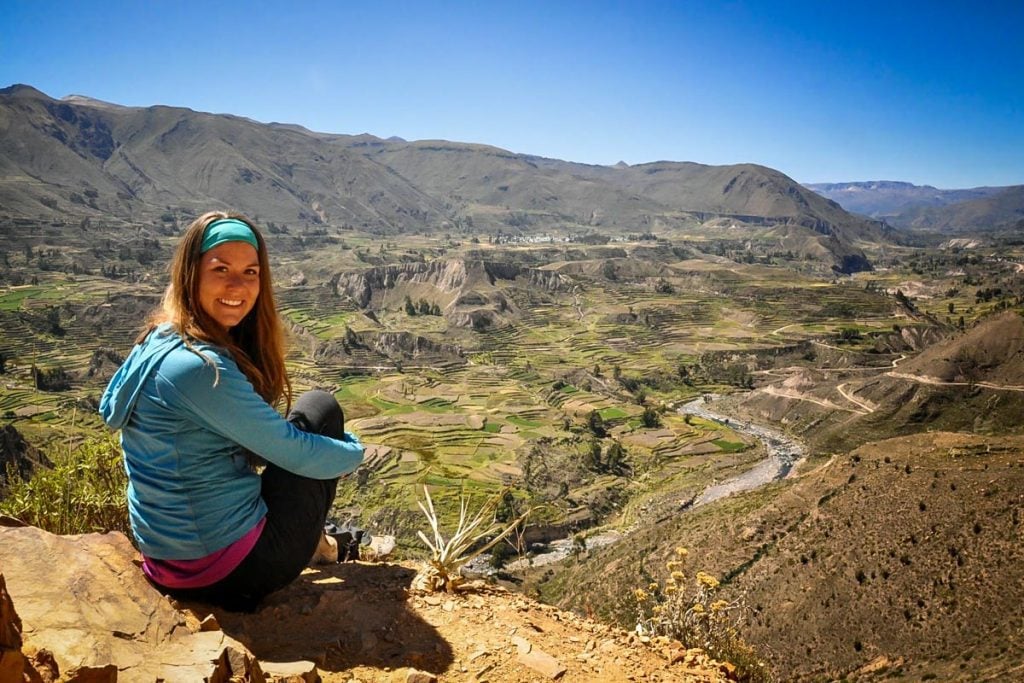
In a country with so many micro-climates, however, the best time to go ultimately depends on the duration of your visit and your specific interests.
The eastern part of Peru is a remote, vast, and rugged jungle, mostly only accessible by boat or plane. Here, it’s almost always rainy and muggy.
In the central highlands, the Andes rapidly rise to crazy-high altitude. The city of Cusco sits at over 11,000 feet, while ultra-popular Rainbow Mountain is at a headache-inducing elevation of 17,000 feet!
As with all high alpine destinations, monitoring weather conditions in Peru is paramount. It can (*does) get cold fast , and storms roll in surprisingly quickly.
Western Peru is largely desert, along with the scenic Pacific coastline, and it’s also the home of bustling Lima , the capital city. Here, the climate is much more stable and in the country’s northern regions, there are even classic beach escapes!
As you can see, there’s a lot to consider when picking the best time to visit Peru for your travel needs. To help you plan your Peru itinerary, we’ve outlined the various seasons in each distinct region, as well as what there is to do and see. That way, your travel plans will (hopefully!) be less affected by rain, fog, and other inclement weather!
Article contents
- Our experience in Peru
- Peru geography overview
Weather in Peru
- Seasons in the Coastal Region
- Seasons in the Highlands
- Seasons in the Amazon
Overall BEST time to visit Peru
Want a quick recommendation? Jump down to see our personal advice for the best time to visit Peru. Plus, we’ll share what times of year we’d avoid visiting!
- Our Recommendation…
Our experience traveling in Peru
We’ve visited Peru in May, September-October and December
Our experience:
- We visited Peru for our first time together in May (2014)
- Our Director of Content, Amanda, has visited Peru in December (2019) and September/October (2022).
Spring in Peru
(fall in the northern hemisphere)
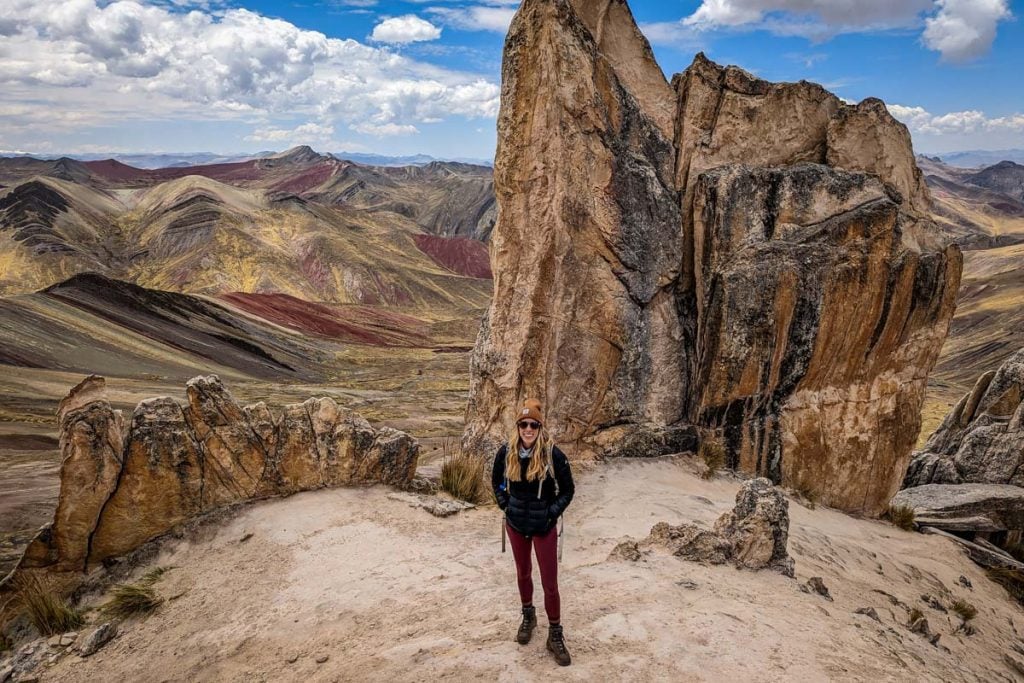
I (Amanda) spent about 6 weeks traveling around Peru in September – October 2022. The majority of that time was spent based in Cusco , but I also visited Lima , Huacachina , the Sacred Valley , and I climbed Rainbow Mountain and hiked the Inca Trail .
Lima in September was overcast and cold for the whole week I was there. The sun never came out from behind the gray cloud cover and given that most of the buildings in Lima don’t have insulation or heat, it was almost colder sitting inside than getting bundled up and going for a walk.
Huacacchina was beautiful and I had great weather for the weekend I visited in September.
Cusco was a lot sunnier than Lima and though the weather wasn’t exactly warm , it was overall a lot more enjoyable.
I hiked in the Inca Trail for 4 days in mid-October. The first day of our hike was sunny, warm and beautiful. However, the following 3 days, including our day at Machu Picchu, were rainy and wet. October is the very start of the rainy season on the trail and while it was still an adventure of a lifetime, I have a feeling hiking the Inca Trail would have been more enjoyable without the rain.
Would we recommend visiting during spring?
That depends… If you are just planning to be in Cusco and the Sacred Valley, spring is an okay time to visit. However, if you plan to spend any time in Lima, you’ll run into dreary weather.
If hiking the Inca Trail is on your itinerary, you’ll want to make sure you go early spring (September), and not wait until October/November when the rainy season is in full swing.
Summer in Peru
(winter in the northern hemisphere)
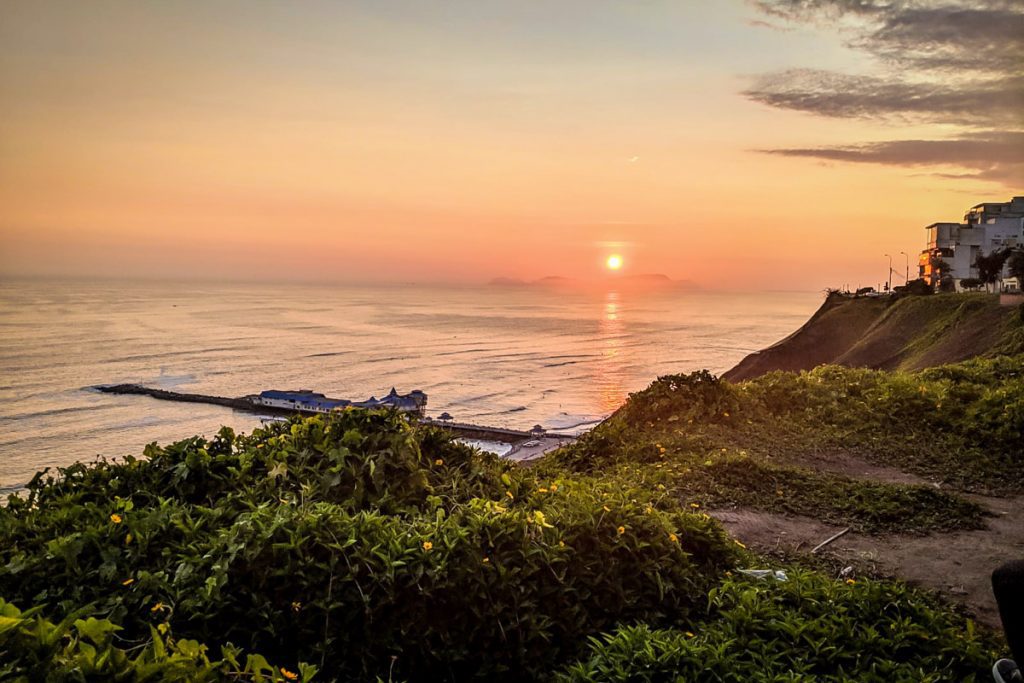
I (Amanda) visited Lima for a week in December 2019 and the weather was decent enough. While it wasn’t exactly warm weather, the sun was out and the city was buzzing with that summertime feeling.
Would we recommend visiting during summer?
Yes! If you plan to visit Lima, summer in the southern hemisphere is a great time to visit. These are the few months in which the coastal weather clears up and you’re likely to see the sun.
*However, if you are hoping to hike the Inca Trail, winter is the peak of rainy season and we would highly recommend skipping it during this time. More on that below!
Fall in Peru
(spring in the northern hemisphere)
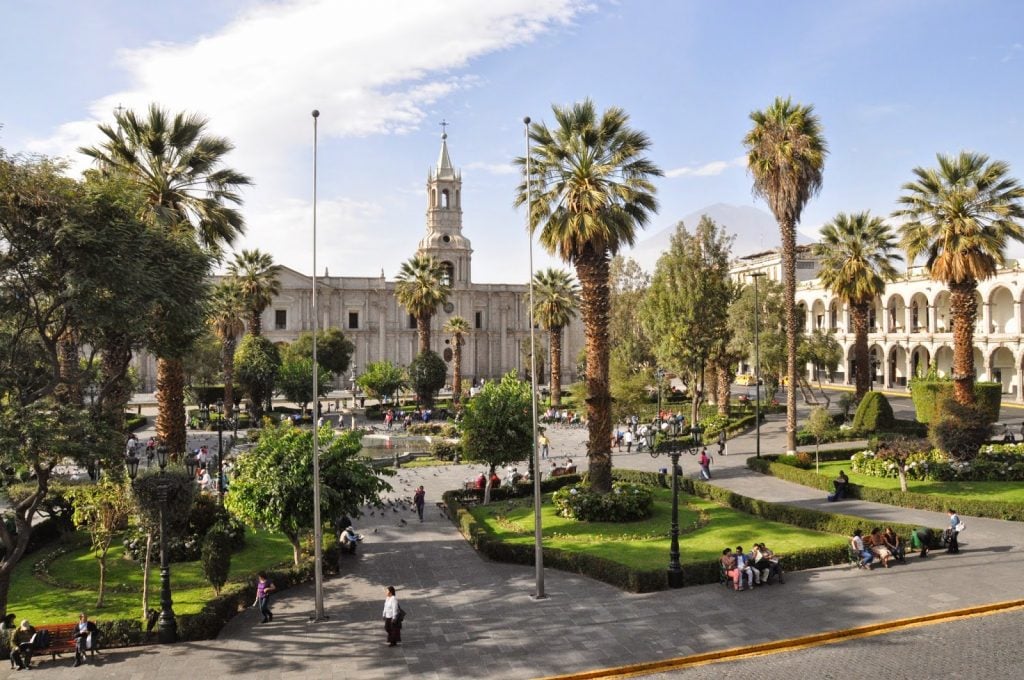
We visited Peru in May 2014 together on part of our first South America backpacking trip. We spent time in Lima, Cusco, Huacachina, Arequipa and hiked the Inca Trail.
We had a great experience in Peru during this time and really lucked out with great weather all around.
Would we recommend visiting during fall?
Yes! If you plan to visit during fall (springtime in the northern hemisphere), May is the best month for optimal weather across the country.
Peru Geography Overview
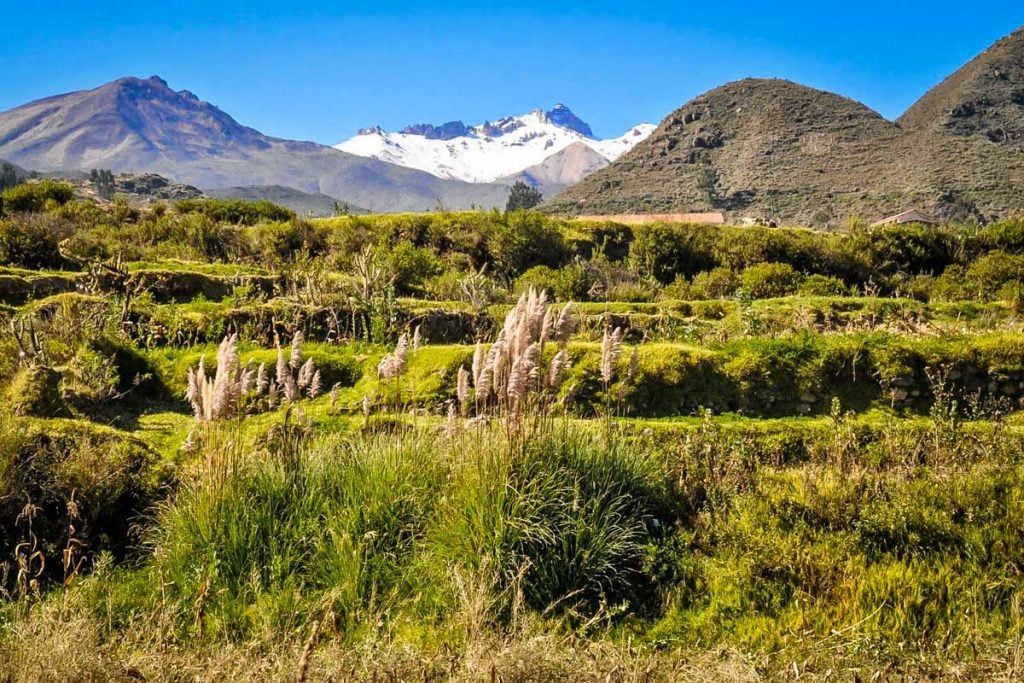
From the iconic Andean peaks to the wet and humid Amazonian lowlands and the barren deserts along the Pacific coast, Peru has three strikingly different ecosystems. Each one offers its own appeals and immersive activities and landmarks to explore.
On the coastline, large swaths of harsh desert are interspersed with lush, fertile valleys. Areas like the Nazca Desert are otherworldly and desolate. However, there are also gorgeous beaches, and hyper-urban Lima is the country’s biggest and most bustling city with a population of over 10 million people!
Further inland, the Andes Mountains soar to dizzying heights. Whether exploring Machu Picchu, lofty Cusco located at 11,000 feet elevation, or the stunning Sacred Valley, this area is Peru’s most famous calling card. The mountains here are dramatic and home to a number of cultural and historical attractions.
On the eastern side of Peru, the Amazon jungle covers a mind-boggling area with very few settlements. Some areas have lush mountains and others are flat and steamy.
It’s a remote corner of the country with unforgettable wildlife, waterfalls, and immersive jungle experiences unlike anywhere else on Earth. The Peruvian Amazon is well worth journeying to if you can find the time in your itinerary.
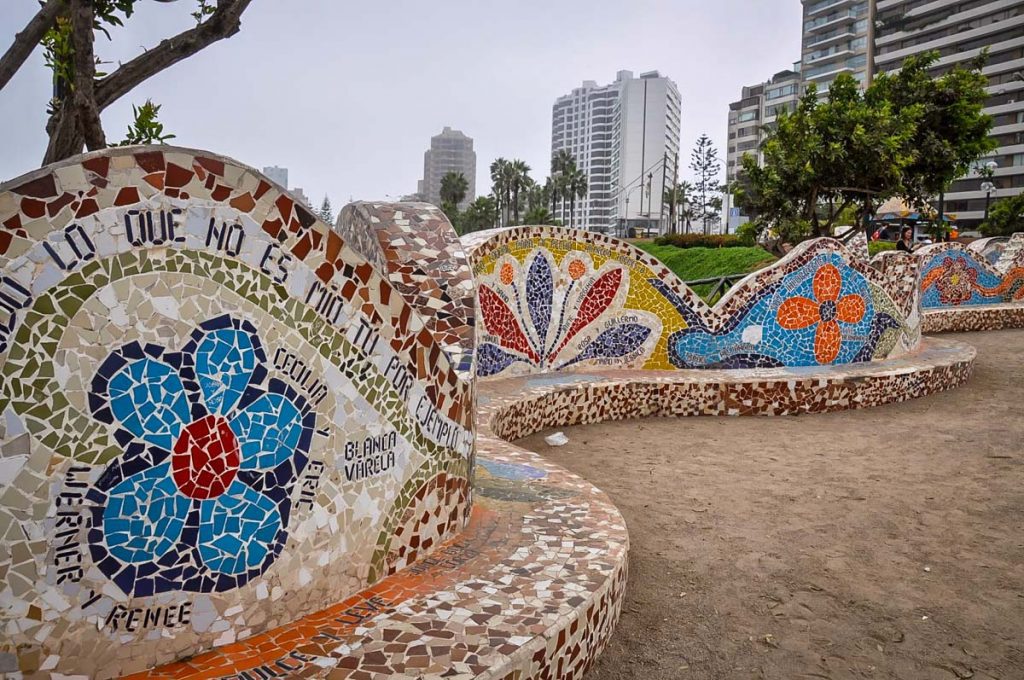
Much like other equatorial countries, Peru has distinct wet and dry seasons. In a country with such diverse typography, these seasons are variable depending on the specific region.
Generally, Peru’s wet season is during the summer, from December to March. (Keep in mind, the summer is opposite of North America, since the country is in the Southern Hemisphere).
The winter is the dry season, with less rain and sunny skies, and chilly temperatures on the coast. For much of the rest of the country, daily highs and lows vary only minimally.
The single notable exception to this is Peru’s coast, especially around Lima.
Here, the dry season is actually during the summer, from November through March, and a cold fog often settles over the city in the wintertime. However, it’s still possible to find some sun on the beach during the winter, and even if you don’t, the gloom is unlikely to interrupt activities.
Since there’s fairly little temperature variation in much of the country during most of the year, we advise primarily considering the climate in the mountains when choosing the best time to visit Peru.
Below you’ll find a break down of the wet & dry season months in each region:
- November – March : Dry season; hot and humid, sunny skies
- May – September : Rainy season; cooler temperatures, gloomy skies, near-constant drizzle
- April & October: Shoulder seasons; weather is unpredictable with varying conditions
- Temperatures are more or less the same in the highlands all year round
- April – November : Dry season; sunny skies
- December – March : Rainy season; high rainfall and humidity
- Humidity is high in the rainforest of Peru year-round
- May – September : Dry season; hotter temperatures and less rain
- April – October : Rainy season; high rainfall and cooler nights
Seasons in Peru’s coastal region
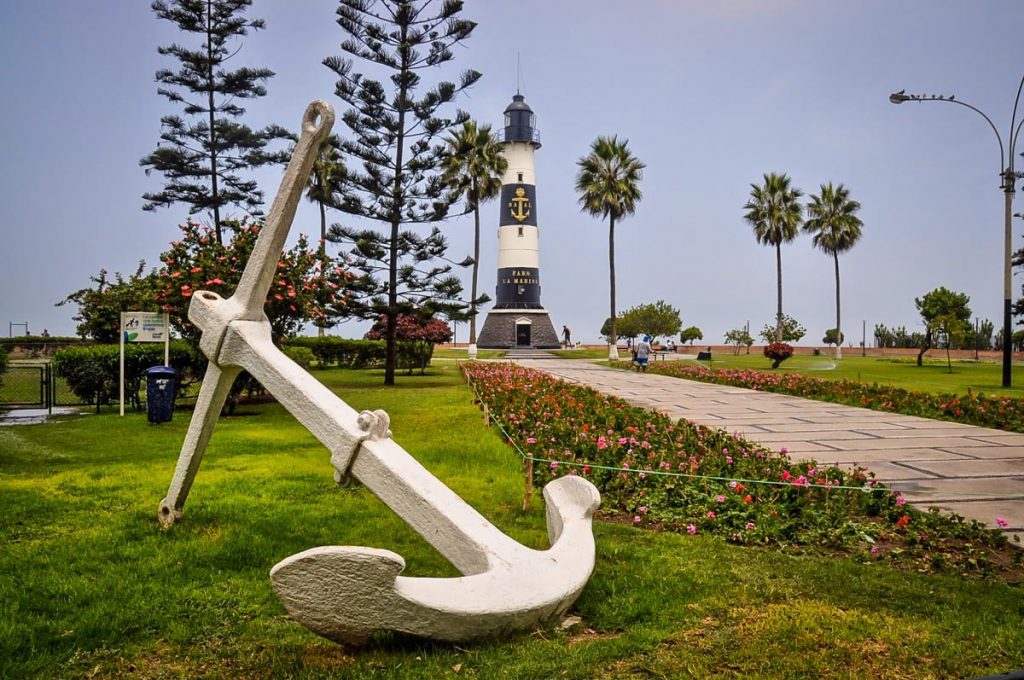
Like the rest of Peru, the coastal region is defined by distinct wet and dry seasons. Especially in Lima, a gloomy gray fog known as La Garua often settles over the city from May to September.
During this time, drizzly rain is frequent, humidity is typically high, and the sun doesn’t come out often. Temperatures drop a bit, but remain mercifully pleasant, with both the highs and lows hovering in the 60s (about 15-20°C).
Certain regions of Peru’s coast, especially up north, manage to escape the dreary weather and retain year-round sun. Even so, if you’d like to see the bulk of Peru’s coastal attractions, it’s better to travel during the dry season, from November to March . There’s much more sun, the water is perfect for swimming, and temperatures rarely exceed 85℉ (30°C).
Best things to do in Peru near the coast
- See the best of Lima highlights on a free walking tour (this is one of our favorite ways to get the lay of the land in any new city!)
- Beach-hop through the otherworldly landscapes of the Paracas Peninsula
- Tap into your thrill-seeking side and try sandboarding in the desert oasis of Huacachina !
- Discover the rich wildlife of the Ballestas Islands
- Take a scenic flight over the mysterious Nazca Lines
- Go surfing right in Lima
- Slow down and relax on the beach in Los Pocitas, or party it up in nearby Menorca
Seasons in Peru’s highlands region
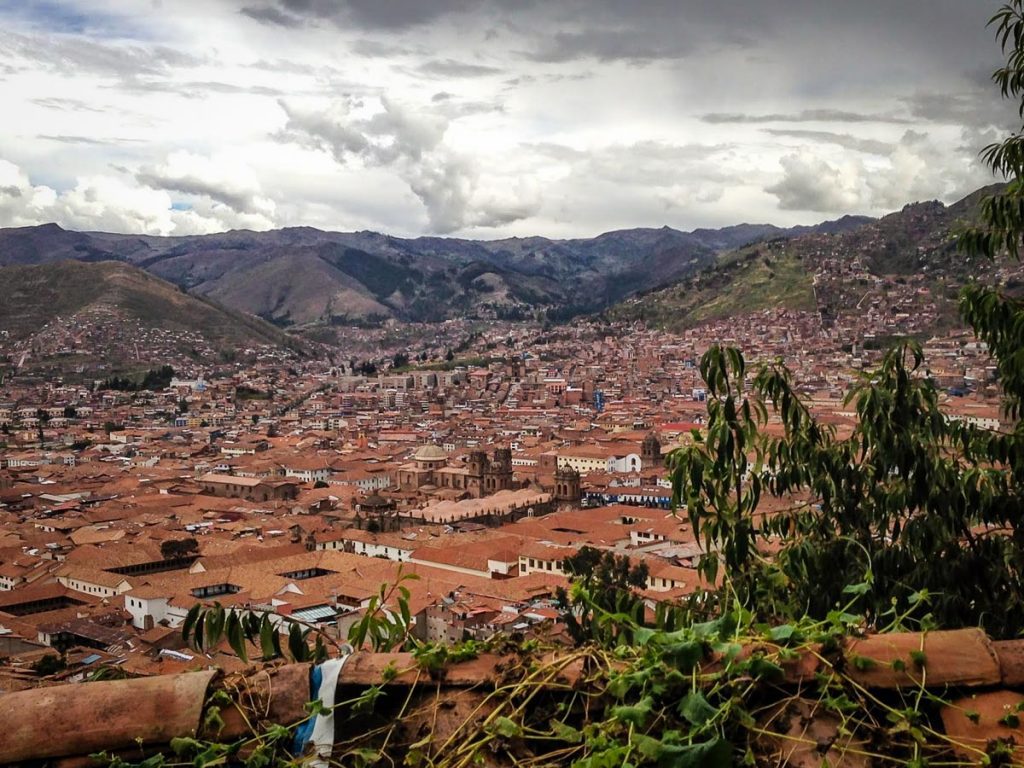
In the highlands (aka the mountainous region in central Peru), the wet season is opposite that of the coast, arriving in mid-December and typically lasting through March. During this time, heavy storms are frequent, and the weather in the mountains is wildly unpredictable.
In February, the Inca Trail actually closes altogether and while it’s technically possible to visit Machu Picchu, it’s likely to be shrouded in fog. Not much point in visiting a bucket-list destination if you can’t even see it, much less snap photos!
Conversely, June through August is the high season for this iconic trek, as well as the rest of the Incan Highlands. Days are generally sunny and while the high temperatures remain near 70°F (21°C) fairly consistently year-round, the lows get a lot chillier around this time, sometimes approaching the low 30s (closer to 0°C).
Especially in the high-altitude Andes, always bring warm layers and a rain jacket!
Best things to do in the highlands of Peru
- Hike the Inca Trail to Machu Picchu — deservedly Peru’s star attraction!
- Visit the dramatic Colca Canyon , peppered with traditional villages and jaw-dropping views.
- Journey to Cordillera Blanca , a less-visited Andean mountain range with spectacular views and impossibly turquoise blue lakes.
- Discover the local markets, adorable neighborhoods, and ruins of Cusco.
- Travel to Pisac, a traditional village with an impressive scenic canyon.
- Visit Lake Titicaca, home to unique culture and sweeping views in every direction.
- Head to the Sacred Valley for Incan terraces, ruins, and more in-your-face mountain views.
Seasons in the Peruvian Amazon region
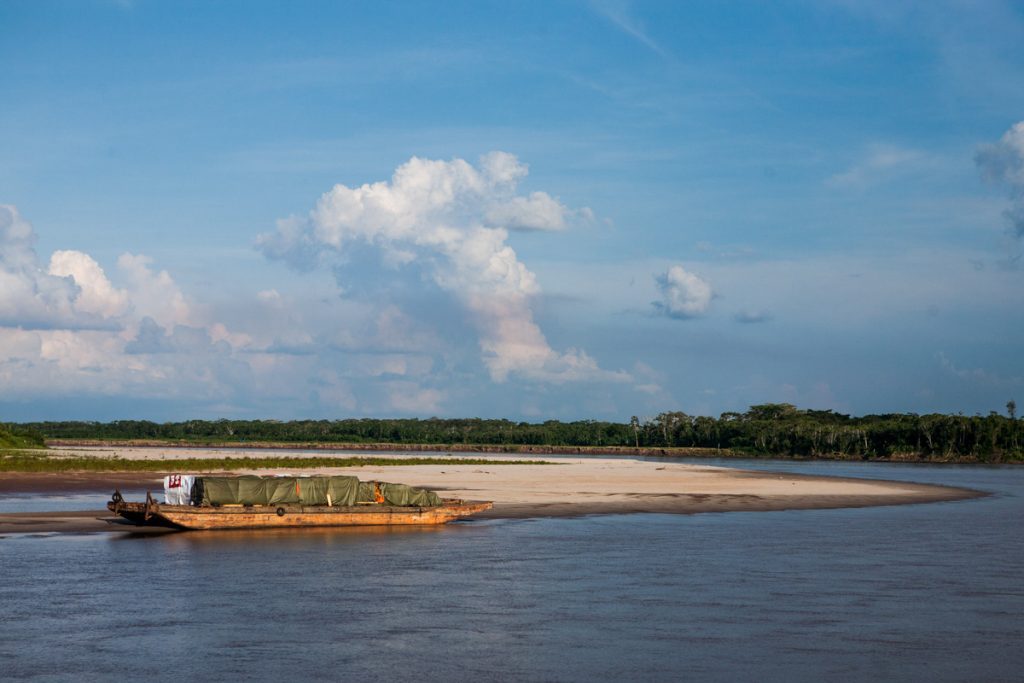
The Amazon region of Peru has a subtropical climate, with significantly more precipitation throughout the year than in other areas. Temperatures consistently hover around 80℉ (27°C) with little variation.
Rain becomes extremely frequent from October through March, and especially in January and February. It’s best to avoid visiting this area for the first few months of the year altogether, but otherwise, the Peruvian Amazon is fairly easy to combine with visits to the country’s other regions.
Best things to do in the Peruvian Amazon
- Take a tour to the jaw-dropping 2,500-foot-tall Gocta waterfall!
- Visit Tambopata National Reserve, where you can spot unique wildlife like colorful parrots and caimans (similar to alligators) and spend the night in an eco-lodge.
- Head to Tarapoto for incredible waterfalls in the unique geological area where the jungle meets the Andes.
- Visit Kuélap for ruins built by a Pre-Incan civilization.
- Journey deep into the jungle in Manú National Park, a remote park encompassing 6,600 square miles .
- Visit the mountainous jungle of Chanchamayo, just a few hours from Lima.
Best time to visit Peru in our opinion…
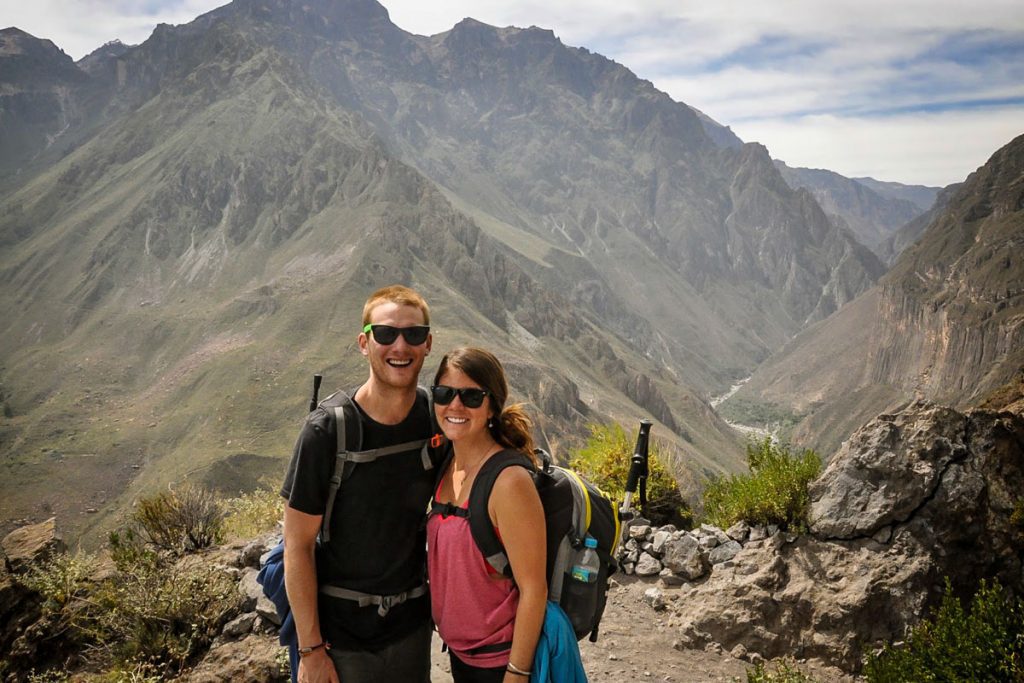
There really is no “bad” time to visit Peru, but it’s a good idea to have the seasons in mind when planning your itinerary and activities you’d like to experience during your trip.
Visiting from May through September will give you the most flexibility in your itinerary and the best chance of enjoying drier weather, especially if you plan to visit Machu Picchu.
We’d recommend visiting Peru during the month of September if you plan to see Machu Picchu. You’ll avoid the peak season surges during June, July and August, but still have a good chance at clear, dry weather. This way you can tack on a trip to Lima after your trek, and with any luck, you’ll experience some early dry season weather.
If you’re more of a city explorer and want to primarily spend your time in Lima, hands down the best time to visit Peru will be during the months of February and March. You’ll avoid the crowds during peak season over the holidays, but still have the best chance of great weather and sunnier skies.
Are you planning a trip to Peru?
We have lots of resources on travel in Peru and destinations throughout the country. Check out our Complete Peru Travel Guide for all the answers to your most burning questions, or read some of our favorite articles below.
- Can’t-Miss Things to Do in Peru
- Fun Things to Do in Lima Peru
- Exciting Things to Do in Cusco
- Hiking the Inca Trail to Machu Picchu
Save this article on Pinterest for later!
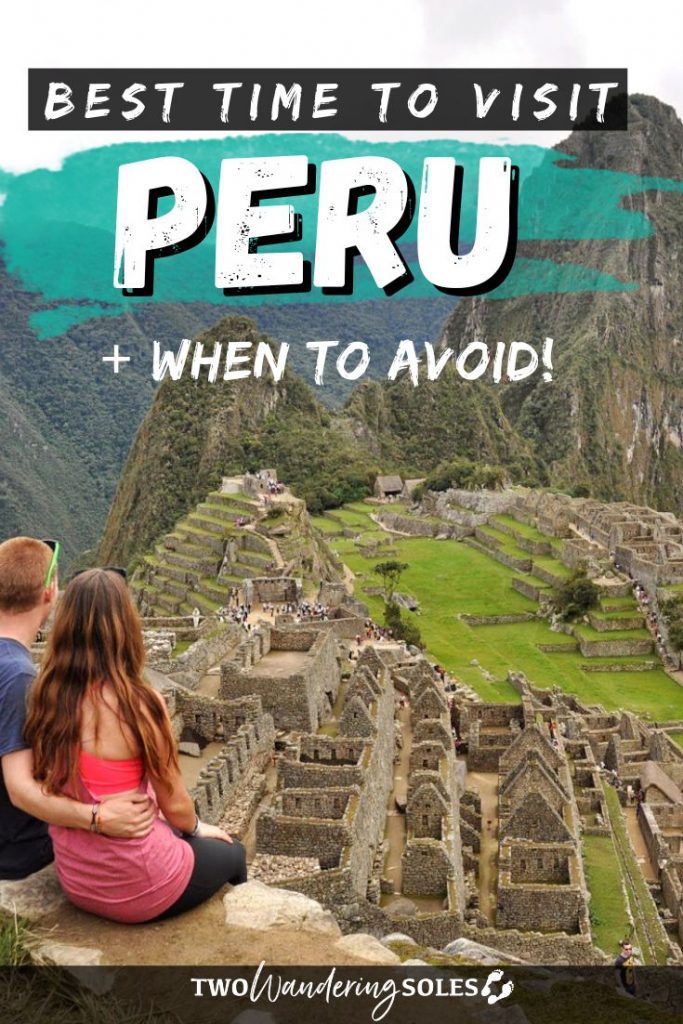
We want to hear from you!
Have you ever been to Peru before? When did you go and what was your experience like? Leave your comments in the section below and we’ll do our best to respond to any questions!
Comments (1) on “ Best Time to Visit Peru: When to Go & When to Avoid! ”
Near Cuzco recommended the mountain of 14 colors and within Peru do not miss the white city of Arequipa.
Leave a Reply Cancel reply
Your email address will not be published. Required fields are marked *
Save my name, email, and website in this browser for the next time I comment.
Nomadic Matt's Travel Site
Travel Better, Cheaper, Longer
Peru Travel Guide
Last Updated: September 1, 2023
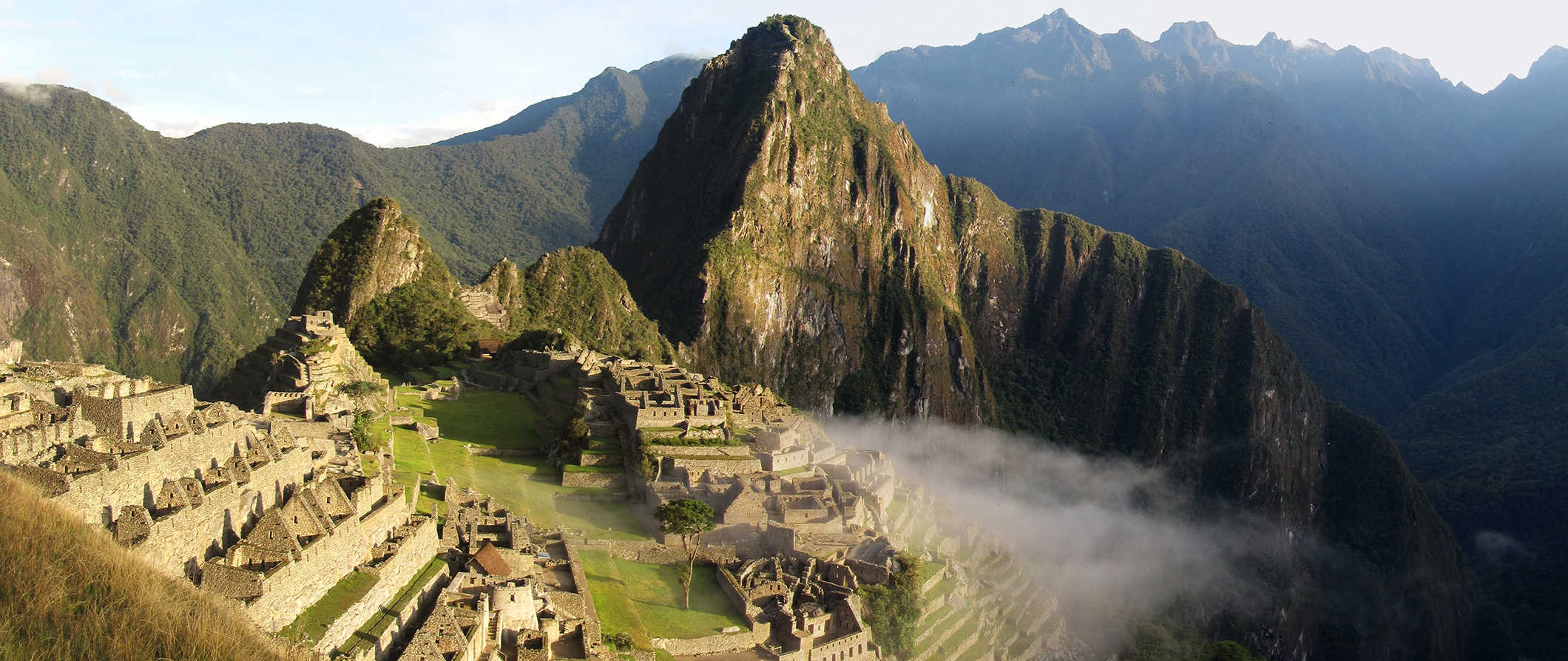
Travelers flock to Peru to hike the famous Inca Trail, explore the lush jungles, and devour their way through the incredible food scene of Lima.
But while the Inca Trail and Machu Picchu attract the majority of the attention (2,500 people visit Machu Picchu every day), there is much more to see and do in Peru if you’re willing to get out there and explore.
From the famous Lake Titicaca to the beaches in the north to the vibrant indigenous culture, Peru is bursting with things to see and do.
While many travelers just visit for a week to see the highlights, you can easily spend a month here (or more) and still not see everything.
Best of all, traveling around Peru is inexpensive. You don’t need a lot of money to visit here (even if you hike the Inca trail).
This guide to Peru can help you plan your trip, save money, and make the most out of your time in this beautiful destination!
Table of Contents
- Things to See and Do
- Typical Costs
- Suggested Budget
- Money-Saving Tips
- Where to Stay
- How to Get Around
- How to Stay Safe
- Best Places to Book Your Trip
- Related Blogs on Peru
Top 5 Things to See and Do in Peru
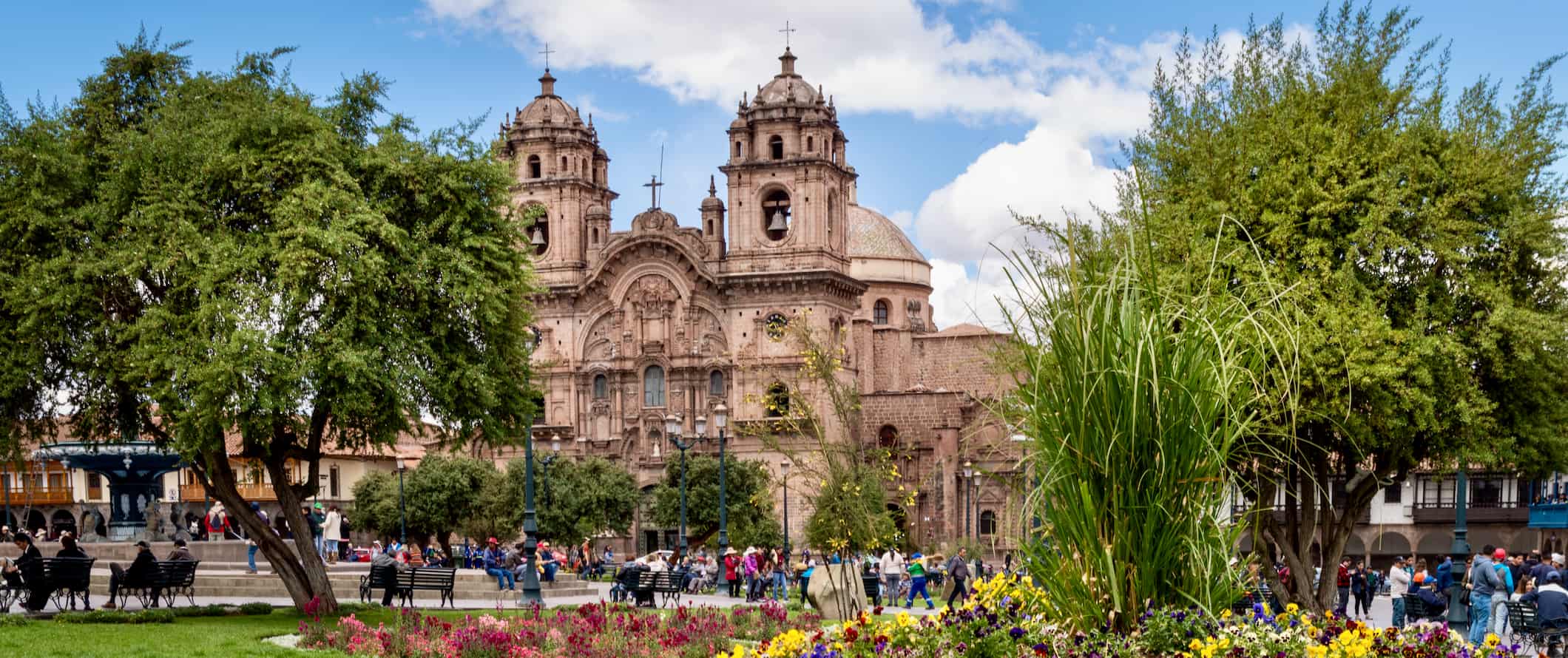
1. Explore Machu Picchu
This legendary “lost city of the Incas” is one of the most-visited tourist attractions in South America. Here you have the chance to wander around the old Inca city observing ancient aqueducts, granite and limestone temples, and other forms of Inca architecture that are all beautifully preserved. There are two ways to see Machu Picchu depending on the amount of adventure and exercise you want. There is a 4-day/3 night hike that takes you through 43 kilometers (26 miles) of steep, yet scenic uphill terrain along winding Andean mountain trails starting from Ollantaytambo. The Inca Trail gets you to the majestic Machu Picchu at dawn in time to see it before the clouds arrive mid-morning. The alternative is to wake up super early to get the train there and enter along with the tour groups competing for the beautiful morning sunset photos. (There are also longer 7-8 day hikes too if you want an even bigger challenge. Multi-day hikes start around 2,600 PEN. You can also just buy a day pass if you don’t want to hike.
2. Check out Lima
Lima is a chaotic and beautiful introduction to the country. Check out the trendy, vibrant Miraflores neighborhood that overlooks the Pacific and has plenty of restaurants and bars to try. Also, visit the Larco Museum to see its pre-Columbian artifacts, the Aliaga House for Peruvian art and artifacts, and Plaza Mayor for colonial beauty. Tour the city’s colorful markets for both food and shopping, wander around the world’s only Cat Park, or check out the Park of Love for good luck in love. At night, head to the artsy Barranco district for the nightlife and try a local drink with pisco, a local brandy. The city is a foodie hub too so don’t forget to try the ceviche!
3. Fly over the Nazca Lines
The Nazca Lines are a series of ancient geoglyphs that dominate the San José desert and Nazca Valley. There are over 10,000 lines and 300 different plant and animal figures that make up this UNESCO World Heritage Site. No one really knows how they got there (maybe aliens?) but the park itself is free to visit. If you want to splash out and get a better view, take a scenic helicopter or plane tour (they cost around 400 PEN).
4. Relax at Lake Titicaca
This stunning lake covers over 7,790 square kilometers (3,000 square miles) and sits at 3,810 meters (12,500 feet) above sea level, making it the world’s largest high-altitude lake. With deep blue water and spectacular sunsets across the lake lined with snowy mountains, this lake attracts people from all over the world to the nearby towns, which offer a mix of colonial architecture and bustling markets. There are three islands on the lake that are home to pre-Inca ruins: Isla del Sol, Taquile, and Amantani. Every year, the Peruvian side of Lake Titicaca at Puno celebrates the Fiesta de la Virgen de Candelaria in February. However, the best and driest time to visit is June, July, and August.
5. Hike the Colca Canyon
Other things to see and do in peru, 1. hike the inca trail.
Getting to Machu Picchu is best via the famed Inca Trail . This multi-day hike allows you to see the mountains, jungles, and follow the route the Incas used to take. It is a truly spectacular hike, but it is challenging and you may experience altitude sickness. There are two ways to do this hike: you can sign up to be part of an organized tour, or you can hire your own private guide. You cannot hike the trail independently. Tours start around 2,600 PEN for a 4-day, 3-night tour with a reliable, reputable company. The final leg of the hike can actually get a bit crowded, so if you can do a longer 7-day hike you’ll be able to beat the crowds and enjoy the incredible landscape before you arrive. The driest time is May-October but also unfortunately the most crowded. If you go from November-April, prepare for mud and perhaps rain but fewer crowds.
2. Visit the Islas Flotantes de los Uros
The Floating Islands of the Uros may sound like an Indiana Jones title, but it is actually the name of the group of man-made islands in Lake Titicaca. The islands are home to the indigenous Uros people who have built their own houses, islands, and boats from the tortora reeds which grow along the banks of the lake. This is an extremely touristy site and is a bit exploited as such, so it’s not for everyone. The boat tours start at 165 PEN.
3. Surf at Máncora Beach
Great fresh seafood, watersports, horseback riding, whale watching, fishing with locals, visiting the mangroves, and plenty of relaxation are the order of the day at this popular beach resort. Máncora is one of the finest beaches in South America and its year-round sunshine, two ocean currents, and beginner-friendly waves also make it Peru’s surfing Mecca. Accommodation prices can be expensive from December to March, so it’s best to book in advance. Whale watching costs 135 PEN, surfing classes start at 95 PEN, and SUP tours with sea turtles cost 175 PEN.
4. Step back through time at Batán Grande
Batán Grande, also known as the Sicán Archaeological Complex, is an archaeological site comprising 50 pyramids and tombs, which are thought to date to 750-1300 CE. Located near Chiclayo, this site was once the ancient Sicán capital and has yielded many impressive pre-Columbian artifacts. For example, a gold Tumi ceremonial knife weighing almost seven pounds was recovered from one of the royal tombs! Bring plenty of water, sunscreen, and snacks for the day.
5. Discover Cusco
This colonial city is a major tourist destination and sits on Inca-built stone foundations not far from Machu Picchu. The area is popular with trail walkers, history lovers, and party goers who come to enjoy the city’s nightlife and festivals. Cusco is the undisputed archaeological capital of the Americas and an essential part of your trip to Peru. The Cusco Tourist Ticket grants admission to most of the popular archaeological sites and attractions in the Cusco area (with some notable exceptions, including Machu Picchu). Note that transportation and guide services are separate. You can purchase either a 10-day pass that includes admission to over 16 sites (130 PEN) or one of several different “circuit” tickets that include admission to a smaller number of sites and are valid for one day only (70 PEN). Be sure to visit Coricancha (15 PEN) and Sacsayhuaman (included in the Cusco Tourist Ticket) during your visit. Right outside Cusco, take a day trip to the incredible Rainbow Mountains. For great food, head to Green Point. Plan to spend around 3-5 days in Cusco as there is plenty to see and it’s a good place to acclimate before doing any hiking as the city sits at 3,200 meters (10,500 feet) above sea level.
6. Get your Amazon fix in Iquitos
Accessible only by boat or plane, jungle-locked Iquitos is the largest city within the Peruvian rainforest. The city sits at the mouth of the Amazon and is the perfect destination for eco-tourism. The nearby Pacaya Samiria National Reserve is Peru’s largest reserve at two million hectares. It’s home to a huge range of nearly 1,000 birds, mammals, fish, reptiles, and more. A 3-day, 2-night tour through the reserve starts from around 1,400-1,500 PEN per person including food.
7. Sandboard in Huacachina
This little town is a desert oasis and a welcome relief after hiking through Machu Picchu. It’s very affordable and hostels here offer great deals for sandboarding and sand buggy tours around the nearby dunes. Two-hour tours cost about 100-125 PEN, which includes a sand buggy driver and sandboard rental. Most tours leave around 4pm so you can catch the sunset on the dunes. There is also a lagoon surrounded by palm trees in Huacachina, and you can rent a rowboat to paddle around it. A half-hour rental costs around 5 PEN per person. Huacachina is easily reached by bus from Lima, Cusco, Nazca, Arequipa, and Paracas.
8. See penguins in Paracas
Paracas is in the south of Peru and is sometimes called the “Poor Man’s Galapagos” for its impressive wildlife, consisting of over 400 different species. Thousands of birds, as well as large sea lion and penguin populations, call the area home. You can visit the Paracas National Reserve via an organized boat tour. Be sure to go early. A full-day tour of Paracas includes a boat trip to the Islas Ballestas and a bus trip around the national reserve in the afternoon. It costs about 150 PEN.
9. Walk through the White City
Arequipa is a beautiful city with a historical center that was constructed primarily from volcanic rock. Start getting to know the city by wandering around the Plaza de Armas and take in the city’s architecture over a glass of wine overlooking the main square with views of the stunning Basilica Catedral de Arequipa. Then, visit the gorgeous, vibrantly colorful Santa Catalina Monastery, see a frozen Inca mummy, and enjoy the local cuisine with favorites like shrimp soup or spicy stuffed peppers. It’s easy to see why Arequipa is undoubtedly one of the most beloved destinations in the country; everyone who visits here loves it.
10. Go to El Parque de la Reserva
This park in downtown Lima is home to the largest water fountain complex in the world, called El Circuito Mágico del Agua . There are 13 distinct fountains in total, including the Tunnel Fountain of Surprises, the Children’s Fountain, and the Fantasia Fountain, whose water jets are synchronized to music during the evening laser light shows. The park is open daily from 3pm-10pm, with beautiful, colorful light shows taking place at 6:50pm, 7:50pm, 8:30pm, and 9:30pm. The entrance fee is 4 PEN. The park also hosts a lot of events and is a popular place with dog owners too.
11. Visit Chachapoyas
This region in the Andean mountains was home to the Chachapoya civilization that lived there between 500-1432 (they were eventually conquered by the Aztecs). Today, you can visit Kuelap, the fortified city at known as “The Machu Picchu of the North.” The ruins are accessible via a guided tour, 4-hour hike, or cable car from the nearby town of Nuevo Tingo for 21 PEN roundtrip. Be sure to also visit Gocta, a beautiful waterfall that, at 770 meters (2,526 feet), is one of the tallest in the world. You can get there by taking a tour from Chachapoyas.
12. Tour Trujillo
Trujillo is the second-oldest Spanish city in Peru, located on the coast with eternal spring-like weather and widely considered the capital culture of Peru. While here, visit the archaeological site of Chan Chan, the world’s largest adobe city ever built and the largest pre-Columbian city. It was built by the Chimu, a civilization that inhabited the area until 1470 when they were defeated by the Incas. Admission is 11 PEN. Be sure to also visit Huanchaco, a small fishing town directly on the beach.
13. See Vinicunca, Rainbow Mountain
Chances are you’ve seen these colorful mountains on social media. Over the past few years, Rainbow Mountain has become a huge tourist attraction. Just keep in mind that the colors are not as vivid in real life and the place is super crowded (it’s a very popular site). Day trips and multi-day hikes are available from Cusco, usually starting around 110-135 PEN per person. There is also an “Alternative” Rainbow Mountain called Palcccoyo where you can enjoy an incredibly colorful scenic panoramic at 5,200 meters (17,060 feet). If you want to escape the hordes of people (though it’s also pretty busy these days).
14. Hike the Salkantay
If you want an alternative to the busy Inca Trail, try hiking the Salkantay. It sees a fraction of the tourists and is half the price of the Inca Trail — but just as stunning! There aren’t as many ruins, but there are epic mountain views and summits of up to 5,200 meters (17.060 feet)! Hikes can vary in length, but the 7-day hike offers the best views. You’ll need to be in decent shape though. 5-day hikes start around 1,700 PEN.
Peru Travel Costs
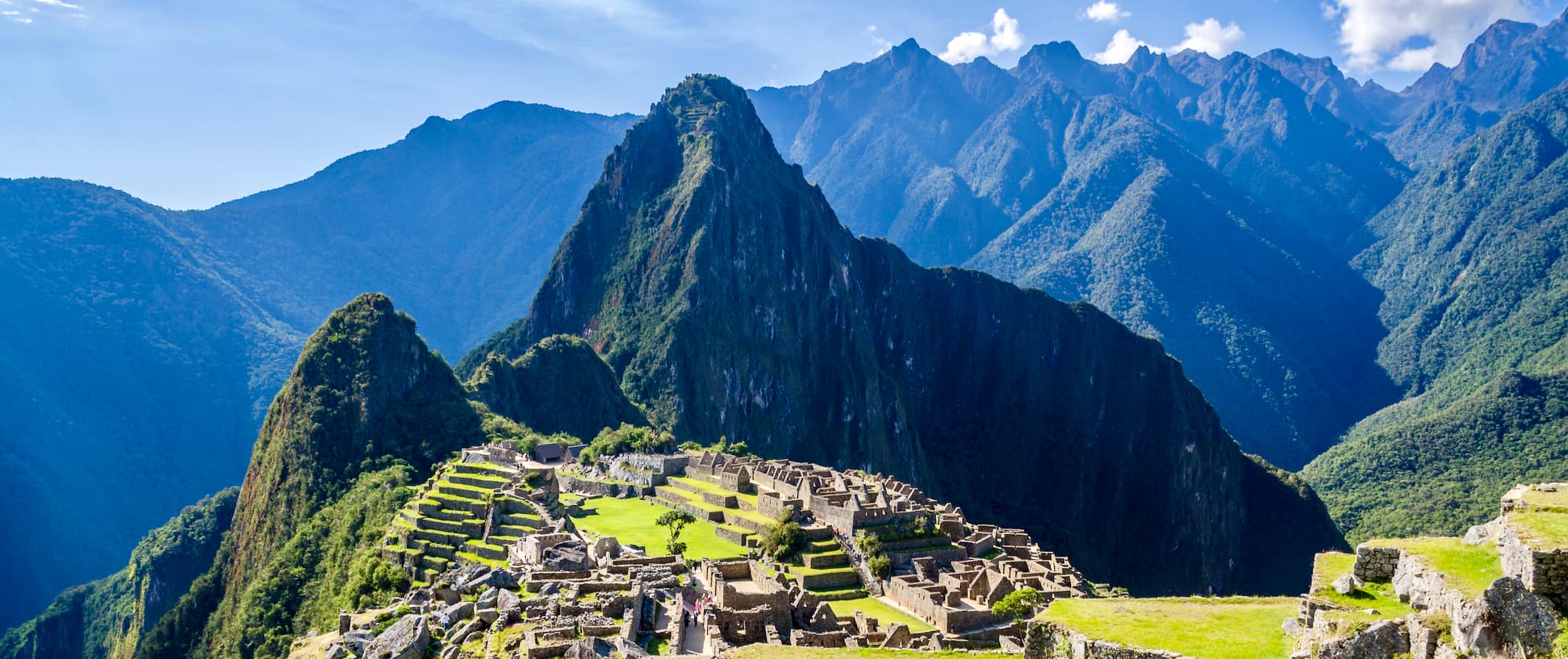
Accommodation – A bed in a 4-6-bed dorm costs 35-65 PEN while a bed in a dorm with 10 or more beds generally costs 32-38 PEN. A private room costs 115-170 PEN per night. Free Wi-Fi is standard and most hostels also have a kitchen or include free breakfast.
Budget hotel rooms with basic amenities like Wi-Fi, TV, and occasionally free breakfast cost around 85-105 PEN per night.
On Airbnb, which has limited availability in Peru, private rooms average around 100 PEN while entire homes start at 200 PEN per night. Book early though or prices will double.
For those traveling with a tent, wild camping is permitted as long as you’re not on somebody’s land.
Food – Cuisine in Peru varies from region to region, though you can expect to find staples like potatoes (most potatoes in the world originated here), quinoa, seafood, and indigenous animals like guinea pig and alpaca. Be sure to try ceviche, which is the national dish (it’s a seafood dish with fresh raw fish). Other popular dishes include stir-fried beef, roasted cuy (guinea pig), arroz con pato (rice with duck), and roasted chicken.
Overall, dining out in Peru is very inexpensive. Street food is incredibly cheap, costing 5-7 PEN for a meal from a parrilla (grill) set up on the side of the road. A plate of food at a casual takeaway restaurant serving Peruvian cuisine costs around 10 PEN.
A meal of traditional cuisine at a casual restaurant with table service costs around 15-25 PEN. If you want to splash out, a three-course meal at a mid-range restaurant costs 45 PEN.
Fast food (think McDonald’s) is 20 PEN for a combo meal. A large pizza is around 28-30 PEN.
Beer is around 8 PEN while a glass of wine or a latte is around 9 PEN. Bottled water is 2 PEN. A cocktail is 15-20 PEN and up, though many restaurants have extended happy hour specials (sometimes even all day).
If you plan on cooking, expect to pay 60-80 PEN per week for groceries such as pasta, rice, seasonal produce, and some meat. The best places to shop are the local markets, though Plaza Vea is the big grocery store chain with affordable prices as well. However, given how cheap food is here, it’s best to just eat out all the time. Buy snacks and fruit at the markets but eat out all other meals.
Backpacking Peru Suggested Budgets
On a backpacker’s budget of 135 PEN per day, you can stay in a hostel dorm, eat out for a few meals at cheap local street stalls and cook some meals, limit your drinking, take the bus to get around, and do mostly free or cheap activities like relaxing on the beach and going hiking.
On a mid-range budget of 400 PEN per day, you can afford a private Airbnb room, eat out for all your meals, drink more, take the occasional taxi to get around, and do more paid activities like going surfing or day-tripping to Machu Picchu.
On a “luxury” budget of 700 PEN or more per day, you can stay in a hotel, eat out anywhere you want, drink as much as you’d like, take some domestic flights, and do a longer multi-day trek to Machu Picchu. This is just the ground floor for luxury though. The sky is the limit!
You can use the chart below to get some idea of how much you need to budget daily, depending on your travel style. Keep in mind these are daily averages — some days you’ll spend more, some days you’ll spend less (you might spend less every day). We just want to give you a general idea of how to make your budget. Prices are in PEN.
Peru Travel Guide: Money-Saving Tips
Peru is generally pretty cheap, but it is easy to splash out here on food and tours. Here are a few hacks to cut down your costs in Peru:
- Stay at hospedajes – These are family-run hotels and are the cheapest accommodation you can find outside of hostel dorms. Try to stay in these as often as possible.
- Take public transportation – Embrace public transportation to get around — it’s super affordable so skip the taxis. You’ll save a fortune.
- Eat the meal of the day – These are set meals, often including multiple plates, that restaurants offer. Look around for set menu meals to eat out on the cheap.
- Travel off-season – For a low-cost trip, the best times to visit Peru are the fringe months of April and May or September and October. Prices are usually cheaper during these months.
- Take the colectivos – These are cheap buses that cost around 2-10 PEN for a ride. They are a bit confusing as they don’t necessarily have a schedule, but there is always a door person whom you can ask if the bus is going to your location. There are not always marked bus stops, so look for gathering crowds.
- Book tours last minute – If you are looking to do the Inca Trail and have a bit of extra time to wait for a deal, showing up in Cusco and booking a last-minute tour can save you lots of money. Booking months in advance means paying the premium price but if you can wait your patience may be rewarded. I wouldn’t recommend trying to get on last-minute if you have your heart set on doing it though since it might not work out.
- Go on a free walking tour – This is a great way to learn the history behind the places you are seeing and avoid missing any must-see stops. Free Walking Tour Peru has tours that can guide you around both Lima and Cusco. Just remember to tip your guide at the end!
- Bring a water bottle – The tap water here isn’t safe to drink so bring a reusable water bottle with a filter to save money and reduce your plastic use. LifeStraw is my go-to brand as their bottles have built-in filters to ensure your water is always clean and safe.
Where to Stay in Peru
Peru has a ton of hostels. Here are some of my favorite places to stay throughout the country:
- Pariwana Hostel (Lima)
- 1900 Backpackers Hostel (Lima)
- Loki Hostel (Cusco)
- Kokopelli (Cusco)
- Wild Rover Hostel (Cusco)
- Hospedaje Turistico Recoleta (Cusco)
- Arequipay Backpackers Downtown (Arequipa)
- Loki del Mar (Mancora)
- The Point Mancora Beach (Mancora)
How to Get Around Peru
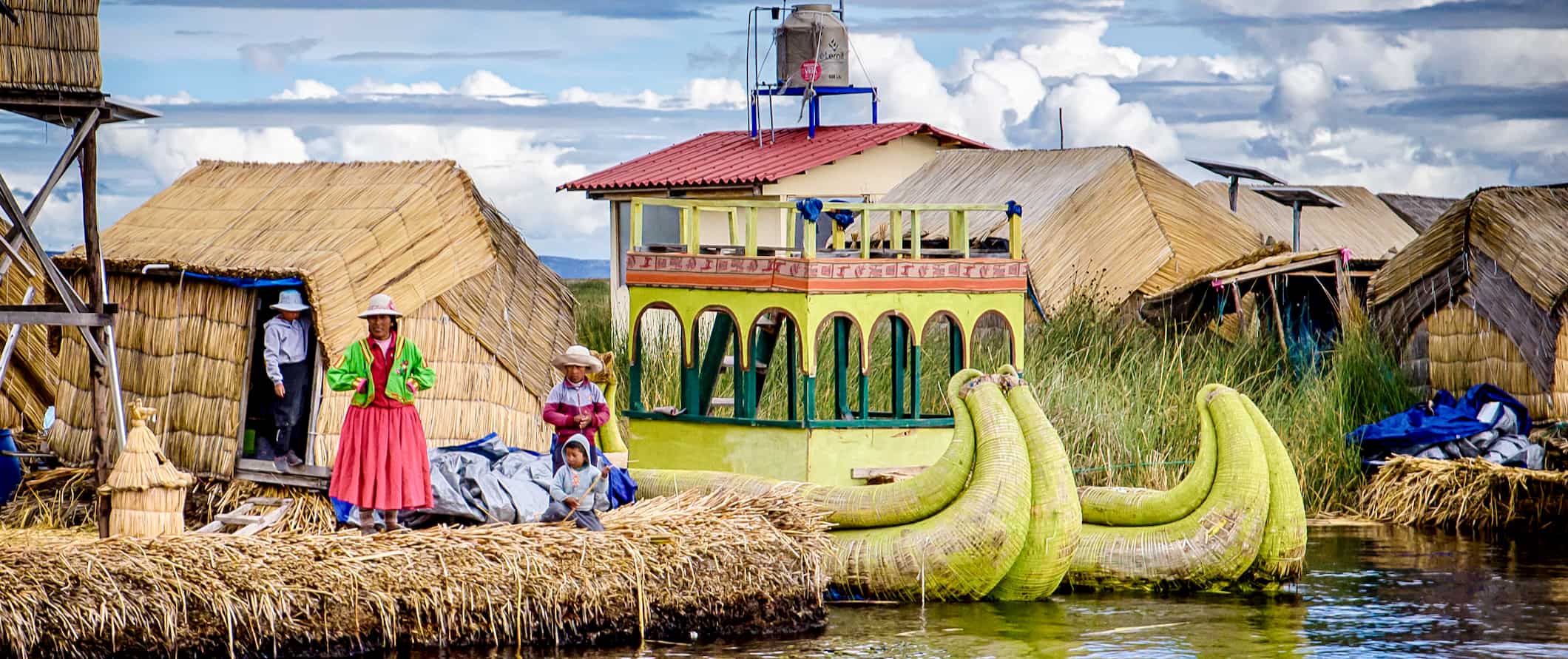
Public transportation – City buses cost around 1.50-3 PEN per trip. Microbuses ( colectivos ) are available and prices vary depending on the distance. Trips generally cost 2-10 PEN, though they are a bit hectic and take some getting used to.
Bus – Buses can take you all over Peru and are the most common way to get around for budget travelers. The usual price for a 10-hour bus journey is around 40 PEN depending on how nice the bus company is. You can use Cruz del Sur to look up bus schedules and prices. Keep in mind that any journey through the mountains will be a slow ride! Lima to Cusco takes over 21 hours and costs 185 PEN, though you can get a ticket for as low as 39 PEN if you book in advance.
Peru Hop is another reliable and comfortable bus company designed for backpackers. This bus is a hop-on/hop-off service you can take around the country. Three-day journeys from Lima to Cusco start from 683 PEN, while 7 days in Southern Peru costs 836 PEN.
Flying – Peru has five international airports (Lima, Arequipa, Cusco, Iquitos, and Piura), as well over a dozen airports with domestic service. LATAM, Avianca, and Star Peru are the main domestic airlines.
Flying between destinations isn’t always the cheapest option, but it’s a whole lot quicker. A flight from Lima to Cusco takes just over an hour (as opposed to the 21 hours by bus) and prices start around 250 PEN. Lima to Arequipa starts around 200 PEN.
Train – Like the rest of South America, the rail system in Peru is basically non-existent. There are nice tourist options though, like PeruRail and Inca Rail, which both run trains between Ollantaytambo and Machu Picchu Pueblo (the gateway to Machu Picchu). On PeruRail, tickets start from 179 PEN. Inca Rail also runs between Cusco and Machu Picchu Pueblo with tickets starting around 220 PEN.
From Lima, there’s just one train: the Ferrocarril Central Andino, the world’s highest passenger train, which travels across the Andes to Cerro de Pasco and Huancayo. One-way fare starts from 230 PEN. However, service is limited — sometimes the train only runs once a month. Journeys are currently suspended due to Covid so be sure to check their website for updates.
Car rental – I don’t suggest renting a car here as the drivers are aggressive, the roads are poorly maintained, and accidents are common. If you do decide to rent a car, use Discover Cars to find the best prices.
When to Go to Peru
Peru has just two seasons: wet and dry. May through October is the dry season, while November through April is the rainy season. The wettest months are from January to the end of April. This isn’t a great time to visit Peru — at least not in the mountain areas, where roads and hiking trails may become blocked or closed.
Most people come to Peru from the beginning of May to the end of November, with July and August being the busiest months. May and September are great months to visit, as tourism slows down slightly but temperatures are still pleasant.
If you want to spend more time in the mountains, June to September has clear, sunny days (but chilly nights). This is a good time to trek the Inca Trail. It’s also the best time to visit the Amazon Basin, when mosquitos are fewer.
Temperatures on the desert coast can get as high as 25-35°C (77-95°F) from December to April, while temperatures cool off from May-October. In the highlands from May-October, you can expect temperatures to reach 20-25°C (68-77°F).
How to Stay Safe in Peru
Peru is a pretty safe place to backpack and travel around, even for solo travelers, and even for solo female travelers. Your biggest worry is petty theft, which is rampant in the bigger cities and on overnight buses. Don’t flaunt expensive jewelry or belongings. Avoid taking your phone out in public if you can. Lock your bags on overnight buses and keep your valuables secure and out of sight. It’s easy to get robbed if you aren’t careful here (especially at night).
If you’re in Lima, don’t walk around alone at night, unless you’re in the safer neighborhoods (Miraflores and Barranco). Smaller cities and towns are perfectly safe to walk around alone day and night.
Solo female travelers should generally feel safe here, however, the standard precautions apply (never leave your drink unattended at the bar, never walk home alone intoxicated, etc.).
Scams aren’t super common but if you’re worried about getting ripped off, here’s a list of common travel scams to avoid .
If you’re doing any hiking, check the weather in advance and bring plenty of water. If you’re hiking to Machu Picchu, arrive early to adjust to the altitude. 3-5 days early can make all the difference!
If you experience an emergency, dial 011 for assistance. If you’re in one of the bigger cities, you can also seek out the tourism police.
For more in-depth coverage of how to stay safe in Peru, check out this post that answers some frequently asked questions and concerns.
The most important piece of advice I can offer is to purchase good travel insurance. Travel insurance will protect you against illness, injury, theft, and cancellations. It’s comprehensive protection in case anything goes wrong. I never go on a trip without it as I’ve had to use it many times in the past. You can use the widget below to find the policy right for you:
Peru Travel Guide: The Best Booking Resources
These are my favorite companies to use when I travel. They consistently have the best deals, offer world-class customer service and great value, and overall, are better than their competitors. They are the companies I use the most and are always the starting point in my search for travel deals.
- Skyscanner – Skyscanner is my favorite flight search engine. They search small websites and budget airlines that larger search sites tend to miss. They are hands down the number one place to start.
- Hostelworld – This is the best hostel accommodation site out there with the largest inventory, best search interface, and widest availability.
- Booking.com – The best all around booking site that constantly provides the cheapest and lowest rates. They have the widest selection of budget accommodation. In all my tests, they’ve always had the cheapest rates out of all the booking websites.
- Get Your Guide – Get Your Guide is a huge online marketplace for tours and excursions. They have tons of tour options available in cities all around the world, including everything from cooking classes, walking tours, street art lessons, and more!
- SafetyWing – Safety Wing offers convenient and affordable plans tailored to digital nomads and long-term travelers. They have cheap monthly plans, great customer service, and an easy-to-use claims process that makes it perfect for those on the road.
- LifeStraw – My go-to company for reusable water bottles with built-in filters so you can ensure your drinking water is always clean and safe.
- Unbound Merino – They make lightweight, durable, easy-to-clean travel clothing.
- Top Travel Credit Cards – Points are the best way to cut down travel expenses. Here’s my favorite point earning credit cards so you can get free travel!
Peru Travel Guide: Related Articles
Want more info? Check out all the articles I’ve written on Peru travel and continue planning your trip:
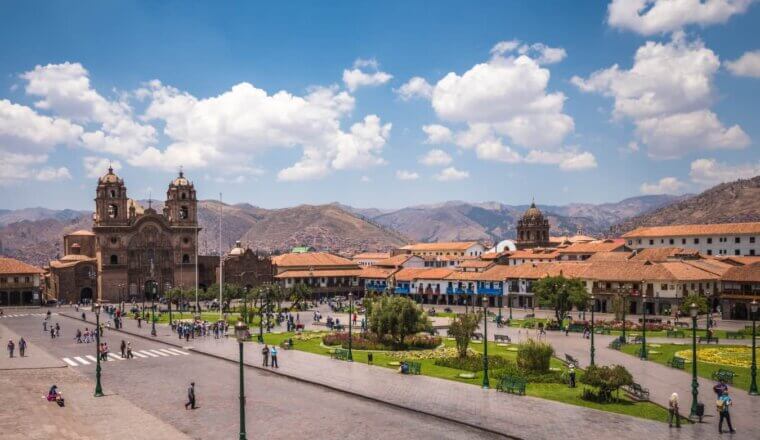
The 6 Best Hostels in Cusco
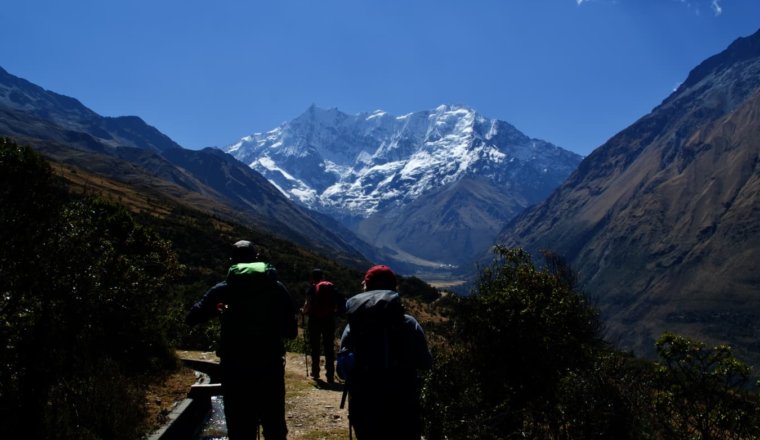
The 4 Best Tour Companies in Peru
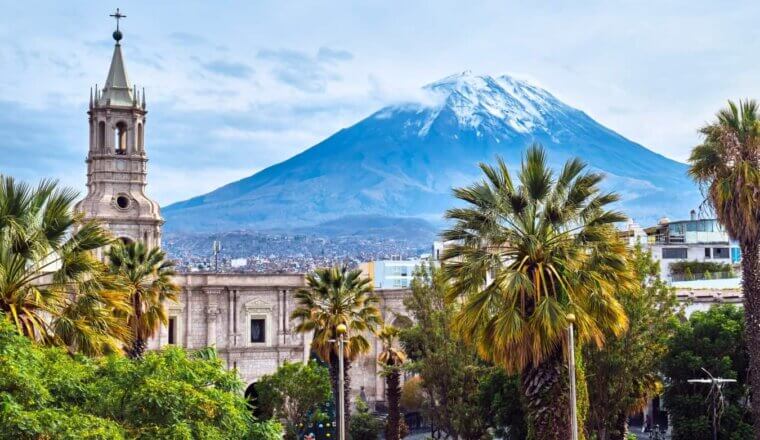
Is Peru Safe to Visit?
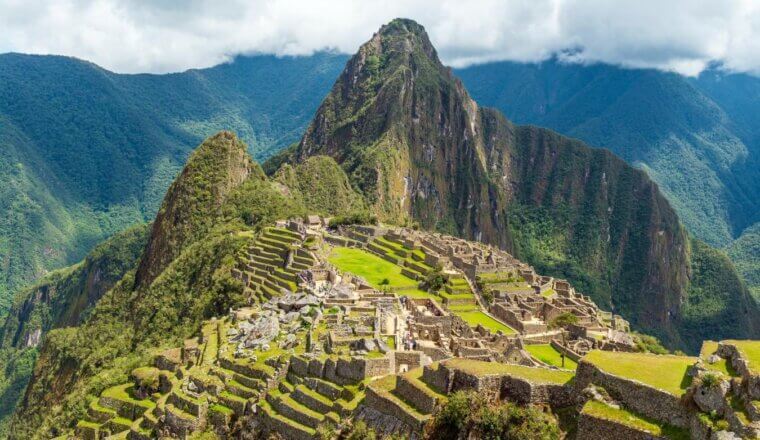
How to Hike the Inca Trail
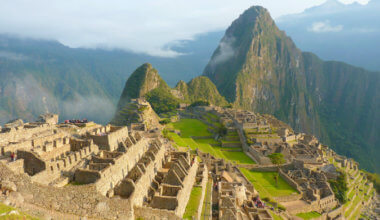
How to Turn Right at Machu Picchu and Find Atlantis
Get my best stuff sent straight to you, pin it on pinterest.
- Where To Stay
- Transportation
- Booking Resources
- Related Blogs

The Ultimate Peru Itinerary: From One Week to One Month of Travel
By Author Arakita Rimbayana
Posted on Last updated: 6th October 2023
Home to an abundance of cultural and archaeological sites, many of which are surrounded by breathtaking nature, Peru is guaranteed to exceed your expectations. And then there’s the local cuisine: many agree Peru’s culinary scene is one of the best in the world.
Whether you’ve got a week or two weeks in Peru (or perhaps even more), there’s plenty of time to explore the country’s famed archeological sites, hit the beach, or head into the jungle, all the while treating yourself to the country’s unique offering of traditional coastal and Andean dishes.
Machu Picchu is on everyone’s list when it comes to a vacation in Peru, and it’s to understand why. In fact, all of our four Peru travel itineraries include a visit to what is by far the country’s premier tourist attraction. But there’s plenty more to add to your Peru vacation itinerary.
Often forgotten, northern Peru also offers big adventure, from surfing to archeological sites that are significantly older – and perhaps more impressive – than better-known Machu Picchu.
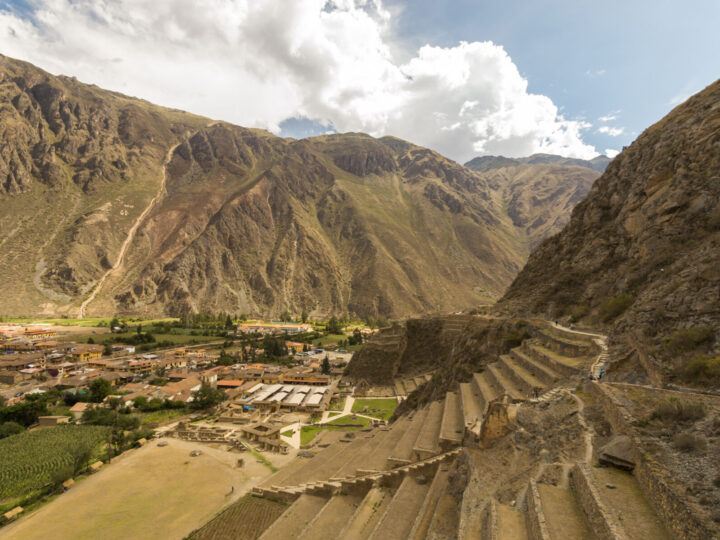
Luckily, these different Peru itineraries can help you explore the country’s most acclaimed destinations and get you off the beaten trail.
Click to navigate this article:
What should you consider before planning your itinerary?
- Altitude sickness is no joke in Peru , especially if you plan to hike or trek. Our itinerary focuses on helping you adjust to the altitude slowly while exploring the best of Peru. Generally, your body needs two weeks to get used to it completely. However, a couple of days of adjustment is better than nothing. Drinking plenty of water and having enough sleep usually help with altitude sickness. You can also consume coca leaf tea and apply herbal oil made for this type of sickness; both are available in most local markets in Peru. Alternatively, consult your doctor before departing your home country as they can prescribe you medication, such as acetazolamide, to ease symptoms of altitude sickness. It’s worth noting that eating spicy, sour, and greasy seafood combined with alcohol can exacerbate the symptoms of altitude sickness. Drinking a cup of coca or muña tea in the morning and after a big meal is one of the known remedies for stomach discomfort.
- Instead of doing both the Colca Canyon hike and the Inca Trail, it’s best to choose only one, no matter how long your itinerary is. There are so many cool things to do in Peru other than just trekking, and it would be a loss to miss them while you’re here. Besides, both trails are strenuous – especially considering the altitude – and you may end up spending the rest of your vacation recovering – rather than enjoying Peru.
- Different regions in Peru usually have different weather conditions. For example, Arequipa is a high-altitude desert where the sun is quite intense, yet Lima and its shores have their own microclimate where winter days are mostly cloudy, but it almost never rains. With that in mind, before you finalize your itinerary, it’s worth reading our article on the best time to go to Peru to learn when’s the best time of the year to travel there.
- Peru is an affordable destination. Dining at a fancy restaurant generally costs less than $50 USD for two, even in the capital city, Lima, while you can expect to spend around $70 USD per night for a decent mid-range hotel, or around $15 USD per night for a bed in a dorm room. Transportation is also very affordable: flights between Lima and Cusco can cost as little as $100 USD one-way, while a bus covering this route can cost as little as $45 USD. As a result, you can cover a lot of distance during even a shorter trip. Read out complete guide to how much it costs to travel in Peru for more information.
- There are only a few direct domestic flights within Peru that don’t travel through Lima . Most flights have at least one stop in the capital city. There are plentiful bus routes throughout the country, although many routes wind through the mountains and it’s wise to always pay for a more expensive bus company, as cheaper operators can be dangerous; we recommend using companies such as Cruz del Sur , Oltursa , TEPSA , Movil and Civa for their higher safety credentials. Bus Bud is a great site for finding bus tickets before you travel, but they are often cheaper bought at the bus station directly. If you have significant issues with motion sickness, do bring medication.
- Public transport in Peru is accessible and affordable. Bus routes pass each city’s popular places, while taxis are cheap, too. A one-kilometer trip usually costs around S/4 ($1 USD) or less. Note that most taxis are unmetered, so it’s best to agree upon the fare before you get into one.
- Packing for your trip to Peru depends a lot on what you plan on doing. To visit Machu Picchu, pack light and comfortable clothing, alongside a waterproof jacket as there’s a high chance of rain. Medication to help you deal with altitude sickness (and motion sickness if you plan on taking long bus rides) is always helpful. Sunblock is very important, particularly in high-altitude destinations such as Cusco where the sun is more powerful. Packing a wide-brim hat is also useful. Check out our complete South America packing list for more details.
Planning Your Trip to Peru?
Save time, stress & money with a customized travel itinerary planned for you by a Peru expert
One week in Peru
Overview of this one-week Peru itinerary:
- Days one and two: Cusco and the Sacred Valley
Days three and four: Machu Picchu
Day five: cusco, days six and seven: lima.
One week in Peru is enough to explore Machu Picchu and the former capital of the Inca, the historic city of Cusco before heading back to Lima for a final few days on the coast.
Day one: Cusco
Instead of Lima, make Cusco your first stop in Peru. Landing here only requires a further one-and-a-half-hour flight from the capital – and which is definitely the best way to get from Lima to Cusco. And it’s worth the chance to dive into the cultural highlights right away. Cusco also offers some of the best tour companies for Machu Picchu.
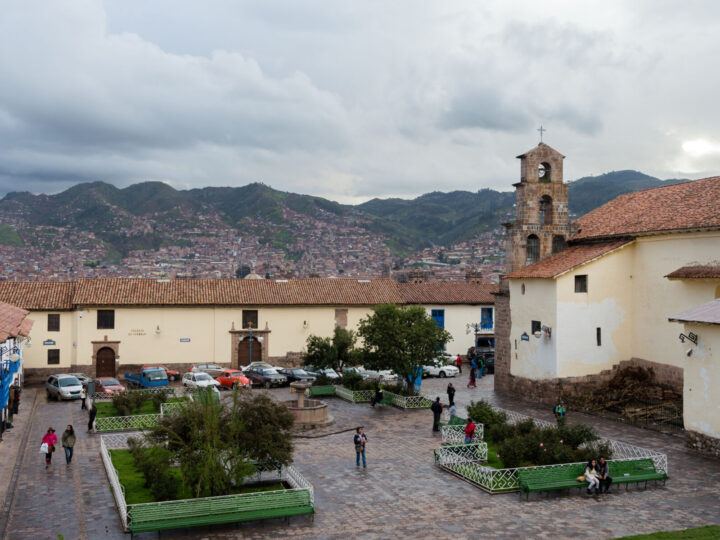
Spend your first day in Cusco taking things nice and easy; at 3,400 meters (around 11,000 feet) above sea level, this city can leave you feeling breathless. Adjust to the altitude and the low oxygen levels by exploring the old town – the focal point of this city – on foot.
Head to the Museo Inka (Inca Museum) to explore over 10,000 Inca artifacts including mummies and gold figurines, as well as the Museo de Arte Precolombino (Museum of Precolombian Art) to admire gold and silver ornaments, some of which date as far back as 1250 BC.
End your walking tour with a visit to the cathedral , where you can find painter Marcos Zapata’s famous rendition of Leonardo da Vinci’s The Last Supper, just this time featuring a guinea pig as part of the feast.
If you’re still feeling good, take the 15-minute walk uphill to the Sacsayhuaman site , a walled complex that served as both a temple and fortress for the Inca and has fantastic views of the city. An easier alternative is a taxi ride from the city; expect to pay around S/10-25 ($2.5-6.3 USD), although the exact fare depends on which road is accessible on that day.
Where to stay in Cusco: Promising affordable comfort in a charming setting, El Mercado ($210 USD double) is a perfect getaway in the city center. The 32 bedrooms are decorated with modern furnishings and artwork, adding a modern twist to a historic casona .
Where to stay in Cusco on a budget: Few places offer the degree of comfort and affordability as MOAF Boutique Hotel ($80 USD). The rooms are bright thanks to plenty of natural light and have modern furnishings and pleasant neutral decoration. This helps to enhance the rooftop views available in some bedrooms, as well as in various communal areas.
Day two: The Sacred Valley
On your second day, it is time to explore the different attractions of the Sacred Valley , where the Urubamba River brings life to otherwise barren land. Take a colectivo (a public van), bus, or taxi from Cusco to the Sacred Valley and the town of Pisac . The former is the cheapest and easiest option; you’ll find they leave every ten minutes or so from Puputi Street, and cost between S/4-10 ($1-2.5 USD).
Pisac is a peaceful little town where you can hike (or take a taxi) to a magnificent Inca fortress that sits in the hills above. The views of the Sacred Valley from the site are mesmerizing. Located only an hour away from Cusco and also home to a busy daily market (although it’s best visited on a Sunday), Pisac is one of the best day trips from Cusco.
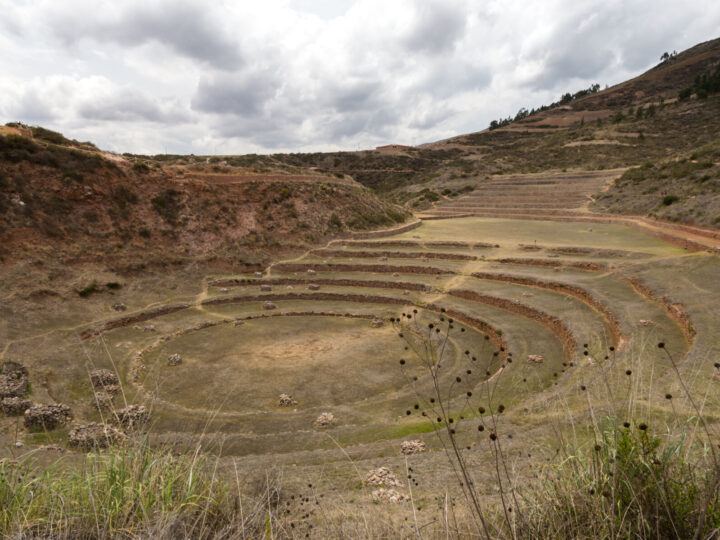
Other great options in the Sacred Valley are Moray , a series of concentric circular stone terraces that were used for testing out growing crops in different conditions, as well as the Salinas de Maras (Maras salt pans), where local people have panned for salt for hundreds of years. You can take local transportation to get to them, or book this tour that’ll take you to each.
From Pisac in the Sacred Valley, you can return to Cusco or continue downriver to Ollantaytambo , another picturesque town home to further archeological sites, as well as horseback riding, rafting and hiking tours. The train to Machu Picchu is available from both.
Where to stay in Ollantaytambo: Right next to the train station, but home to a lush garden and suntrap terrace, El Albergue ($142 USD double) is a tranquil place to while away the evening. They also have a fantastic on-site restaurant that cooks up ingredients from the hotel’s organic vegetable garden.
Where to stay in Ollantaytambo on a budget: Rustic but clean bedrooms are the norm at the affordable Picaflor Tambo Guest House ($42 USD double) run by owners who will ensure you have the most comfortable stay possible.
Head northeast along the train to reach Aguas Calientes , a small town at the base of Machu Picchu and which is filled with bars, restaurants, and markets. The train ride from Cusco to Aguas Calientes takes four to five hours, while the one from Ollantaytambo only takes one and a half hours.
If you choose the latter option, you can spend your morning visiting Ollantaytambo’s archaeological sites before departing and the afternoon in Aguas Calientes relaxing in your hotel, soaking in the thermal baths that give the town its name, or even checking out the local butterfly sanctuary .
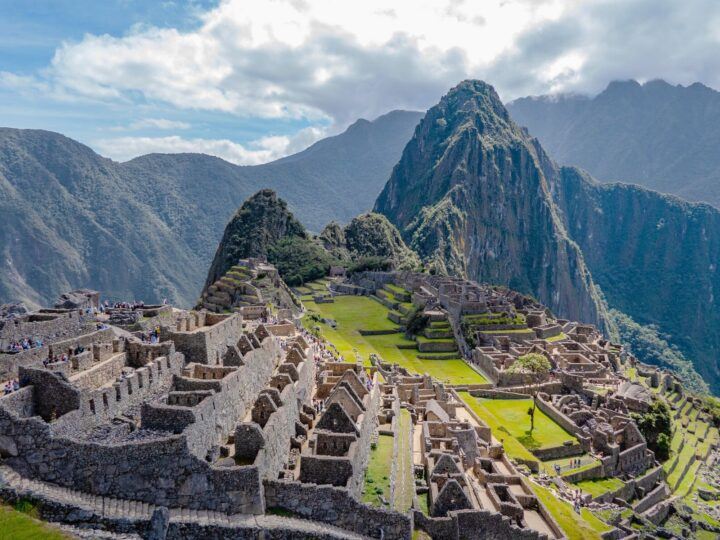
The next day, get up bright and early to board the earliest bus from Aguas Calientes to Machu Picchu – at 5:30 am. By doing this, you can expect to be one of the first to arrive at the site. What a treat: there’s nothing like enjoying your first view of the ruins accompanied by little else than the sound of birdsong.
For the best weather – and for a clear, unobstructed view of the site’s magnificent stonework – read our guide to the best time to visit Machu Picchu and Peru in general.
Feeling adventurous? Eschew the bus and instead hike from Aguas Calientes up to the entrance of Machu Picchu.
However, depending on your fitness level, the hike can take between one and two hours – so start early if you want to see the site at its quietest.
Be aware when planning your trip to Machu Picchu that you must book tickets well in advance as there is a limit on the number of people who can enter the site per day. Your ticket gives you four hours within the grounds, and it generally takes around two hours to explore Machu Picchu.
Note that it’s now mandatory to visit with a guide, which you can hire at the entrance to the site, although you’ll have more control over the language they speak if you book with a tourism agency in Cusco.
It’s another couple of hours to your visit if you plan to hike up Huayna Picchu, too (just note you’ll need to buy a ticket with permission to visit Huayna Picchu in order to do this). This hike is strenuous, but the views across the entire site are a highlight of any trip to Machu Picchu.
It can be pricey visiting Machu Picchu, so make sure to read about how much it costs to visit the Inca citadel before planning your trip.
Return to Cusco in the evening by train.
Spend one last day exploring historic sites, as well as enjoying the city’s culinary traditions. Explore the imposing buildings of the formerly impressive Inca temple of Q’orikancha, join tourists and locals alike for locally-brewed beer in Cholos, head to the ChocoMuseo for a workshop on chocolate-making and spend an evening sampling heady pisco cocktails and listening to lively local music at the Museo del Pisco .
Wrap up your Cusco itinerary by visiting the Mercado San Pedro (San Pedro market), where you’ll find sweaters, bags, and knick-knacks made from Alpaca wool. While these are also available in other markets around the city, you’ll find them for the best prices in San Pedro.
Head back via plane to the capital city, Lima . Two days in Lima is just the right amount of time in order to get a glimpse of life in this dynamic city. Head to the trendy Barranco neighborhood , home to uber-chic cafes and chic bars in restored mansions, with all of this just a few steps away from the beach.
For an insight into the grittier side of Lima, head by taxi to the Callao neighborhood where Lima’s former shipping district and one of its most dangerous places has been transformed through street art and shops selling local arts and crafts – just don’t stray far aware from local hub Callao Monumental as the area remains dangerous for visitors.
Don’t miss the city’s renowned dining scene. For haute cuisine, head to Barranco and the world-famous Central , or dine on Nikkei (a Peruvian take on sushi) at Maido in Miraflores.
Any visitor to the city can’t miss the quintessential Peruvian dish: ceviche , so head to La Mar or Punta Azul in Miraflores to sample your newest favorite dish – washed down with a crisp glass of white or a pisco sour. After all, Peru is the best country in South America for affordable yet outstanding dining .
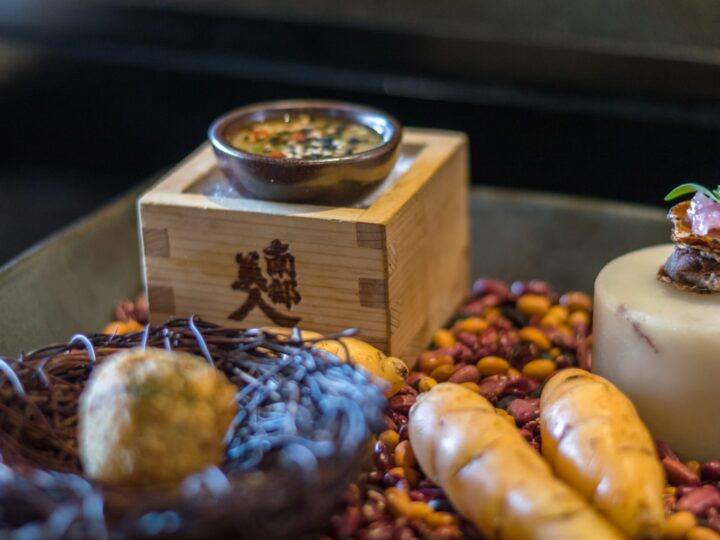
Spend your last days here museum-hopping (the Museo Larco is one not to miss), exploring the old town around the Plaza Mayor , or up the ante by testing the waves of the Pacific Ocean on a surfboard.
Where to stay in Lima: The Barranco neighborhood is known as a place of poets, artists and creatives, so there’s nowhere better to stay than in Second Home ($135 USD double), a grand, eight-room guesthouse in the former home of Peruvian sculptor Victor Delfin, who you might even spot pottering around the house if you’re lucky.
Where to stay in Lima on a budget: One of our favorite places to stay when we’re in Lima, the Lighthouse Bed and Breakfast ($40 USD double) is run by a Peruvian-British couple and offers a handful of doubles with private bathrooms in a pleasant residential area in Miraflores. The terrace out the back where breakfast is served is a gorgeous place to while away the day.
Where to stay in Lima on a budget: Located in Miraflores and offering a youthful, friendly guide Selina Lima ($53 USD double) is our budget pick. (read our comprehensive Selina Lima review ) . Even though it’s a hostel, comfortable and stylishly presented private rooms with private bathrooms are available.
Got more time to spend in Cusco? Read our Cusco itineraries article for trips from three to ten days in length.
10 days in Peru
Overview of this 10-day Peru trip planner:
- Days one through three: Cusco and the Sacred Valley
- Days four through seven: The Inca Trail
Day eight: Machu Picchu
Days nine and ten: lima.
10 days in Peru is the perfect length of a trip that allows you to add the Inca Trail to your Machu Picchu trip. Follow the itinerary above but, instead of taking the train straight to Aguas Calientes on day three of the itinerary above, take a hiking tour of the Inca Trail to Machu Picchu .
Days four through seven: Inca Trail
The trails built by the Inca throughout the Andes were used to connect what was once a vast empire to its territories across Peru and into neighboring Ecuador, Bolivia and Chile.
Known as the Qhapaq Ñan (Royal Road), many of these paths remain today and can be explored on foot – much the same way as they would have been used by the Inca royalty and pilgrims.
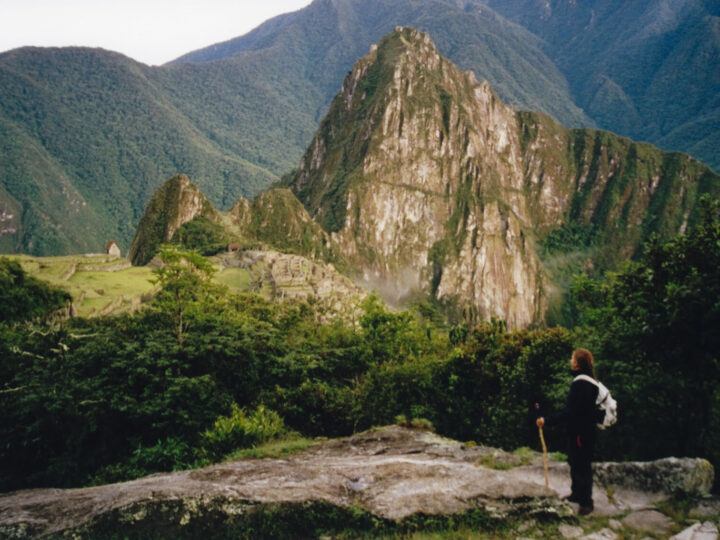
Hiking to Machu Picchu on the 40-kilometer (25-mile) Inca Trail generally takes four days and joining a guided tour is required. If you see three-day Machu Picchu tour operators, it is likely only for the fittest travelers, or the tour only includes part of the trail.
We recommend reading our extensive guide on what you need to know about hiking the Inca Trail before signing up for any tour and reading our comparison of the Inca Trail and Salkantay Trek (another popular trek to Machu Picchu) to understand our options.
This hike is strenuous and can be dangerous in some parts. Even for experienced hikers, it’s challenging, so listen to your body, take your time, and pause if you need to.
The good news is you don’t need to pack food or a tent as those will be provided by the tour company. Some companies even offer a porter service, so you don’t need to carry anything during the entire hike!
The Inca Trail leads directly to Machu Picchu through what is known as the Sun Gate – named as such because the sun’s rays pass through here on the summer solstice. The view from here is also legendary and a privilege only to those who reach the site from the Inca Trail.
Once you’ve explored this magnificent stone fortress, descend to Aguas Calientes via the path or take one of the public buses from the gate of Machu Picchu.
Depending on what time you get to town and your train schedule, you can either spend the night in Aguas Calientes or go directly to Cusco, where you’ll find flights to Lima.
As per the previous itinerary, spend the last two out of your ten days in Peru tasting local dishes, visiting museums, or simply relaxing on the beaches of Lima.
Two weeks in Peru
Overview of this two-week Peru vacation itinerary:
Days one and two: Lima
Day three: pisco and ballestas islands, day four: nazca, days five to eight: arequipa and the colca canyon, days nine and ten: cusco and the sacred valley.
- Days eleven and twelve: Machu Picchu
- Day thirteen: Cusco
- Day fourteen: Lima
With two weeks in Peru, you can explore four main destinations – Lima, Nazca, Arequipa, and Machu Picchu – and famous attractions near to these main draws.
Instead of going straight from Lima to Machu Picchu, spend two days exploring Lima as you would on the last days of the previous itineraries, and then take a day trip from Lima to the Ballestas Islands and Nazca.
Take the bus four hours south to Pisco , one of the most popular towns within striking distance of the city because of – well, you can guess from its name – Pisco, the famous Peruvian spirit. In this town, tourists can visit vineyards and sample their products.
However, if you’re short on time, head directly for Paracas , one of the most popular destinations to visit in Peru . This is where the boat trip to Ballestas Islands, aka the Peruvian Galapagos, starts.
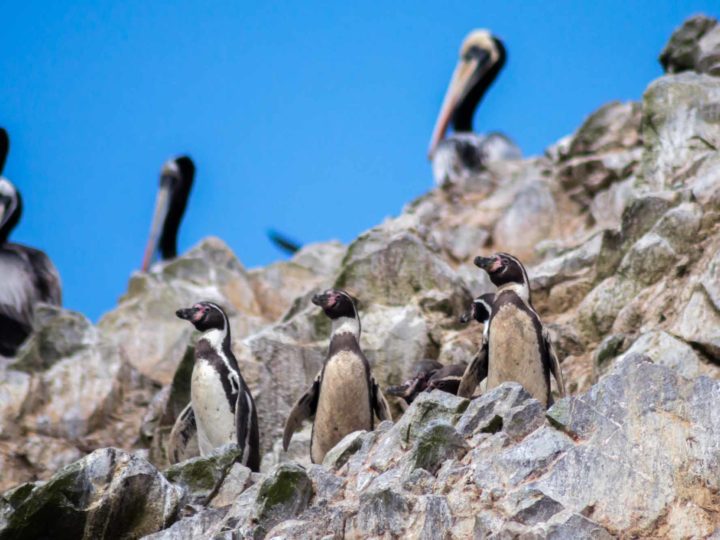
While they’re certainly not as impressive as their Ecuadorian namesake, the Ballestas Islands are still full of a rabble of wildlife, that can include everything from Humboldt penguins to sea lions and pelicans.
Since the entire archipelago is a national reserve, you’re not allowed to swim or disembark on any of the islands, but your two-hour boat tour will give you front-row seats to the raucous melee of sea life that lives upon them.
Book with a local tour company on the day or in advance here .
Stay overnight in Paracas, ready for an early bus the next morning.
Where to stay in Paracas: Located just meters from the beach, the chic Casa Paracas ($108 USD double) will make you wish you had more time to hang here and soak up the sunshine. All rooms have their own private balconies, as well as much-appreciated air conditioning.
Where to stay in Paracas on a budget: Basic but budget-friendly, Atenas Backpacker Hospedaje ($18 USD double) is an extremely cozy home-away-from-home, with plenty of communal spaces and an extremely welcoming atmosphere.
Your next stop is Nazca , a four-hour bus journey from Paracas. This is where you’ll find the massive geoglyphs, the Nazca Lines , whose origins – and purpose – remain one of the greatest mysteries in the world.
For the best views of these remarkable lines, which are in the form of hummingbirds, spiders and bold geometric patterns, take a flight over the desert from the airport in Nazca.
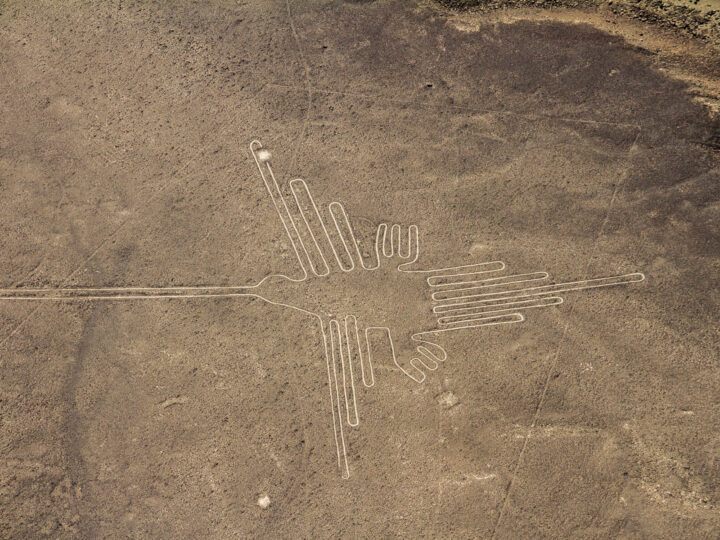
There’s not much to do in Nazca besides wandering around the Plaza de Armas, so get an early night ready for tomorrow.
Where to stay in Nazca: It’s no looker, but Nasca Travel One Hostel ($22 USD) has everything you need for a comfortable one-night stay and is extremely clean and comfortable, particularly as it’s a little away from the town center meaning you’re guaranteed a peaceful night’s sleep.
A six-hour bus journey from Nazca brings you to the White City, Arequipa . Situated in the volcano-studded highlands of southern Peru at 2,335 meters above sea level, Arequipa is your first introduction to altitude, so take it easy once you get off the bus.
Arequipa is a striking place: Volcán Misti stands tall above the city, and the buildings around the center are built using dazzlingly white volcanic stone.
Spend the remaining part of the day exploring Arequipa’s old town – the Monasterio de Santa Catalina , a vast and beautiful nunnery, and the seventeenth-century cathedral are two not to miss – before an evening tasting the lip-smacking rocoto relleno (stuffed spicy pepper), a traditional Arequipan dish.
For more highlights of the city, read this article about things to do in Arequipa and our guide to the best places to stay in Arequipa .
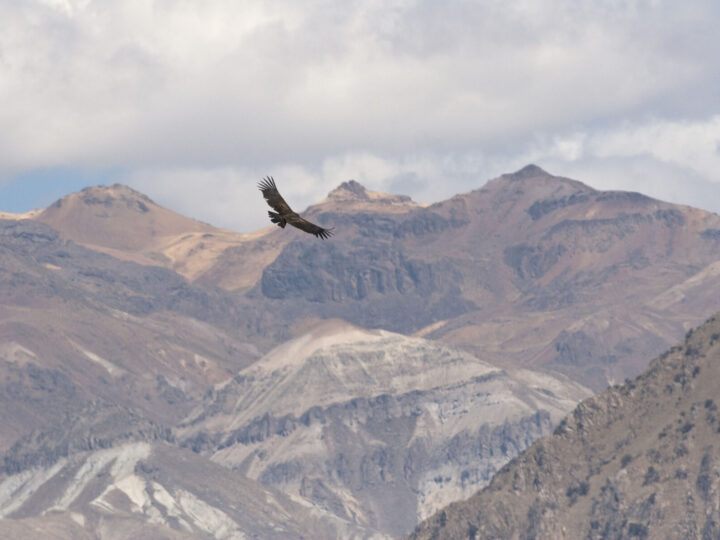
On the afternoon of day six, hop on a minivan to Chivay (3.5 hours) and then onto Cabanaconde (1.5 hours) and spend the night there in preparation for the Colca Canyon trek .
The next day, embark on the two-day Colca Canyon trek , which starts from Cabanaconde and heads down into the bottom of the canyon.
Unlike the Inca Trail where you sleep in tents, you will be spending nights within rustic lodgings inside Sangalle, the oasis town at the bottom of the canyon, offering you a soft bed and a pleasant night’s sleep. But don’t be fooled: this hike is challenging.
After a day hiking into the canyon the only way back out is up – a climb of 1,200 meters (4,000 feet) over a five-kilometer (three-mile) stretch.
Return to Arequipa by bus for an overnight bus to Cusco or for a final night in the city before a bus the next morning.
Where to stay in Arequipa: Set in a charming old house with a gorgeous courtyard for a leisurely cup of coffee or cold beer, La Hostería Boutique Hotel ($72 USD) double) is one of Arequipa’s (and Peru’s) most luxurious hotels . A pool, sun terrace and spa facilities are just some of the highlights here.
Where to stay in Arequipa on a budget: The family-run La Casa de Margott ($30 USD double) has clean and spacious rooms, as well as a pleasant roof terrace for lounging in.
It’s a fair distance from Arequipa to Cusco, so you can expect a ten-hour bus journey to get you from the coastal highlands and up into the Andes.
Unlike flying, which can lead to altitude sickness due to the rapid change in altitude, taking a bus to Cusco is a much gentler form of transport and gives you the opportunity to view some of the country’s incredible mountain landscapes.
Finish your itinerary by following the one-week in Peru itinerary, just shaving off a day in Lima at the very end.
Adapting this itinerary: Want to hike the Inca Trail instead? Spend days fix and six in Arequipa, then head to Cusco for the Inca trail for days seven through ten, with day eleven at Machu Picchu. Spend days twelve and thirteen in Cusco, before heading back to Lima on day fourteen.
One month in Peru
Overview of this one-month Peru backpacking itinerary:
Days three and four: Trujillo and Huanchaco
- Days six and seven: Cajamarca
- Days eight to ten: Chachapoyas
Day eleven: Lima
- Day twelve: Pisco and the Ballestas Islands
- Days thirteen: Nazca
Days fourteen to seventeen: Arequipa and the Colca Canyon
- Days eighteen to nineteen: Puno and Lake Titicaca
- Days twenty to twenty-one: Cusco and Sacred Valley
- Days twenty-two to twenty-five: The Inca Trail
Day twenty-six: Machu Picchu
- Day twenty-seven: Cusco
- Days twenty-eight to thirty: Puerto Maldonado
Do you have one whole month to spend exploring Peru? Lucky you: you’ve got time to add northern Peru to your itinerary. In addition, a slower pace of travel means your body will have the time to adjust to the altitude changes well.
One month in Peru is also plenty of time for seeing the most unmissable destinations in Peru: going to the north but without excluding Machu Picchu or the Inca Trail, as well as stopping in Pisco and the Ballestas Islands and Arequipa, plus a trip into the jungle in Puerto Maldonado.
Touch down in Peru’s lively capital city, Lima . While it might be packed with traffic and a little rough around the edges, this city is a place you’ll soon fall in love with.
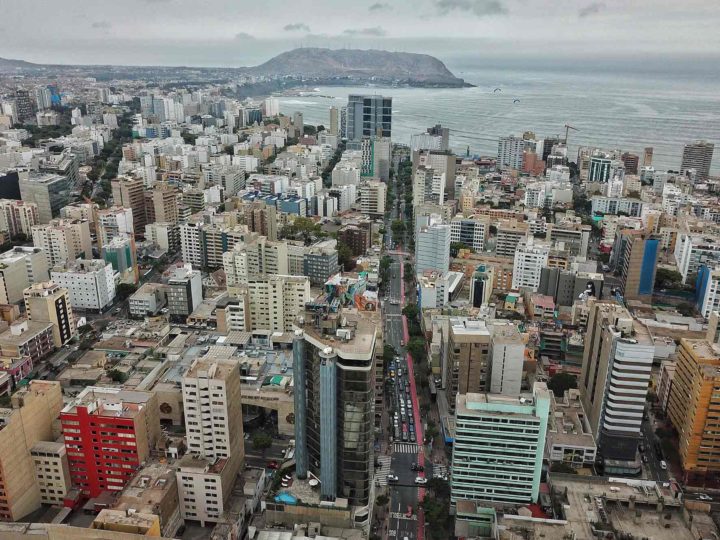
Spend your days museum-hopping (the Museo Larco is one not to miss), exploring the old town around the Plaza Mayor , or up the ante by testing the waves of the Pacific Ocean on a surfboard.
You can also head to the trendy Barranco neighborhood , home to uber-chic cafes and chic bars in restored mansions, with all of this just a few steps away from the beach.
Any visitor to the city can’t miss ceviche, so head to La Mar or Punta Azul in Miraflores to sample your newest favorite dish – washed down with a crisp glass of white or a pisco sour.
From Lima, it’s a grueling nine-hour bus journey to reach Trujillo .
A better alternative is to take one of the multiple one-hour, forty-minute flights from Lima to the airport in Trujillo, which is an easy taxi ride into the city.
Trujillo is a city on few travelers’ bucket lists – but the intrepid who make it here are in for a treat. Many are unaware of the civilizations that predate the Inca Empire, but the archeological sites they left behind are often just as remarkable as Machu Picchu – made more so by the relative lack of visitors at these destinations.
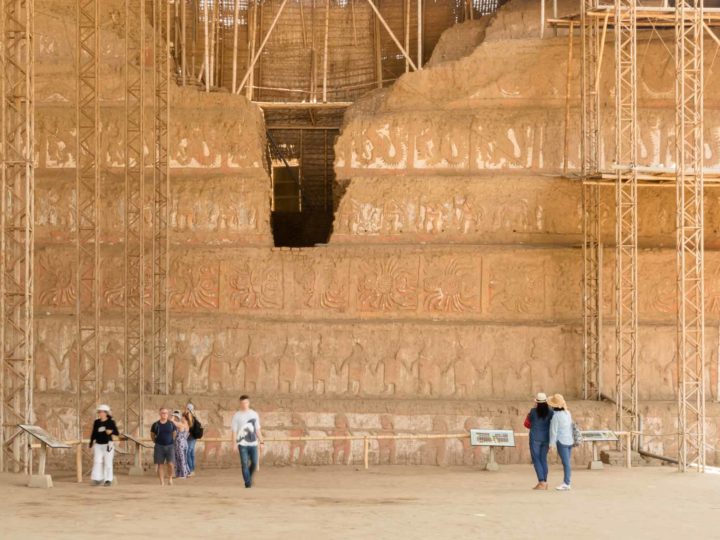
Spend half a day learning about Peru’s remarkable past by taking a bus to Chan Chan , an archeological site just five kilometers away from the city of Trujillo.
Chan Chan was once the capital of the Chimú Empire and is the largest adobe brick city discovered anywhere on earth, having been home to 60,000 people at its apogee around 850 AD.
At the heart of this city was a fortress where temples once paneled with gold, and courtyards and walls decorated with finely carved fish and other symbols of the sea can still be explored.
Another unmissable site to explore in the region is that of the Huacas de Moche . The two pyramids known as the Huaca del Sol and Huaca de la Luna date from 500 AD and are adorned with polychrome friezes, which have been remarkably well preserved and depict the sacrificial rituals with which the Mochica civilization has become associated.
Best explored by a tour from Trujillo, they’re an easy half-day trip from the city.
Alternatively, spend a day on a tour of the Complejo Archeólogico El Brujo (The El Brujo Archeological Complex), a series of small pyramids in which the mummified remains of the Señora de Cao, a shamanic leader, were discovered.
Her body – bearing tattoos of fish, snakes, and spiders – as well as gold and silver artifacts found within her tomb, are on display in the on-site museum.
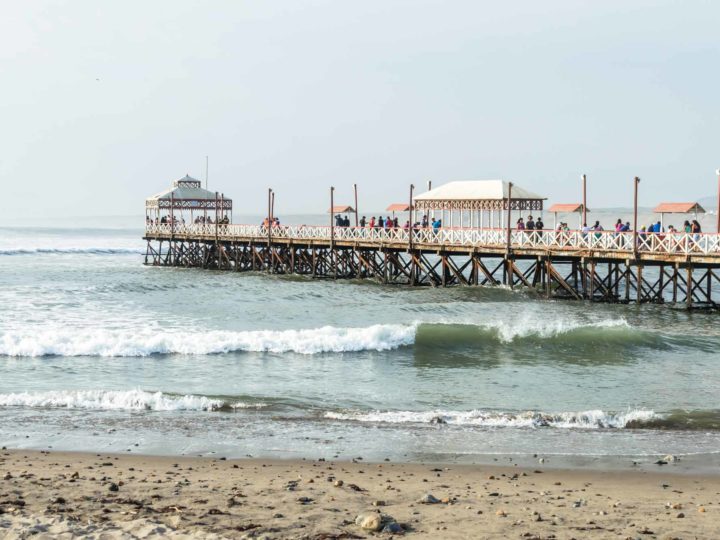
For a relaxing afternoon, consider dropping into Huanchaco , a beachside village a 45-minute bus journey north of Trujillo. Oozing buena onda (good vibes), it’s a great place to swim or surf. Read more about this Peruvian beach town in our complete guide to Huanchaco .
Where to stay in Trujillo: Located not far from the Plaza de Armas, Tierra Viva Trujillo ($100 USD double) might be located within a soulless tower block, but the hotel’s design and clean but chic bedrooms make up for this fact.
Where to stay in Huanchaco: Accommodation options abound, including the glorious tranquil yoga hostel, ATMA $7 USD dorm, $21 USD double), with cozy rooms and a very chilled vibe.
Days five and six: Cajamarca
Your next stop is Cajamarca , an historic Andean town sitting 2,750 meters (9,000 feet) above sea level and a six-hour bus journey east of Trujillo. Home to beautiful buildings constructed during the Spanish conquest, the city’s roots go much deeper.
Head to the El Cuarto del Rescato , the only remaining Inca building in the city and where the Inca emperor, Atahualpa, was captured and later executed by the Spanish and follow this with a trip to the Casa Museo Nicolás Puga, a privately owned museum showcasing 2,000-year-old textiles and other incredible pre-Hispanic treasures.
Adapting this itinerary: Want a more relaxing few days? Head north along the coast (10 hours by bus from Trujillo) for a few days of glorious beach time in Máncora, where the sun shines all year long, and the turquoise water temperature is pleasant for swimming and a popular destination to learn surfing or kitesurfing. A favorite among backpackers thanks to its wild nightlife, Máncora can be replaced with the neighboring surf enclave of Lobitos (1.5 hours south) or the tranquil – and pricey – luxury resorts of remote Las Pocitas. Try the truly remote bungalows at Yemaya ($126 USD double), which are right on the beach.
Spend a day outside of the city by taking a bus to the Ventanillas de Otuzco , a pre-Inca necropolis where the Cajamarca people were buried in holes cut into the volcanic rock. On your way back, visit the Baños del Inca, the Inca thermal baths that are still in use today for a relaxing soak.
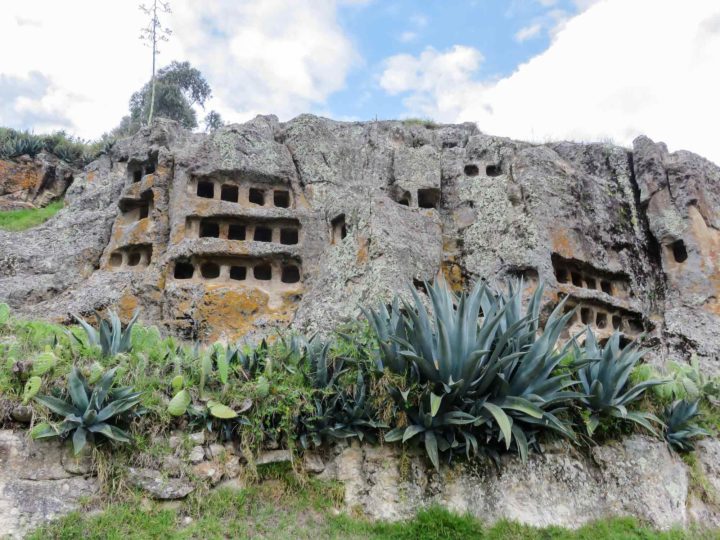
Bear in mind that the bus ride up the mountains is a rough drive, and you might prefer to fly instead – although it won’t save you a huge amount of time. All flights go via Lima (1.5 hours) before heading to Cajamara (1 hour 15 minutes).
Where to stay in Cajamarca: Just off the Plaza de Armas and with a beautiful, flower-filled courtyard, El Cabildo Hostal ($35 USD double) promises comfortable, if somewhat old-fashioned, accommodation.
Where to stay in Cajamarca on a budget: Extremely comfortable and with a location good for both the Plaza de Armas and the bus station, the family-run Chakra Runa Backpacker ($12 USD double) is guaranteed to offer a warm welcome.
Days eight, nine and ten: Chachapoyas
Deeper into the Andes is the market town of Chachapoyas . Getting here isn’t easy: the most direct route is a ten-hour minibus journey, through damp cloud forest and alongside steep mountainsides. Though surrounded by spectacular views, this route is not for the fainthearted.
With that said, Chachapoyas is worth visiting for one particular reason: Kuélap. This site is known as the Machu Picchu of Northern Peru thanks to its mountain-top location – accessible only via cable car, minibus, or a grueling four-hour hike – and the fact it’s the largest ancient stone structure in Peru. It also pre-dates Machu Picchu.
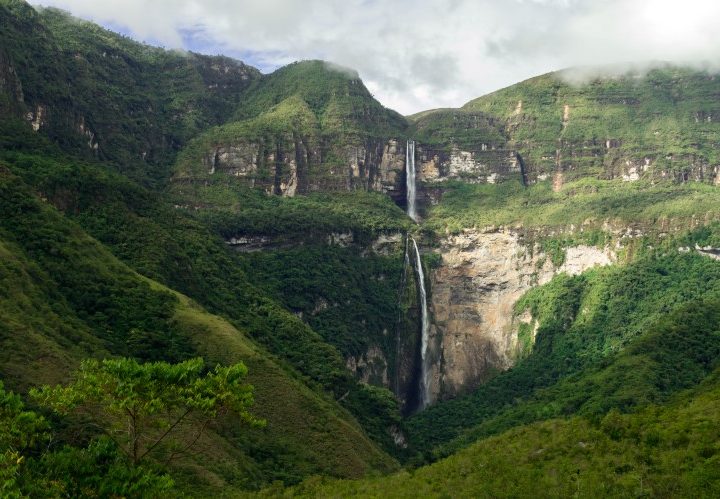
Read more about this magnificent fortress city in our guide to visiting the fortress of Kuélap , which is worthy of a full-day tour from Chachapoyas.
Spend the next few days exploring other key archeological sites, such as the row of ancient sarcophagi located on a wall at Karajía or dropping in at the Museo de Leymabamba , where 219 mummies from the Chachapoya people are on display.
Alternatively, take a bus to Cocachimba and hike to some of the tallest one-drop falls in the world, the dazzling Cataratas de Gocta (Gocta Waterfall).
Where to stay in Chachapoyas: The most luxurious lodgings in Chachapoyas are La Xalca Hotel ($100 USD), another colonial mansion with large, antique-furniture decorated bedrooms, some of which have pretty balconies overlooking the central courtyard and an extensive breakfast buffet. If you’re visiting in winter, ask for a room with carpet, not tiles.
Where to stay in Chachapoyas on a budget: The best budget option in town is Chachapoyas Backpackers Hostal ($22 USD), which has well-sized rooms, all with a private bathroom.
Take a flight with ATSA Airlines (only Monday, Thursday and Saturday; 1.5 hours) from Chachapoyas airport, or a minibus to Jaén (four hours) and a flight from there to Lima (1.5 hours).
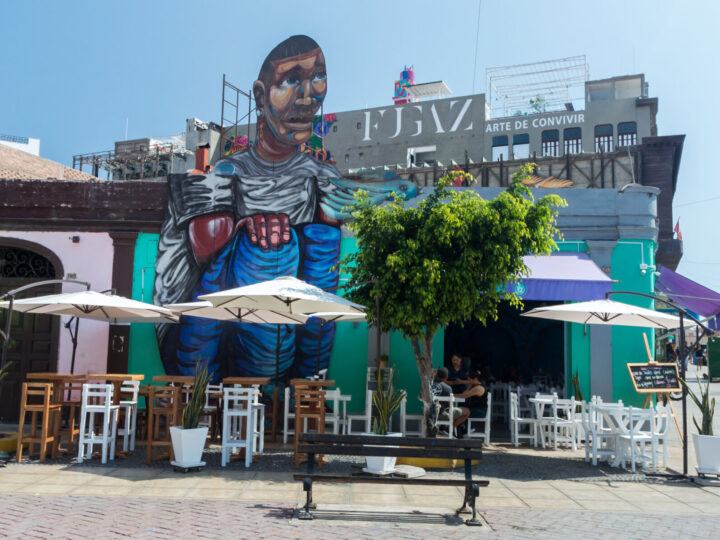
Spend the afternoon relaxing or catching up on any museums or restaurants you didn’t get a chance to visit on your first stay here.
Day Twelve: Pisco and Ballestas Islands
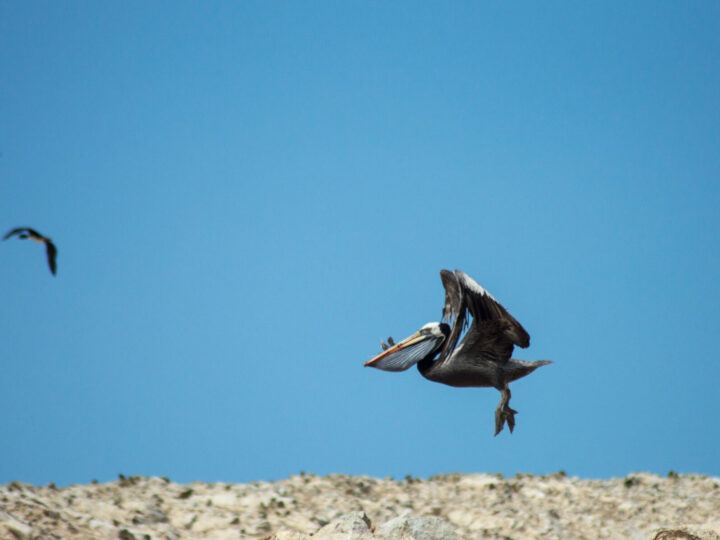
Stay overnight in Paracas, ready for an early bus the next morning.
Day thirteen: Nazca
Spend the remaining part of the day exploring Arequipa’s old town – the Monasterio de Santa Catalina, a vast and beautiful nunnery, and the seventeenth-century cathedral are two not to miss – before an evening tasting the lip-smacking rocoto relleno (stuffed spicy pepper), a traditional Arequipan dish.
For more highlights of the city, read this article about things to do in Arequipa and find out where you should stay in the White City .
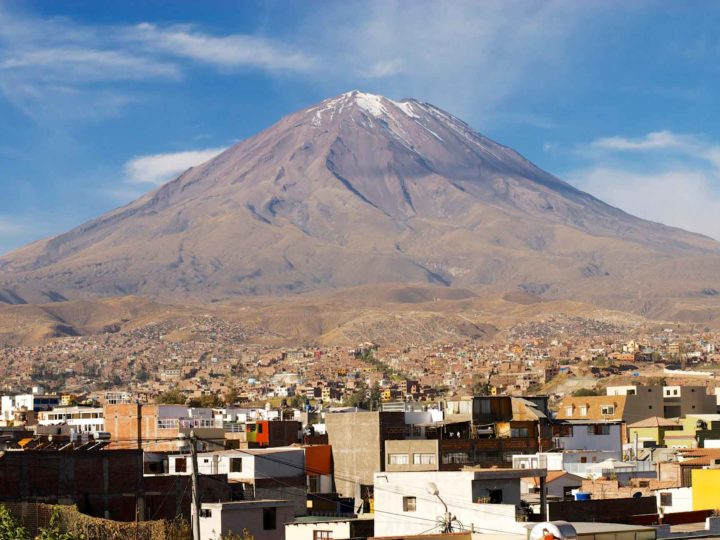
On the afternoon of day six, hop on a minivan to Chivay (3.5 hours) and then onto Cabanaconde (1.5 hours) and spend the night there in preparation for the Colca Canyon trek.
The next day, it’s time to embark upon the two-day Colca Canyon trek , which starts from Cabanaconde and heads down into the bottom of the canyon.
Return to Arequipa for a final night in the city before a bus to Puno the next morning.
Day eighteen and nineteen: Puno and Lake Titicaca
Hop on a six-hour bus that’ll promise fantastic views, especially when navigating the Salinas y Aguada Blanca Reserva Nacional, as it climbs further up into the Andes Mountains to arrive at what can seem to be the very top of the world.
At this high altitude of 3,800 meters (12,507 feet) lies Lago Titicaca, a vast lake covering more than 8,000 square kilometers and spit by the border between Peru and Bolivia. It’s Peru’s most impressive body of water – and one of the most scenic lakes in the whole of South America .
You’ll arrive in Puno , the gateway for all destinations in the Lake Titicaca area. Though small, this city houses accommodations catering to travellers.
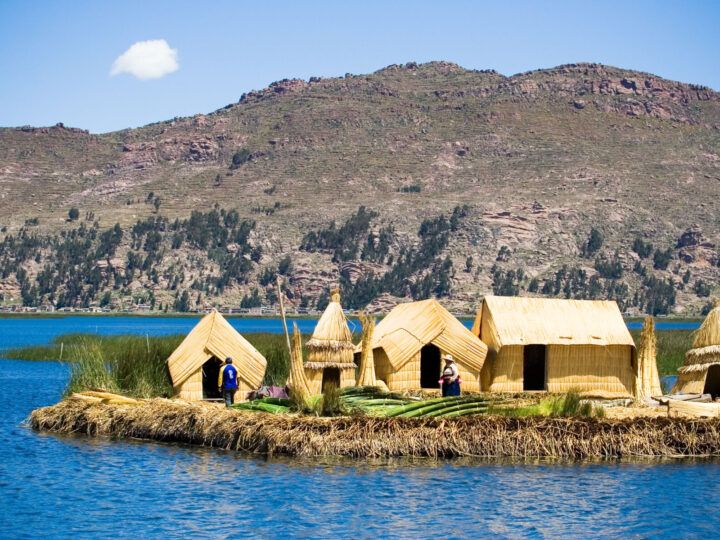
Several options for day trips from Puno are available, but the one to Uros Islands is a must. Comprising over 120 islands, this man-made archipelago is the focal point of Lake Titicaca. Also known as the Floating Islands, each of the islands is made of totora or reeds woven by hand.
You can now stay in a reed guesthouse on the islands – just bear in mind that your money won’t necessarily go to the families themselves. All Ways Travel is the only company I know who pay the communities directly and equitably.
Besides Uros, there are two main destinations on the Peruvian side of Lake Titicaca: Taquile and Amantani. Both are reachable by sailboat and have been inhabited for thousands of years.
Nowadays, they’re best known for their striking textile weaving and you can even spend a night here staying with a local family.
If you can, go further across to the Bolivian side to the Isla del Sol (Sun Island), which is crisscrossed with Inca archeological sites and promises, from every point on the island, spectacular views of Lake Titicaca.
Take your time exploring Lake Titicaca’s secluded corners before you move on to Cusco and Machu Picchu.
Where to stay in Puno: With a flower-filled courtyard and bedrooms tastefully decorated with art, you’ll feel a world away from the bustle of the city at Casa Panqarani ($40 USD double). It even has an excellent on-site restaurant.
Days twenty and twenty-one: Cusco and the Sacred Valley
You should be nice and acclimatized to altitude by now, but it’s still worth taking things easy by exploring the old town – the focal point of this city – on foot. Head to the Museo Inka (Inca Museum) to explore over 10,000 Inca artifacts including mummies and gold figurines, as well as the Museo de Arte Precolombino (Museum of Precolombian Art) to admire gold and silver ornaments, some of which date as far back as 1250 BC.
If you’re still feeling good, take the 15-minute walk uphill to the Sacsayhuaman site , a walled complex that served as both a temple and fortress for the Inca and has fantastic views of the city.
An easier alternative is a taxi ride from the city; expect to pay around S/10-25 ($2.5-6.3 USD), although the exact fare depends on which road is accessible on that day.
On your second day, it is time to explore the Sacred Valley , where the Urubamba River brings life to otherwise barren land. Take a colectivo (a public van), bus, or taxi from Cusco to the town of Pisac. The former is the cheapest and easiest option; you’ll find they leave every ten minutes or so from Puputi Street, and cost between S/4-10 ($1-2.5 USD).
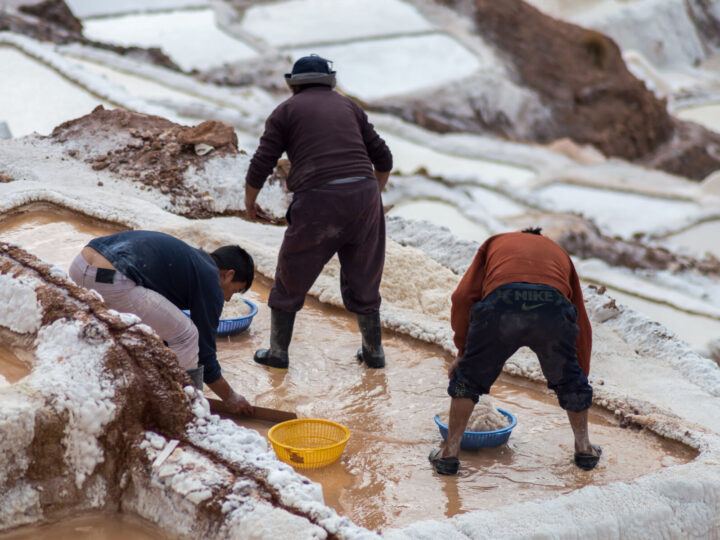
Pisac is a peaceful little town where you can hike (or take a taxi) to a magnificent Inca fortress that sits in the hills above. The views of the Sacred Valley from the site are mesmerizing.
Located only an hour away from Cusco and also home to a busy daily market (although it’s best visited on a Sunday), Pisac is one of the best day trips from Cusco.
Other great options in the Sacred Valley are Moray , a series of concentric circular stone terraces that were used for testing out growing crops in different conditions, as well as the Salinas de Maras (Maras salt pans), where local people have panned for salt for hundreds of years. You can take local transportation to get there, or book this tour that’ll take you to each.
Day twenty-two to twenty-five: The Inca Trail
The trails built by the Inca throughout the Andes were used to connect what was once a vast Empire to its territories across Peru and into neighboring Ecuador, Bolivia, and Chile.
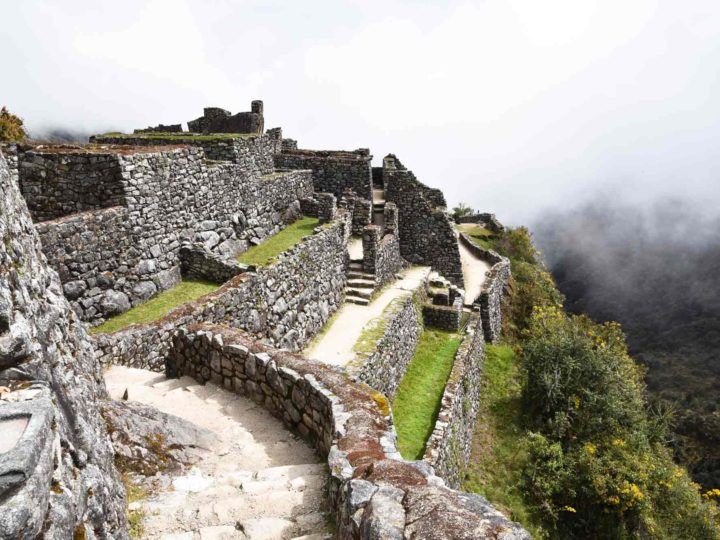
Hiking to Machu Picchu on this 40-kilometre (25-mile) trail generally takes four days and joining a guided tour is required. If you see three-day Machu Picchu tour operators, it is likely only for the fittest travellers, or the tour only includes part of the trail.
We recommend reading our extensive guide on what you need to know about hiking the Inca Trail before signing up for any tour; alternatively, if you want even more of a challenge, consider hiking the Salkantay trek instead .
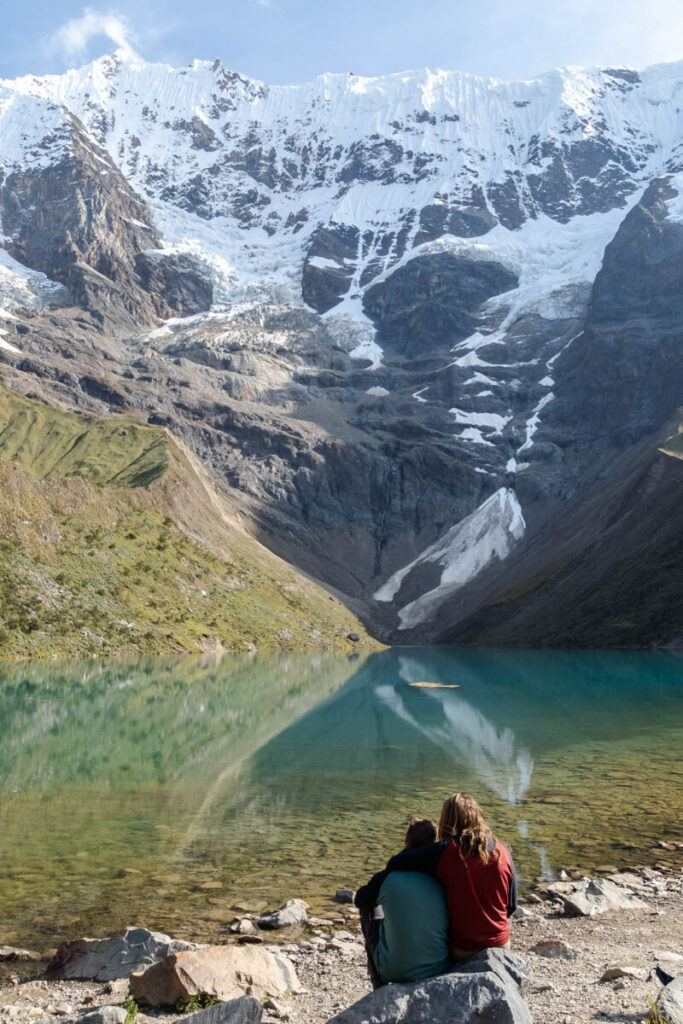
Want a cheeky 5% discount on the Inca trail or Salkantay trek?
Alpaca Expeditions are not only one of the most sustainable companies offering Salkantay and Inca trail treks to Machu Picchu, but their guides, porters and chefs are the ultimate hosts.
They’re now offering Worldly Adventurer readers a 5% discount on all of their hikes – just mention Worldly Adventurer when you enquire!
Depending on what time you get to town and your train schedule, you can either spend the night in Aguas Calientes or go directly back to Cusco.
Day twenty-seven to thirty: Puerto Maldonado
From Cusco, it’s a 45-minute flight to Puerto Maldonado , the last stop on your adventurous month in Peru.
Located at the confluence of the Tambopata and Madre de Dios rivers, Puerto Maldonado is unlike all the other regions you have explored so far: here we’re deep into the tropical rainforest, a place renowned for its rich, untouched wildlife and extremely comfortable eco-lodges, many of which are accessed solely by boat.
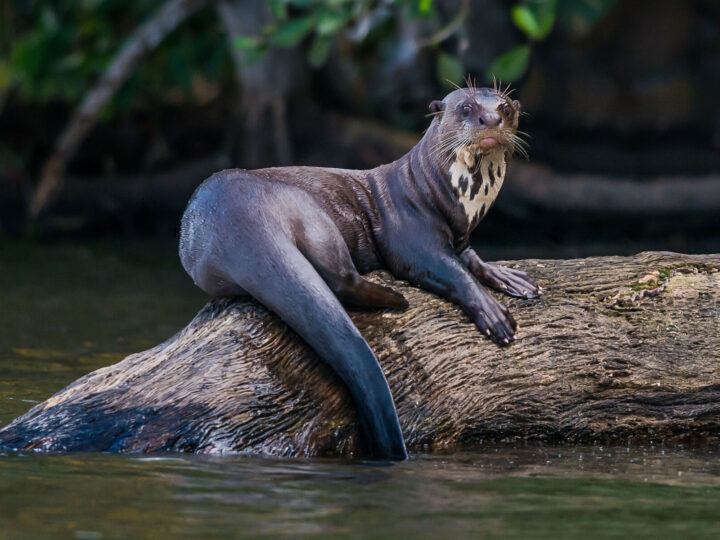
Book a three-night stay in an eco-lodge located in the hard-to-reach and strictly protected Reserva de la Biosfera del Manu (the Manu Biosphere Reserve) or in one of the cheaper lodges located in the Reserva Nacional Tambopata (TambopataNational Reserve) Wherever you stay, you can expect to spot numerous species of monkeys, caiman, capybara and, if you’re extremely lucky, giant otters.
At the end of your stay, return to Lima by plane (1.5 hours) and onto your flight back home.
Where to stay in and around Puerto Maldonado: Located in the Tambopata National Reserve, the fantastic Tambopata Research Center ($236 USD double) is the ultimate place to stay for piranha fishing, nocturnal hiking, birdwatching, ayahuasca rituals, and more.
FAQs about planning a Peru itinerary
How much does a trip to peru cost.
Excluding your flights in and out of Peru, budget travelers can keep their daily travel here below $30 USD per person. But if you plan on staying at hotels and eating at more expensive restaurants, you should budget around $50 USD per person per day. If you’re staying for two weeks in Peru, you’ll need at least $350 USD spending money for expenses outside of tickets and souvenirs.
What should you take to Peru?
Climates and weather conditions vary considerably across Peru, so your packing list will reflect this. Make sure you have light and comfortable hiking clothing, alongside a waterproof jacket for the Inca Trail and Machu Picchu.
Bring medication to help you deal with altitude sickness (and motion sickness if you plan on taking long bus rides), as well as sunblock and a wide-brim hat.
Comfortable hiking shoes, plus a pair of trainers for inside cities, are invaluable, while plenty of layers should keep you warm as you travel from the hot, humid coast up into the mountains. For more detailed information, check out our complete South America packing list .
How far is Lima from Machu Picchu?
Technically, it’s only around 500 kilometers away. But if you plan on getting to Machu Picchu from Lima by car or bus, the distance covers more than 1,000 kilometers, and it will take more than a day in a bus. The best way to reach Machu Picchu from Lima is by flying to Cusco and taking a train to Aguas Calientes.
How can you plan a trip to Machu Picchu?
Planning a trip to Machu Picchu depends on how you want to see this archeological site. If you’re wanting to hike the Inca Trail, you’ll need to book with a tour operator based in Cusco, who will organize your permits for food, porters, accommodation, meals, transportation to and from Cusco and permits for entry to Machu Picchu.
If you want to visit independently, you will need to purchase your own tickets for Machu Picchu via the government’s website . Note that you will need to decide at the point of purchase if you want to include Huayna Picchu, Machu Picchu mountain and the Museo de Sitio Manuel Chavez Ballon (an informative museum about the site located in Aguas Calientes, not Machu Picchu).
You will also need to book your own transportation to and from the site (either via train or minivan), as well as your overnight accommodation in Aguas Calientes. We recommend arriving the day before you visit Machu Picchu but booking an afternoon ticket; by 2pm, the skies should be clear if they’re cloudy in the morning, and most day trippers and Inca Trail hikers will have left by this point, leaving the site must quieter to explore.
What souvenirs should you bring back from Peru?
Peru offers many kinds of souvenirs. We recommend buying handmade Alpaca wool products, such as sweaters and hats. They are available at most local markets, but the best and cheapest ones are available at San Pedro Market, Cusco.
Thursday 28th of December 2023
Great itineraries! Curious what your suggestions would be for 3 weeks in Peru with kids ages 8-14? Any places that would *not* be good with kids? Thinking we'd just take the MP train and not the Inca trail. But would Puerto Maldonado be okay? Tour to Kuelap? Thanks!
Steph Dyson
Sunday 14th of January 2024
Hi Scott, I don't think any of those places wouldn't be good with kids. They're all interesting places to visit and I can't see why it would be an issue. Steph
World Travel Explorers
Sunday 12th of February 2023
Thanks for such a detailed guide and interesting itinerary. We're looking to go to Peru later this year and Cusco in particular sounds amazing.
Wednesday 8th of March 2023
Great - have a brilliant trip! Steph

1-Month Peru Travel Itinerary: Where to Go & What to See in Peru
Peru is one of those countries that I keep coming back to again and again. Part of the reason is that I have family there, but the other reason is that there is so much too see and experience. No matter how much time I spend in Peru – I’ve been there 3 times in the last 2 years alone! – I still keep finding new places to add to my bucket list .
Some travellers quickly skip through Peru only making time to visit Cuzco and Machu Picchu, but there is so much more to this country than Inca ruins. Today I’m going to share my 1-month Peru travel itinerary , which to be honest, I feel barely skims the surface and only touches on some of the country’s main highlights, but you have to start somewhere! Consider this travel itinerary an introduction to Peru and if you enjoy the country as much I do, then you can always plan a return and head into the more remote and harder to access regions. Now here’s a look at how to spend 1 month in Peru.
Peru Travel Itinerary

Let’s start in the capital, Lima, since that is where you’ll likely be flying into. Lima is the second most populous city in all of South America and it can be a bit overwhelming if you don’t know where to go. People will often tell you to skip it entirely and just continue on to Cuzco, but I like Lima and I think it has quite a bit to offer, so I’m going to try to convince you otherwise.
There are 3 neighbourhoods, which I think are great for first-time visitors: Miraflores, Barranco and Centro. Miraflores is located along the water and it is an affluent neighbourhood with seafront properties, beautiful parks and lots of great restaurants. Here you’ll want to visit El Parque del Amor , shop at the Hippie Fair in Parque Kennedy , and if you’re feeling brave you can even try paragliding .
Barranco has more of an artsy bohemian flair and it’s also known for its nightlife. In Barran, o you’ll want to enjoy all the street art , walk across the Bridge of Sighs , and pop into the various museums and art galleries .
Lastly, in Centro you can visit Plaza de Armas , tour the catacombs inside the San Fracisco Monastery , and watch the changing of the guard at the Presidential Palace . And that is just a quick introduction; you can read this other article for more ideas of things to do in Lima and this other one will give you ideas of easy weekend trips .
Now let’s move on to the food. Since Lima is on the coast, you’ll have to sample ceviche , a raw fish dish that has been cured in lime, and is served with corn, sweet potato, and red onions. It is delicious and a must try ! If you’re more adventurous, then go for anticuchos , which are grilled meat skewers (typically cow heart!) served with a side of corn. I know it sounds a bit strange, but it tastes just like steak.
Where I stayed:
I usually stay with family when I visit Lima, but regardless, I would recommend staying in the neighbourhood of Miraflores . Located right by the seaside, this is one of the nicest areas in the city, plus you also have easy access to Barranco and plenty of tours into the historic centre. There are plenty of hotels, hostels and guesthouses in this neighbourhood, plus AirBnB has a great range of properties, and if it’s your first time using it, you can get a $40 discount code here .

I would suggest spending at least 3-4 days in Cuzco since the first two days will likely be a write off depending on how well you handle altitude sickness . When you fly into Cuzco, it’s recommended that you spend your first day resting and that you follow that up with some light sightseeing on the second day. Some people aren’t affected by the altitude and can hit the ground running, but I’ve seen other people be standing one minute and then hit the ground like a sack of potatoes the next, so it’s better to take precautions.
Once you’ve been able to acclimate, it’s time to start exploring and luckily there’s plenty to see and do in Cuzco. Some of the main sights in Cuzco include: Qorikancha , the most important temple in the Inca Empire which was dedicated to the Sun God; Plaza de Armas , the main square where you’ll find Cuzco Cathedral; the Pre-Columbian Art Museum , which houses an art collection in a mansion-turned-convent; and the Inka Museum , which showcases gold-work, pottery, textiles, and even mummies.
For those with a bit of a sweet tooth, you may be interested in the ChocoMuseo , which covers the history of chocolate, and the Pisco Museum , which is a bar that offers pisco tastings.
Foodwise, the cuisine in Cuzco is quite different from what you’ll have experienced in Lima . We found the meals to be a lot heartier. Some traditional dishes you may want to sample include: chairo , a thick soup made with lamb and vegetables; alpaca skewers , very tender cuts of alpaca meat cooked over the grill; and guinea pig , which is usually served roasted (be prepared to get the whole animal on your plate!) Dishes feature a lot of potatoes, corn, and various root vegetables, and coca tea is a staple at every meal.
While in Cuzco I stayed at Tika Wasi , which is a boutique hotel that sits on the neighbourhood of San Blas overlooking the city. It was a peaceful setting with a cool courtyard and plenty of lounging space, and I also liked that each of the rooms had its own unique design. It was a 7-minute downhill walk into the town, and I feel like this helped us train for the Inca Trail!
Sacred Valley
Keep in mind that you can also take various day trips from Cuzco. Some of your options include: Maras Salinas , the famed terraced salt flats; Pisac , a small town known for its huge Sunday market; Ollantaytambo , the place where the Incas retreated after the Spanish seized Cuzco; and Moray , an agricultural laboratory known for its round terraces where the Incas were able to cultivate resistant varieties of plants high in the Andes. Alternatively, you could book yourself on a full-day tour of the Sacred Valley which hits some of these as well as other sites along the way. Whichever way you do it, the Sacred Valley is a place that you should definitely tack on to your Peru travel itinerary .

Inca Trail + Machu Picchu + Aguas Calientes
We did the 2-day Inca Trail to Machu Picchu and it was hands down one of the coolest adventures of our visit to Peru. Our first day involved a full day of hiking, and then the second day we had a guided half-day tour of Machu Picchu where our guide brought the city to life with his storytelling. We then had free time that afternoon, so Sam and I spent that time filming and taking pictures.
If you’re walking the Inca Trail or spending more than one day visiting Machu Picchu, then you’ll end up spending at least one night in the town of Aguas Calientes. If you’re feeling sore from all the hiking, you can enjoy a soak in the hot springs that give the town its name , or you could treat yourself to a massage. Alternatively, there are a few easy hikes from Aguas Calients, or you can shop for crafts and souvenir at Mercado Artesanal. Lastly, if you really want to treat yourself to a good meal, head straight to El Indio Feliz , which is run by a French cook who knows how to combine French and Peruvian cuisine to create a culinary masterpiece.
Where I stayed:
In Aguas Calientes, we stayed at Terrazas del Inca which sits right by the river. All I remember is that the hotel had really hot showers and a super comfortable mattress, which was greatly appreciated after all that hiking. They also had a really hearty breakfast, which we gladly gobbled at 4:30 in the morning before heading over to Machu Picchu.
I have to admit, Puno was not one of my favourite stops in Peru, however, if you want to do one of the overnight Lake Titicaca tours there’s really no other way around it. We ended up spending one night in the town before our tour and another night after. During that time we managed to visit the main square, shop along the pedestrian street, and eat at a few different restaurants. Here’s a look at what to pack for Lake Titicaca if you’re doing an overnight stay.
Where I stayed: After one awful night at Duque Inn, we checked ourselves into Hotel Hacienda Plaza de Armas which is located right on the main square and it was worth the small splurge. The rooms were very comfortable, the staff was incredibly helpful, and the location was much more central as opposed to the former property which was located up a very steep hill.

Lake Titicaca
When it comes to visiting Lake Titicaca , you can choose between a day tour or an overnight tour that includes a local homestay . The day tour only takes you as far as the reed islands which are settled by the Aymara, whereas the overnight tour takes you a bit further to some of the island communities settled by the Quechua.
We opted for the 2-day overnight tour (you can do longer ones) which took us to a total of 3 islands: Uros , Amantaní , and Taquile .
In Uros, we visited a reed island called Corazon del Lago , where we met the families who live there and learned about their daily life on a floating island. We had an interpreter with us the whole time, which allowed us to ask the types of questions that cross every visitor’s mind: Where are the bathrooms? How do you have electricity? Isn’t it dangerous for young children to live so close to the water? The answers: They now have outhouses. Solar panels have been installed. And children learn to swim at a very young age.
The second island we visited, Amantaní , was my favourite since we got to stay with a host family and this gave us a unique glimpse at their culture and way of life. Our host mom cooked us a delicious lunch, then we did some hiking in the afternoon, we later had a delicious dinner which was also prepared by our host mom, and after that, we were taken to the local community hall for some music and dancing.
On our final day, we hiked around Taquile , which is an island with UNESCO status for its “Masterpieces of the Oral and Intangible Heritage of Humanity”, namely handwoven textiles and knitting. It was also fascinating to watch our guide interpret the local dress for us; the way men wear their hats can indicate whether they are happy, sad, having an average day, single, married, or an authority figure in the community. That’s a lot of meaning based on the way you wear a hat!
During our tour, we stayed with a local family on the island of Amantaní. We booked our tour through All Ways Travel and once we met our guide, she gave us the option of doing a rustic homestay (no electricity and outhouses) or a more modern homestay (electricity and toilets with running water).

Paracas + Islas Ballestas
If you’re doing a big trip around South America but you don’t have time for the Galapagos Islands, Peru’s Islas Ballestas are often said to be the next best thing; and while they may lack the size and diversity of the Galapagos, the Peruvian islands are an important sanctuary for wildlife plus they do give you a chance to see animals in their natural habitat.
The boat trip from Paracas to Islas Ballestas is just 24 kilometres and it is 30 minutes each way with one hour of sightseeing in between. We got to see a lot of really cool animals including Humboldt penguins, sea lions, sunfish, pelicans, cormorants, terns and more.
If you suffer from motion sickness this may not be the best excursion for you since the waters can be a bit choppy, but otherwise, it’s a nice way to break up the journey down to Huacachina.

So I only visited Huacachina as a day trip , but once I got there I was wishing I had booked something longer since it’s such a cool destination. Huacachina is a tiny oasis in the middle of the desert; you have a green lagoon surrounded by palm trees, and around that you have a small village that only stretches a few streets back. The place has a very laid-back hippie vibe , and if you’re tired from your travels, this is a great place to just relax.
There are two main activities in Huacachina: sandboarding and dune buggy riding . We tried both. The steep dunes make this the perfect playground and it really felt like we were on a rollercoaster. We booked our tour through a hostel once we arrived in town, and we were out on the dunes within 10 minutes. Our driver also had boards in the buggy, so after tossing us up, down and around, he finally parked atop one of the steepest hills and let us try our hand at sand boarding. Apparently, sandboarding can be a little tricky if you don’t have any previous snowboarding experience, so I ended up sliding down headfirst on the board. Yes, it was terrifying, but it was also a blast!
If you’re looking for something a bit tamer, you can rent paddle boats to take out on the small lagoon, or you can hike up the dunes to watch a killer sunset.

If you’re already going to Huacachina, you may also want to consider adding a couple of days in Ica to your Peru travel itinerary . While Ica itself is far from being a beautiful city, the area is home to many vineyards and wineries , and once you’re in the outskirts of Ica it’s a whole different world. If you’re looking for a bit of a luxury weekend where you can unwind and relax , this may well be the place for you.
Sam and I booked ourselves in at Viñas Queirolo and we basically stayed on the premises all weekend. We went on a vineyard tour, attended wine tastings , and ate at the in-house restaurant which had some of the most beautiful plates of ceviche I have ever seen in my life.
We stayed at Viñas Queirolo , which is in the outskirts of Ica. It’s a beautiful property and well worth the splurge for a night or two.

Iquitos marked the start of our trip into the Peruvian Amazon, and again, while many people tend to skip over this city, I enjoyed having a few days to experience it. Here you can visit the stilt village of Belen , stroll along the promenade at sunset , enjoy the colonial architecture, or cool down with a drink at one of the many riverfront cafes on Malecon Maldonado . You can read the following article for some ideas of things to do in Iquitos .
Since Iquitos is in the heart of the jungle, the food is quite different from what you’ll have experienced along the coast or in the sierras. The majority of the dishes here feature fish, rice and tropical fruits. If you’re a foodie , you may want to sample: tacacho y cecina , roasted plantain balls served with a side of dry pork meat ; juane , a steamed dish made of rice and chicken cooked inside a giant leaf; and patarashca de paiche , a large freshwater fish which is steamed in a leaf.
While in Iquitos I stayed at the Epoca Hotel , which is a beautiful heritage property right on the shores of the Amazon. The hotel has a colonial hacienda feel with tall ceilings, iron balconies, and a beautiful tiled exterior. Also, the staff was incredibly friendly and helpful, so I can happily recommend them.

Our visit to the Amazon started out with a treehouse stay in the middle of the jungle . We booked 2 nights at the Treehouse Lodge, and it was one of the coolest experiences ever. When we weren’t hanging out in our cool treehouse, we were going on wildlife excursions , fishing for piranhas , or visiting local villages . If you’re adventurous and want to live up in the trees a la Jane and Tarzan, this is a cool experience to consider.
After our treehouse stay, we did a 4-day cruise on the Amazon River which saw us travelling up and down the mighty river. Once again, there were plenty of excursions to keep us busy. We went kayaking along the tributaries , did a canopy walk across a series of hanging bridges , and saw all sorts of wildlife . This was one of those lifelong bucket list experiences and a must add to your Peru travel itinerary!
I spent the first two nights at the Treehouse Lodge and from there I spent the next 3 nights aboard the Delfin I . If you’re thinking of doing both, I would suggest doing the treehouse stay first since it’s a more rustic experience, and then finishing things off with a the cruise since that offered a bit more pampering. Also, here’s a look at what to pack for your trip to the Amazon .
One month in Peru
So that brings us to a grand total of 28 days of travel around Peru . Tack on a few transportation days, including flying and out of the country, and you’ve got yourself a whole month dedicated to exploring some of the gems Peru has to offer. Like I mentioned earlier, I feel this itinerary barely scratches the surface and it only focuses on some of the better known destinations in the country, however, it does cover a mix of cities and rural areas , as well as destinations along the coast, sierras, and jungle. I hope this one month Peru travel itinerary will help whet your appetite and hopefully you’ll be back for more!
PIN ME FOR LATER!
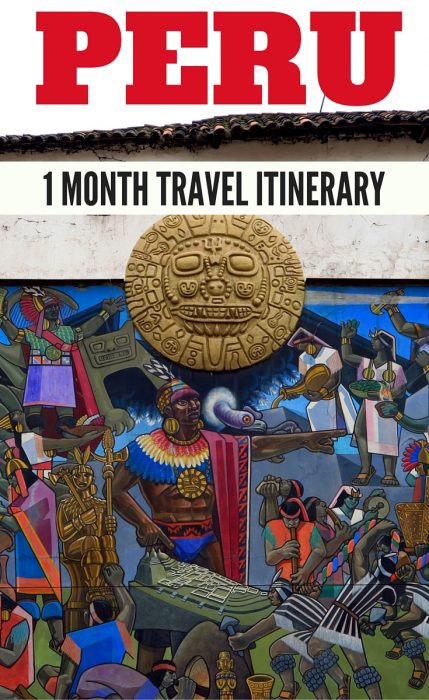
What are your favourite places in Peru? Any other destinations you’d add to this Peru travel itinerary?
14 Comments
Ica looks so beautiful!
I loved the winery in Ica! It’s such an easy weekend getaway and it’s quite the change from the city.
Seems like you saw a whole lot of Peru in just a month. You really had some incredible experiences; it’s no wonder a lot of travellers always want to get back to Peru again. I hope I’ll get to visit Peru too!
Wow! This is a packed itinerary… Peru is definitely on my list. 🙂
Looks like you had good weather for Machu Picchu — that would be my biggest concern!
I’ve always wanted to go to Peru. Do you think there’s enough there to keep children happy?
how much would u say 2 people will spend in peru if they wanna go for a month. it looks amazing, i would love to go to lima, cuzco, the amazon and see the north of peru i have heard the beaches are beautiful. do u have any idea?
How much money did you spend?
What was the estimated cost for this 1 month trip?
Hi Callie, It’s hard to give you an exact figure because this will all depend on your personal travel style. Will you be doing hotels or hostels, dining in restaurants or cooking for yourself, taking guided tours or exploring places on foot, etc. I would start off by looking at accommodations in your price range, and then you can decide what tours you’re most interested in and research the costs. Best, Audrey
We are hoping to travel Peru for a month next year for our honeymoon as this has been massively useful to us, thank you. I’ve done a bit of travelling myself and i always think its best to get opinions and recommendations from others.
Such a great article Audrey, I literally feel how much you love this place and amazing, that you’ve been there 3 times already! Must be special 🙂 Thanks for sharing all those tips with us, appreciate that!
Thanks for the great info about the different places, helped me a lot to plan my trip. I really loved the alternative tour to the rainbow mountains in Cusco, that I did on my last day in the city of the Incas haha. It was a lot better than the normal tour that almost everyone does because we left Cusco later (at 5:00am) so I could sleep a little longer, we only hiked for 45 minutes (instead of 3 hours) and we saw various rainbow mountains (not just 1)…and we also hiked through the red valley!! Just amazing 🙂 Did the tour with exploorperu, a local Peruvian travel company and they were great. I found out they have a article about the rainbow mountains, I’ll just leave it here for anyone interested (and hope you guys can visit it the next time you’re in Cusco) https://exploorperu.com/blogs/exploor-peru-travel-blog/discover-the-best-route-to-the-famous-rainbow-mountains-of-peru
How did you guys travel around? Did you rent a car or take the bus? I’ll be going for 3 weeks solo and am curious whether its cheaper to rent a car.
Hi Kiah, we did a combination of flights and overnight buses since the distances between these destinations are quite far. You could technically drive from Lima to Ica and Huacachina, but it’s so much easier to take the bus, especially considering what traffic in and around Lima is like.
Your email address will not be published. Required fields are marked *
Psychologist becomes first person in Peru to die by euthanasia after yearslong court fight

LIMA, Peru — A Peruvian psychologist who suffered from an incurable disease that weakened her muscles and had her confined to her bed for several years died by euthanasia, becoming the first person in the country to obtain the right to die with medical assistance, her lawyer said Monday.
Ana Estrada fought for years in Peruvian courts for the right to die with dignity, and became a celebrity in the conservative country where euthanasia and assisted suicide are illegal.
In 2022, Estrada was granted an exception by the nation’s Supreme Court, which upheld a ruling by a lower court that gave Estrada the right to decide when to end her life, and said that those who helped her would not be punished. Estrada became the first person to obtain the right to die with medical assistance in Peru.
“Ana’s struggle for her right to die with dignity has helped to educate thousands of Peruvians about this right and the importance of defending it,” her lawyer, Josefina Miró Quesada, said in a statement. “Her struggle transcended our nation’s borders.”
Estrada, 47, suffered from polymyositis, a disease that wastes away muscles and has no cure.
She began to present the first symptoms as a teenager and started to use a wheelchair at the age of 20 because she had lost the strength to walk.
Despite these obstacles, Estrada obtained a psychology degree and became a therapist. She earned enough money to buy her own apartment and became independent from her parents.
By 2017, however, Estrada’s condition worsened and she could no longer get up from her bed.
She had difficulty breathing and survived pneumonia. And even though she could not type, Estrada used transcription software to produce a blog called “Ana for a death with dignity,” where she discussed her struggles and her decision to seek euthanasia.
“I am no longer free,” she said in an interview with the Associated Press in 2018. “I am not the same person I was before.”
With the help of Peru’s Human Rights Ombudsman, Estrada won a lawsuit that gave her the right to die with euthanasia. From her bed, she participated in court sessions through video conferences.
Estrada told judges in 2022 that she valued life and did not want to die immediately, but wanted to have the freedom to decide when to end her life.
“I want to accede to euthanasia when I can no longer sustain suffering in life,” she said. “And when I decide to bid farewell to my loved ones in peace and with tranquility.”
Only a handful of countries have legalized euthanasia, including Canada, Belgium and Spain. Some U.S. states including Maine and Oregon allow physician-assisted suicide , where a doctor provides a terminally ill patient with the means to end life.
Euthanasia is illegal in most Latin American countries except for Colombia, which legalized it in 2015, and Ecuador, which decriminalized the practice in February .
The Associated Press
Judge orders preventative detention for Iranian and 2 Peruvians in thwarted plot to kill Israelis
LIMA, Peru — A Peruvian judge has ordered 18 months of preventative detention for an Iranian and two Peruvian men while they are investigated for allegedly attempting to kill two Israelis living in the South American country.
The ruling by Magistrate Miguel Quevedo was handed down Tuesday but released Wednesday. The defendants are also accused of conspiracy to commit terrorism.
The judge said the motive for the unsuccessful alleged killing plot was unclear, but police and prosecutors in Peru have said the Iranian, Majid Azizi, could be a member of the Quds Force of the Islamic Revolutionary Guard , which is responsible for intelligence work outside Iran.
The Associated Press could not independently confirm whether Azizi is a member of the Quds Force. Iranian authorities have not commented.
On March 15, after Azizi’s arrest, the Israeli embassy in Lima thanked the Peruvian police and prosecutor’s office in a press release “for having dismantled an Iranian attack that was directed against an Israeli citizen.”
Prosecutors in Peru have subsequently said that images, messages and testimonies were found indicating that Azizi contacted Peruvians Walter Loja and Ángelo Trucios in March to plan the killing of Israeli Shachar Malka.
Malka, who is alive, has said on social media that he has been working as a tour guide and healer with traditional plants in Cusco, the ancient capital of the Incas, for more than five years.
The other Israeli citizen who they allegedly planned to kill was Gilad Duchovny, who opened a cafe in Cusco in 2006 with his twin brother.
According to the judge, “it has been established with a high degree of plausibility” that Azizi conspired with the Peruvians to kill the Israelis. Police found information about Malka and Duchovny in Azizi’s Lima house. One of the Peruvians arrested, Trucios, has a conviction for murder and aggravated robbery.
Azizi’s defense has denied all the charges against him and says he suffers from a serious heart condition.
Peruvian authorities say Azizi entered Lima on March 3, and they were alerted about him by foreign intelligence offices.
Iran has run intelligence operations in South America in the past, particularly through the expeditionary Quds, or Jerusalem, Force of its paramilitary Revolutionary Guard.
Iran maintains close ties to Venezuela. The Quds Force was linked to an impounded Boeing 747 in Argentina and later seized by the United States. And most notoriously, Argentina believes Iran was behind the 1994 bombing of a Jewish center that killed 85 people.
This is the first time Peruvian authorities have announced the arrest of an alleged member of that group.

Donald Trump traveling to Wisconsin for first off-day rally from New York hush money trial

WASHINGTON – Former President Donald Trump is scheduled to visit Wisconsin next week in what is expected to be his first rally since his criminal trial began in New York this month.
Trump is scheduled to appear in Waukesha on Wednesday and plans to deliver remarks about 2 p.m. at the Waukesha County Expo Center, where he'll "contrast the peace, prosperity and security of his first term with Joe Biden’s failed presidency," his campaign said.
The planned rally is the first for Trump since the start of his hush money trial in Manhattan. The former president has spent most of the past two weeks in court, largely unable to campaign. He's accused of falsifying business records during his 2016 campaign to conceal an affair.
He previously scheduled a rally in North Carolina this past weekend, but it was canceled due to stormy weather. His Wisconsin visit will fall on a Wednesday — the one day a week he is typically not required to be in court.
Trump plans to hold a rally in Freeland, Mich., later in the day.
The former president held his first Wisconsin rally of the election cycle earlier this month, when he stopped in Green Bay . There, he attacked President Joe Biden over his handling of the U.S.-Mexico border — a key issue to his campaign.
“We’re going to end up with the largest deportation in America," Trump told the crowd in Green Bay of his plans if reelected. "I’m here to declare Biden’s border bloodbath … ends the day I take office. I will end the carnage."
On Wednesday, Trump is expected to again make the southern border a focal point. His campaign this week said Biden's border policies have "caused a crisis, with illegal immigrants and criminals funneling deadly drugs into Wisconsin communities."
Trump's visit to Wisconsin comes as President Joe Biden and his campaign have flooded the state over the last five months. Biden and his surrogates have made eight stops in the swing state since the start of the year. Biden was in Madison April 8 to unveiled a new student loan debt forgiveness plan.
Biden's campaign on Wednesday attacked Trump as having "nothing to offer but resentment and division."
“After spending the last few weeks dozing off and bragging about overturning Roe v. Wade, Donald Trump is visiting Waukesha next week in a desperate bid to do damage control on his record of ripping away women’s freedoms and encouraging thousands of rioters to try to violently overturn an election," the Biden campaign said in a statement.
The recent visits will not be the last for either candidate.
Wisconsin is one of just a handful of states that will decide the next presidential contest, and Biden and Trump are locked in a tight rematch of 2020. A Marquette University Law Poll released last week showed Trump leading Biden 51%-49% among both registered voters and likely voters.
Still, as Biden continues to campaign across the country, Trump has been in a Manhattan courtroom. And his trial could take several weeks.
"I should be in Georgia now. I should be Florida now," Trump said ahead of one recent court appearance. "I should be a lot of different places right now campaigning, and I'm sitting here. And this will go on for a long time."
’Don’t come out!' Viral video captures alligator paying visit to Florida neighborhood
It's alligator mating season, and gators are turning up everywhere in florida..

- Alligator mating season "officially" begins in May or June, but male alligators begin courting in early April
- Alligators may range up to several miles seeking mates and new habitats
A Florida woman was not terribly welcoming to her new neighbor: an alligator that was spotted wandering around her Fort Myers house and lurking under a car.
Siara Mercedes Grant told Storyful she got a heads-up about the new visitor on Thursday, April 18.
“I was cooking dinner when my neighbor called me to tell me there was an alligator outside of my house and to warn my husband, who would be coming home soon,” she said. "I opened the door to see where it was, and my husband yelled at me from the driveway, ’Don’t come out!’
Grant's husband videoed the gator, which she said was hiding under the neighbor's car before trying to knock open the door to another house.
“Then he started walking back to our house, so we ran inside before he did. Then he stayed outside our door for a while before he kept going on his merry way,” Grant said.
Professional alligator wranglers came the next day to remove the reptile.
Alligator season is coming in Florida
Gators are turning up everywhere as alligator mating season approaches, during which the gators that are chased out of their habitats by stronger ones wander around looking for new places to live and find mates. This month alone, alligators have been spotted in a Bonita Springs neighborhood , attacking a man walking his dogs in Naples , getting stuck in a kitchen in Venice , on a golf course and more.
What do I do if I see an alligator?
Do not attempt to capture an alligator yourself, and it's against the law to shoot at them . If you encounter an alligator you think will be a threat to people, pets or property, call the FWC’s Nuisance Alligator Hotline at 1‐866‐FWC‐GATOR (392‐4286) or visit myfwc.com .
The FWC’s Statewide Nuisance Alligator Program (SNAP) uses contracted nuisance alligator trappers throughout the state to remove alligators 4 feet in length or greater that are believed to pose a threat.

- High contrast
- About UNICEF
- Where we work
- Explore careers
- Working in emergencies
- Diversity and inclusion
- Leadership recruitment
- Support UNICEF
- Search jobs
- Candidate login
Search UNICEF
Unv youth advocates programme: applications now open, the talent programme by unicef and unv aims at empowering young people, including youth with disabilities, to become agents of change.

UNICEF has launched the UNV Youth Advocates programme , an initiative to recruit talent in partnership with United Nations Volunteers (UNV) . We aim at empowering young people , including youth with disabilities, to become agents of change and champion children's rights.
Click here to go to the video | Click here to go to the assignments

The UNV Youth Advocates
After the success of the first initiative in 2018 - 2019, which mobilized 42 Youth Advocates (18-24 years old) in 27 countries, UNICEF, in partnership with UNV, is now looking for the second cohort. We are searching for 20 young, passionate, and skilled advocates to join us and become agents of change advocating for the protection of children’s rights.
The UNV Youth Advocates Programme offers young people the chance to gain one-year professional experience through a National UN Volunteer (UNV) assignment with UNICEF , while also imparting their valuable insights into the organization's work for children and young people.
The recruited UNV Youth Advocates will have access to learning and professional development opportunities, including a suite of online learning programmes.
Young professionals with disabilities and from under-represented groups are especially encouraged to apply.
If you are 18-35 years of age and passionate about children´s rights, check out the assignment opportunities listed below.
Click here to go to the assignments
Listen to what Joyranig, Jean Junior, and Rediet,
UN Youth Volunteers at UNICEF have to say about their experience
and why they think you should join too.
Youth Advocates Assignments
Take note of the closing date for applications. Assignments are removed on the application closing date. Click on the country you are interested in to go to the assignment.
Disability Inclusion Assistant - UNICEF Iran

Related topics
More to explore, volunteer programme.
Volunteer with UNICEF and help us reach every child in need
The stories of our UN Volunteers in the State of Palestine
Our UN Volunteers in the State of Palestine create a better world for everyone, while growing in their career to reach their potential
UNICEF Volunteers advancing gender equality
On International Women's Day, we celebrate our UNICEF Volunteers who are empowering girls in their communities and around the world
Supporting Career Development of UN Volunteers serving at UN
UNICEF and UNV partnered to launch Career Development Webinars for UN Volunteers serving at UNICEF

IMAGES
COMMENTS
October is the last month of the dry season or the first month of the rainy season. The weather can be unpredictable. It's the best time to visit Peru before the full force of the rains hit the highlands and the Amazon, so head to the mountains or to the jungle to make the most of the October weather. Towards the end of October when rain is ...
Peru weather in September through November. The other shoulder season lands in the months of September, October and November, when temperatures across the country start to increase and tourist numbers decrease - making this one of the best times to visit Peru. Rainfall is a possibility in Cusco in October and November, although these months ...
December to February is the best time for beach lovers. This is the season to see Peru's magnificent beaches at their best. Sunbathing on the searingly warm northern beaches is delightful - temperatures routinely hover in the 30°C to 40°C (86°F to 104°F) realm, and crowds flock to see-and-be-seen resorts like trendy Máncora.
The best time to visit Peru is during the dry season between May and October, especially if you plan to go on a trek. It is a wonderful time, with sunny days and bright blue skies, but early booking is crucial because it's the peak season. Visitors will notice more rain between November and April, with the wettest months being January and ...
MIGUEL MEJIA CASTRO/Getty Images. Peru's tourism seasons fall into three main categories: High Season: May to August. Shoulder Season: March and April, September and October. Low Season ...
Temperatures average around 25 °C years round, and humidity is always high. June to October is the dry season and is the best time to visit the Peruvian rainforest for trekking. If you want to cruise down the Amazon, the best time to visit is actually the wet season, as the rains cause the river to swell.
Fiesta de las Cruces (May 3rd) September-October is one of the better times to visit the coastal region. The crowds aren't here yet, but the weather is just starting to warm up before summer. It's a good time to stroll along the boardwalk and try out sports such as hang-gliding.
The dry season is the busiest time of year in Peru for tourism, so to avoid crowds try to travel during the rainy season or during the shoulder months in April and November. Article Sources TripSavvy uses only high-quality, trusted sources, including peer-reviewed studies, to support the facts within our articles.
Recap: The best time to visit Peru. So, as we have seen earlier in this article, in general terms the best time to visit Peru is the shoulder season.. However keep in mind, the best time to visit Peru for weather is anytime between May and October.The best time to travel to Peru to save money is during the rainy season, particularly January or February. ...
Best months to visit Peru. It's challenging to choose the best time to visit Peru because of the change in the weather across regions. January is the best month for a trip to the coast for fantastic weather, while May to September is the ideal period for visiting the Andes, Machu Picchu and the Amazon when it's driest. Since you're unlikely to find the best time to visit all areas on a ...
Machu Picchu and the Inca Trail during the dry season: from May to September. The dry season is the best time to visit Machu Picchu, as trail conditions are easier and you're also less likely to have an overcast day when you reach the site. Temperatures range between 17°C (62°F) and 19°C (66°F) and, because the wet season has nourished ...
While there is no bad time to visit Peru, there is a best time to visit Peru! If aiming to visit all three regions during your Peru adventure, the best months to visit Peru are April or May. You'll have better chances of good weather on the coast, clear skies in the Andes, and more boat excursions (vs. walking excursions) in the Amazon.
The best time to visit Peru is between May to October for the dry season. Although this time of year looks different for each geographical area of Peru, it is generally categorized by sunny, dry and clear weather, perfect for trekking, exploring or sightseeing. If you're looking for an action-packed expedition through the higher regions, this ...
Temperatures range between 27°C/81°F during the day and 17°C/64°F at night. April: One of the best months to visit Machu Picchu, with warmer weather and fewer crowds. Ideal for hiking the Inca Trail or alternative treks. Temperatures range from 22°C/77°F during the day and 14°C/61°F at night.
A handy guide to Peru's seasons. While Machu Picchu and Lima are generally considered the best places to visit in Peru, there numerous other destinations that are worth a visit, if you travel during the right season.. The dry season from May to September is recommended as the best time to visit Peru.Temperatures range from 60°F to 85°F (16°C to 27°C), which is especially ideal for those ...
Visiting Peru in the Summer- December to March (Peru's Rainy Season) The rainy season is actually the warmest time in Peru, as well as being the wettest season. With frequent rainfall in the highlands and the jungle, some of the major trails for travelers close because of this, including most of the Machu Picchu treks, like the Salkantay trek.
Also, the whole coastline of Peru is good to visit during these months, which includes the Nazca Lines, Paracas and Ica, and Peru's archaeological sites in the north around Trujillo and Chiclayo. Additionally, Peru's Amazon region is a year-round destination the main difference being high or low water season.
Visiting from May through September will give you the most flexibility in your itinerary and the best chance of enjoying drier weather, especially if you plan to visit Machu Picchu. We'd recommend visiting Peru during the month of September if you plan to see Machu Picchu.
Unsurprisingly then, the best time to travel to the highlands of Peru is between May and September, the driest months of the year. The Amazon Rainforest Typically warm and humid all year, the Amazon's temperatures range between 25°C (77°F) and 30°C (86°F).
Travel off-season - For a low-cost trip, the best times to visit Peru are the fringe months of April and May or September and October. Prices are usually cheaper during these months. Take the colectivos - These are cheap buses that cost around 2-10 PEN for a ride. They are a bit confusing as they don't necessarily have a schedule, but ...
10 days in Peru. Overview of this 10-day Peru trip planner: Days one through three: Cusco and the Sacred Valley. Days four through seven: The Inca Trail. Day eight: Machu Picchu. Days nine and ten: Lima. 10 days in Peru is the perfect length of a trip that allows you to add the Inca Trail to your Machu Picchu trip.
Alternatively, you could book yourself on a full-day tour of the Sacred Valley which hits some of these as well as other sites along the way. Whichever way you do it, the Sacred Valley is a place that you should definitely tack on to your Peru travel itinerary. Inca Trail + Machu Picchu + Aguas Calientes. 3 days.
The Best of Peru: One Month Adventure! It's impossible to see everything that a country has to offer in a limited amount of time. In truth, exploring the must-see sights and hidden treasures of Peru could take years! ... Trujillo - Plaza de Armas, Peru. Stop 3: Huaraz - Get High! Travel inland a bit to the world's second-highest ...
Ana Estrada, who suffered from an incurable disease that had her confined to her bed for several years, became the first person in the country to die by euthanasia, her lawyer said Monday.
LIMA, Peru — A Peruvian judge has ordered 18 months of preventative detention for an Iranian and two Peruvian men while they are investigated for allegedly attempting to kill two Israelis living ...
The Biden campaign plans to continue using TikTok to reach voters and spread its message even after the president signed legislation that could lead to a ban on the popular app several months down ...
Trump's visit to Wisconsin comes as President Joe Biden and his campaign have flooded the state over the last five months. Biden and his surrogates have made eight stops in the swing state since ...
If you encounter an alligator you think will be a threat to people, pets or property, call the FWC's Nuisance Alligator Hotline at 1‐866‐FWC‐GATOR (392‐4286) or visit myfwc.com.
The UNV Youth Advocates. After the success of the first initiative in 2018 - 2019, which mobilized 42 Youth Advocates (18-24 years old) in 27 countries, UNICEF, in partnership with UNV, is now looking for the second cohort.We are searching for 20 young, passionate, and skilled advocates to join us and become agents of change advocating for the protection of children's rights.
The Biden campaign is going after Republicans who voted for former U.N. Ambassador Nikki Haley after the former presidential candidate received more than 150,000 votes in Tuesday's GOP primary ...